Corning Optical Communication VE-WIMAX-25E VE WiMAX 2.5 GHz DISTRIBUTED ANTENNA SYSTEM User Manual
Corning Optical Communication Wireless VE WiMAX 2.5 GHz DISTRIBUTED ANTENNA SYSTEM Users Manual
Users Manual

MobileAccessVE WiMAX
Instant Coverage Solution
User Manual
PN: 709C004001
REV: A01
Date: FEB 2010

Preface Material
III MobileAccessVE WiMAX Instant Coverage Solution User Manual
Preface Material
© Copyright 2010, MobileAccess Networks Inc. All Rights Reserved.
This document contains confidential and proprietary information of MobileAccess and may not be copied, transmitted,
stored in a retrieval system or reproduced in any format or media, in whole or in part, without the prior written consent of
MobileAccess. Information contained in this document supersedes any previous manuals, guides, specifications, data
sheets or other information that may have been provided or made available to the user.
This document is provided for informational purposes only, and MobileAccess does not warrant or guarantee the
accuracy, adequacy, quality, validity, completeness or suitability for any purpose of the information contained in this
document. MobileAccess reserves the right to make updates, improvements and enhancements to this document and the
products to which it relates at any time without prior notice to the user. MOBILEACCESS MAKES NO WARRANTIES,
EXPRESS OR IMPLIED, INCLUDING, WITHOUT LIMITATION, THOSE OF MERCHANTABILITY AND FITNESS FOR A
PARTICULAR PURPOSE, WITH RESPECT TO THIS DOCUMENT OR ANY INFORMATION CONTAINED HEREIN.
Policy for Warrantee and Repair
MobileAccess tests and inspects all its products to verify their quality and reliability. MobileAccess uses every reasonable
precaution to ensure that each unit meets their declared specifications before shipment. Customers should advise their
incoming inspection, assembly, and test personnel about the precautions required in handling and testing our products.
Many of these precautions can be found in this manual.
The products are covered by the following warranties:
General Warranty
MobileAccess warrants to the original purchaser all standard products sold by MobileAccess to be free of defects in
material and workmanship for one (1) year from date of shipment from MobileAccess. During the warranty period,
MobileAccess will repair or replace any product that MobileAccess proves to be defective. This warranty does not apply to
any product that has been subject to alteration, abuse, improper installation or application, accident, electrical or
environmental over-stress, negligence in use, storage, transportation or handling.
Specific Product Warranty Instructions
All MobileAccess products are warranted against defects in workmanship, materials and construction, and to no further
extent. Any claim for repair or replacement of units found to be defective on incoming inspection by a customer must be
made within 30 days of receipt of shipment, or within 30 days of discovery of a defect within the warranty period.
This warranty is the only warranty made by MobileAccess and is in lieu of all other warranties, expressed or implied.
MobileAccess sales agents or representatives are not authorized to make commitments on warranty returns.

Preface Material
IV MobileAccessVE WiMAX Instant Coverage Solution User Manual
Returns
In the event that it is necessary to return any product against above warranty, the following procedure shall be followed:
1. Return authorization is to be received from MobileAccess prior to returning any unit. Advise MobileAccess of the model,
serial number, and discrepancy. The unit may then be forwarded to MobileAccess, transportation prepaid. Devices
returned collect or without authorization may not be accepted.
2. Prior to repair, MobileAccess will advise the customer of our test results and any charges for repairing customer-caused
problems or out-of-warranty conditions etc.
3. Repaired products are warranted for the balance of the original warranty period, or at least 90 days from date of
shipment.
Limitations of Liabilities
MobileAccess's liability on any claim, of any kind, including negligence for any loss or damage arising from, connected
with, or resulting from the purchase order, contract, quotation, or from the performance or breach thereof, or from the
design, manufacture, sale, delivery, installation, inspection, operation or use of any equipment covered by or furnished
under this contact, shall in no case exceed the purchase price of the device which gives rise to the claim.
EXCEPT AS EXPRESSLY PROVIDED HEREIN, MOBILEACCESS MAKES NO WARRANTY, EXPRESSED OR IMPLIED, WITH
RESPECT TO ANY GOODS, PARTS AND SERVICES PROVIDED IN CONNECTION WITH THIS AGREEMENT INCLUDING,
BUT NOT LIMITED TO, THE IMPLIED WARRANTIES OF MERCHANTABILITY AND FITNESS FOR A PARTICULAR PURPOSE.
MOBILEACCESS SHALL NOT BE LIABLE FOR ANY OTHER DAMAGE INCLUDING, BUT NOT LIMITED TO, INDIRECT,
SPECIAL OR CONSEQUENTIAL DAMAGES ARISING OUT OF OR IN CONNECTION WITH FURNISHING OF GOODS, PARTS
AND SERVICE HEREUNDER, OR THE PERFORMANCE, USE OF, OR INABILITY TO USE THE GOODS, PARTS AND SERVICE.
Reporting Defects
The units were inspected before shipment and found to be free of mechanical and electrical defects.
Examine the units for any damage that may have been caused in transit. If damage is discovered, file a claim with the
freight carrier immediately. Notify MobileAccess as soon as possible.
NOTE: Keep all packing material until you have completed the inspection
Safety Warnings
To comply with FCC RF exposure compliance requirement, adhere to the following warnings:
Warning! The Access Pod with its built-in antenna must be installed with a separation distance of at least 20cm from all
persons and must not be located in conjunction with any other antenna.
Warning! The outside antenna must be installed with a separation of at least 20cm from all persons and must not be
located in conjunction with any other antenna.
Warning! Use of this Access Pod with antennas other than those illustrated could be hazardous. Before using other
antennas, contact Mobileaccess Support.
Caution: Double pole/neutral fusing (two fuses in the appliance inlet)
Approved Antennas for use with the MobileAccessVE Solution
The gain of external antennas connected to the VAPs should not exceed 10 dBi.
Compliance with RF Safety Requirements
MobileAccess products have no inherent significant RF radiation.
The RF level on the down link is very low at the downlink ports. Therefore, there is no dangerous RF radiation when the
antenna is not connected.

Preface Material
MobileAccessVE WiMAX Instant Coverage Solution User Manual V
Certification and Compliance to Standards
Category
Standards
Safety:
IEC 60950-1: 2003; UL-60950-1:2003; CAN/CSA – C22.2 No 60950-1-03
EMC:
EN 301489-8 V1.2.1:2002; EN 301489-1 V1.5.1:2004; EN 61000 V4.6:2005
EN 55022 V4.2:2001 / FCC Part 15; VCCI Class A for VCU and Class B for VAP
Radio:
FCC Part 27 ;EN 302 544
SAR:
EN 50385; FCC OET-65
ISO:
ISO 9001: 2000 and ISO 13485: 2003

Preface Material
VI MobileAccessVE WiMAX Instant Coverage Solution User Manual
About This Guide
This guide provides essential product functionality with all the information necessary to proper
installation and configuration of the MobileAccessVE WiMAX system.
List of Acronyms
Term
Meaning
MIMO
Multi Input- Multi Output
PoE
Power Over Ethernet
PSE
Power Sourcing Equipment
SISO
Single Input-Single Output
SME
Small / Medium Enterprise
STP
Shielded Twisted Pair
UTP
Unshielded Twisted Pair
VAP
VE Access Pod
VCU
VE Control Unit
WiMAX
Worldwide Interoperability for Microwave Access

VII MobileAccessVE WiMAX Instant Coverage Solution User Manual
Table of Contents
1 Overview ............................................................................................................................. 1
1.1 System Architecture ..................................................................................................................... 2
1.2 System Elements ......................................................................................................................... 4
1.2.1 VE Control Unit (VCU) ......................................................................................................... 4
1.2.1.1 VCU Front Panel ..................................................................................................... 5
1.2.1.2 VCU Rear Panel ...................................................................................................... 7
1.2.2 VE Access Pod (VAP) .......................................................................................................... 8
1.2.2.1 VAP Antenna Options.............................................................................................. 9
1.3 System Monitoring and Management........................................................................................... 10
1.3.1 Integration with an External Fault Management System ...................................................... 10
1.4 Overview of the Installation Procedure ........................................................................................ 11
2 Infrastructure Requirements and Layout Planning ........................................................ 12
2.1 Summary of Unit Locations and Connections ............................................................................... 13
2.2 Infrastructure Requirements ....................................................................................................... 13
2.3 Coverage and Installation Planning ............................................................................................. 15
2.3.1 Types of Environment ....................................................................................................... 15
2.3.1.1 Open environment ................................................................................................ 16
2.3.1.2 Standard Environment .......................................................................................... 16
2.3.1.3 Dense Environment .............................................................................................. 16
2.3.1.4 Combination of Environments ............................................................................... 16
2.4 Planning VAP Layout .................................................................................................................. 17
2.4.1 RF Coverage Factors ......................................................................................................... 17
2.4.2 Mapping Locations ............................................................................................................ 17
2.4.3 Connecting Directional Antennas ....................................................................................... 17
2.4.4 Installation Plan Example .................................................................................................. 18
3 VCU Unit Installation and Configuration ........................................................................ 20
3.1 Installation Kit Contents ............................................................................................................. 21
3.2 Installing Master VCU ................................................................................................................. 22
3.3 Auxiliary Alarm Output Connections ............................................................................................ 23
3.4 Installing Slave VCU ................................................................................................................... 24
3.4.1 Connecting VAP Ethernet Cables ....................................................................................... 25
3.4.2 Operation with LAN utilizing Power over Ethernet (PoE) ...................................................... 26

Contents
VIII MobileAccessVE WiMAX Instant Coverage Solution User Manual
3.5 Provisioning the Master VCU ....................................................................................................... 27
3.5.1 Configuring the Computer IP Parameters ........................................................................... 27
3.5.2 Login ............................................................................................................................... 28
3.5.3 IP Settings ....................................................................................................................... 30
3.5.4 Assigning Identifying Information ...................................................................................... 31
3.5.5 Setting RF Parameters ...................................................................................................... 32
3.5.6 Verifying System Operation ............................................................................................... 34
3.6 Assigning the Slave VCU an Identifiable Name ............................................................................. 37
4 VAP Installation and Provisioning .................................................................................. 38
4.1 VAP Installation ......................................................................................................................... 38
4.1.1 VAP Kit Contents .............................................................................................................. 38
4.1.2 VAP Locations and Mounting ............................................................................................. 39
4.1.2.1 Desk Mount ......................................................................................................... 39
4.1.2.2 Wall Mount .......................................................................................................... 40
4.2 Verifying VAP Coverage Area ...................................................................................................... 40
4.3 Provisioning the VAPs ................................................................................................................. 40
4.3.1 Verifying Normal VAP Operation ........................................................................................ 41
4.3.2 Naming the VAP ............................................................................................................... 42
4.3.3 Configuring VAP for External Antenna ................................................................................ 43
5 Navigating the Web Access Application ........................................................................ 44
5.1 Opening a Session and Authentication Levels .............................................................................. 44
5.2 About the MobileAccessVE Web Access Window........................................................................... 45
5.3 Configuration Tab ...................................................................................................................... 46
5.3.1 Network Topology Tree .................................................................................................... 47
5.3.2 Management Tab ............................................................................................................. 48
6 VCU Monitoring and Configuration ................................................................................. 49
6.1 Viewing VCU General Information ............................................................................................... 49
6.2 Viewing VCU Alarms ................................................................................................................... 50
6.3 Master VCU RF Parameters ......................................................................................................... 52
7 VAP Monitoring and Configuration ................................................................................. 53
7.1 Viewing VAP General Information ............................................................................................... 53
7.2 Viewing VAP Alarms ................................................................................................................... 54
7.3 VAP RF Parameters .................................................................................................................... 55

Contents
MobileAccessVE WiMAX Instant Coverage Solution User Manual IX
8 Administrative Operations............................................................................................... 56
8.1 Changing Password .................................................................................................................... 56
8.2 IP settings ................................................................................................................................. 57
8.3 SNMP Configuration Parameters ................................................................................................. 58
8.4 Upgrading (or Downgrading) VCU and VAP Software ................................................................... 59
8.4.1 Upgrading the VCU SW ..................................................................................................... 60
8.4.2 Upgrading the VAP SW ..................................................................................................... 61
9 Troubleshooting ............................................................................................................... 63
9.1 Finding a Specific VAP in the Building .......................................................................................... 63
9.2 Wireless Service is Not Available ................................................................................................. 65
9.3 PoE is Not Working .................................................................................................................... 65
9.4 Ethernet service is degraded....................................................................................................... 66
9.5 No Service from Connected Access Pod ....................................................................................... 66
9.6 VCU Cannot be Monitored via SNMP ............................................................................................ 68
Appendices ............................................................................................................................. 69
Traps ............................................................................................................................................... 69
MobileAccessVE Control Unit Traps ............................................................................................. 69
MobileAccessVE Access Pod Traps .............................................................................................. 69
VE Connections in Central Ethernet Source Topologies ........................................................................ 70
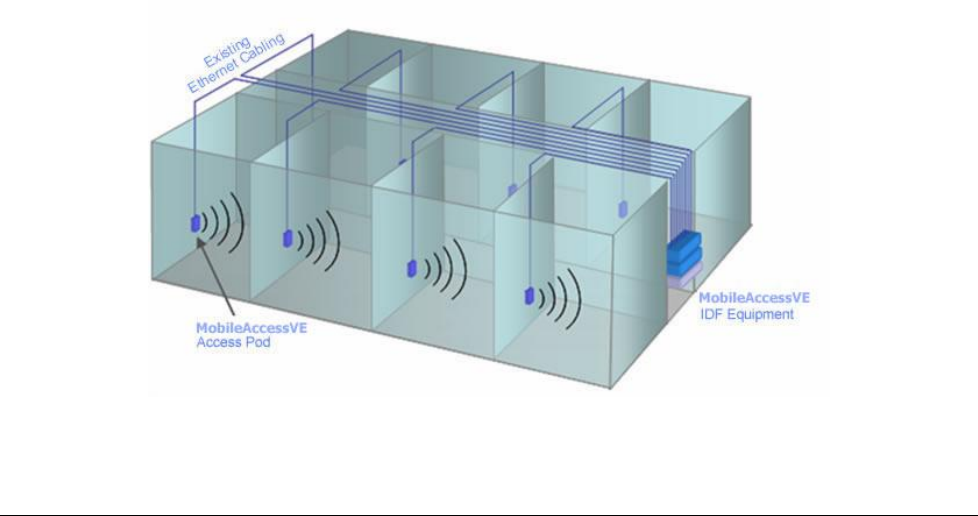
MobileAccessVE WiMAX Instant Coverage Solution User Manual 1
1 Overview
MobileAccessVE WiMAX solution provides enhanced, cost effective in-building WiMAX coverage
for enterprise environment. This solution is quickly and simply deployed using the existing cable
infrastructure to provide instant MIMO or SISO WiMAX coverage without requiring the
installation of new cables and without affecting existing LAN services. MobileAccessVE minimizes
disruption while providing a scalable and flexible solution at a significantly lower total installation
cost.
The VE solution distributes WiMAX wireless service from the service provider‟s equipment and
Ethernet services from the corporate LAN, to Access Pods installed throughout the enterprise.
The Access Pods distribute the WiMAX services via integrated internal antennas (or external
antennas for additional coverage optimization), and also provide Ethernet connectivity to the
LAN terminals. The MobileAccessVE solution seamlessly coexists with the Enterprise LAN and
does not consume LAN capacity.
The VAPs are distributed on each floor and plug into standard Ethernet jacks already installed at
the enterprise site. They are powered via PoE technology and managed via a VE Control Unit
(VCU) located in the floor‟s communication shaft for site coverage that requires more than one
VCU (each VCU supports up to 12 VAPs), several VCUs (up to 12) can be aggregated under a
single VCU serving as Master. The Master VCU provides the interface to the capacity sources
(the service provider‟s equipment) and for management of all units.
This enhanced WiMAX coverage solution can be easily and quickly installed with minimal
disturbance to the enterprise. In less than a few hours, with no additional cables required, a
scalable and flexible solution is provided at a significantly lower total installation cost.
The following figures illustrate
single-tier
and
multi-tier
VE installations.
In a single-tier installation, the VCU is connected to the service provider‟s equipment and to the
Ethernet switch and distributes Ethernet and WiMAX services to up to 12 VAPs distributed over
one more adjacent floors.
Figure 1-1. Single Tier MobileAccessVE Installation
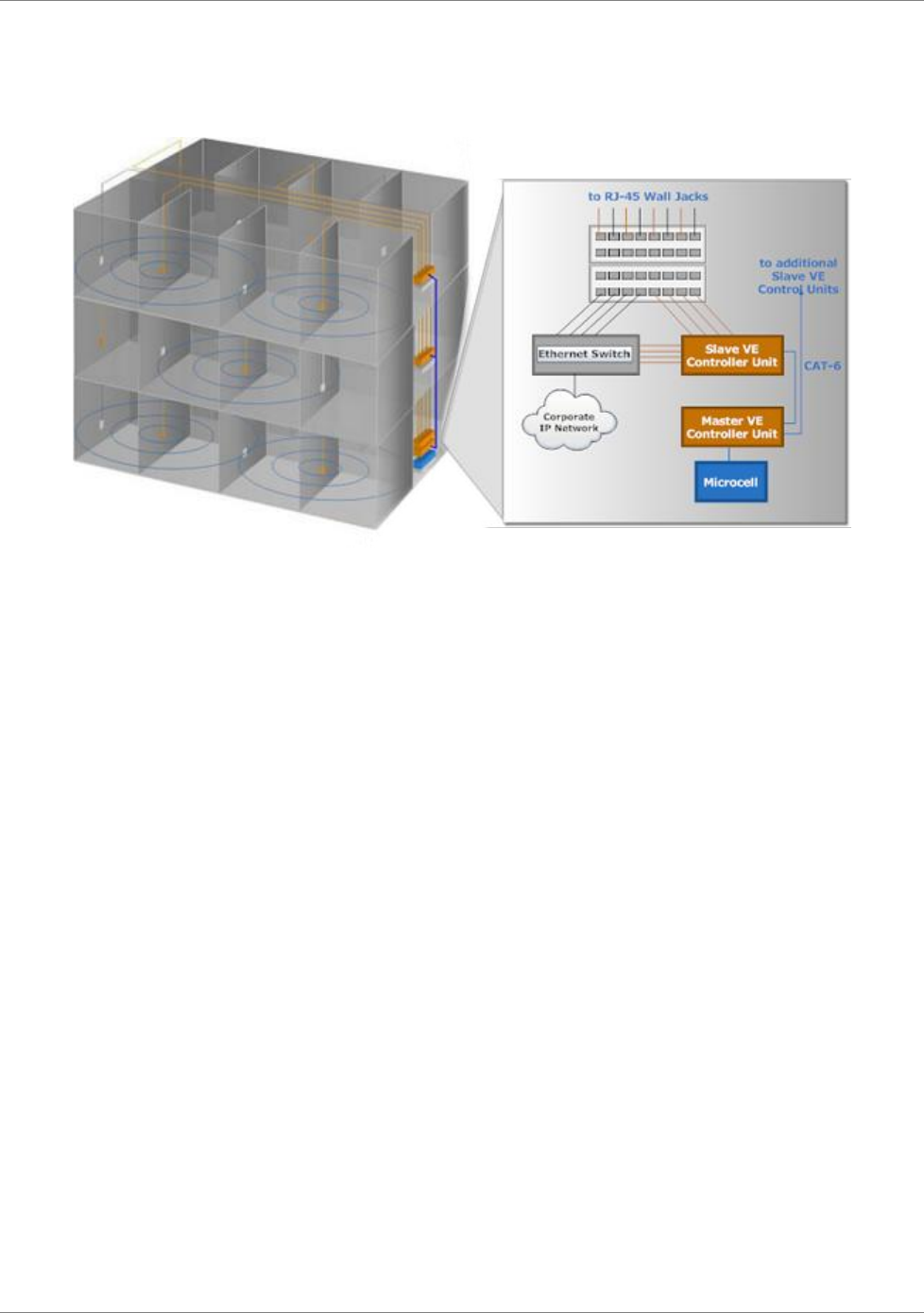
System Architecture
2 MobileAccessVE WiMAX Instant Coverage Solution User Manual
Multi-tier installation includes the Master VCU that supports up to twelve Slave VCUs. In this type
of installation the provider‟s services are fed to the Master VCU through which the Slave VCUs
are controlled and managed.
Figure 1-2. Multi Tier MobileAccessVE Installation
1.1 System Architecture
Main elements - The MobileAccessVE solution is based on the following main elements:
VE Control Unit (VCU) – Control Unit that can serve either as a Master or a Slave and
interfaces the other VCUs (in case of Master) or the VAPs (when serving as Slave). The
Master or Slave mode is automatically detected according to the VCU's physical connection.
If a connection to another VCU is detected the VCU will be identified as a Slave; otherwise it
will assume the role of a Master.
Master VE Control Unit (Master VCU) – installed in the main communication (IDF)
closet, interfaces to the WiMAX BS and Ethernet switch and provides secure, central
management to (up to twelve) VCUs and all connected VAPs. VAPs can also be
connected to the Master VCU.
Slave VE Control Unit (Slave VCU) – installed telco/IDF closet. Used to expand
coverage to additional floors. Each VCU interfaces the Master VCU and up to twelve
VAPs and twelve Ethernet connections.
The Slave VCUs distribute WiMAX MIMO or SISO signals to each VAP along with PoE and
Ethernet signals from the Ethernet switch, throughout the existing CAT-5e infrastructure.
The Slave VCUs are connected to the Master VCU using CAT-6 or CAT-7 cables.
VAP (VE Access Pod)
– These are pluggable antennas distributed at strategic locations on
the floor to provide maximum WiMAX coverage. VAPs provide RF coverage via integrated,
internal antennas. VAPs are also equipped with interfaces for external antennas that can be
used for special coverage requirements. VAPs are remotely powered from the VCU using
Power over Ethernet (PoE) – no local power required.
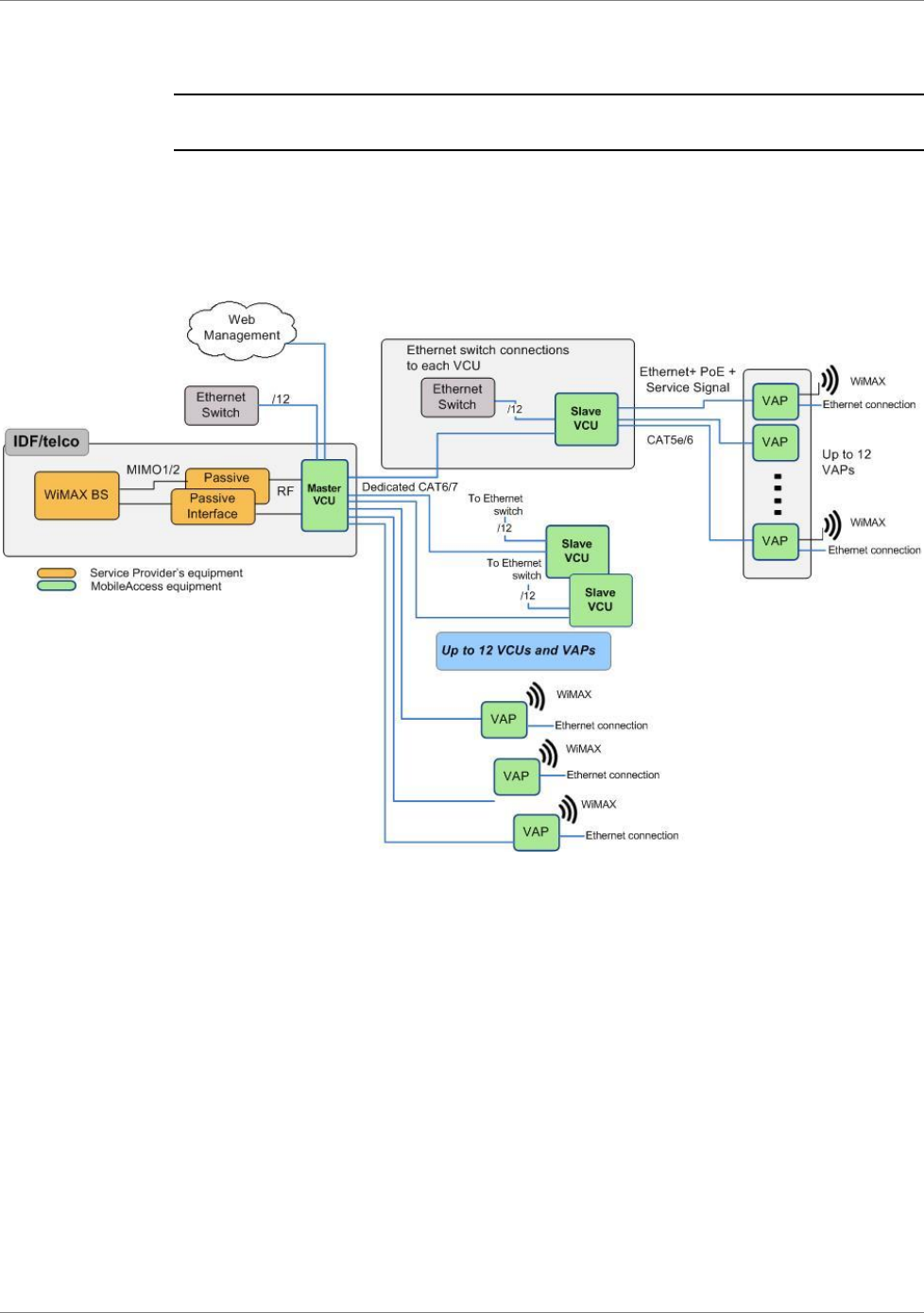
Overview
MobileAccessVE WiMAX Instant Coverage Solution User Manual 3
Up to twelve VAPs can be connected to a single VCU using LAN cables (CAT-5e or higher).
Note: When the total number of VAPs in the deployment exceeds 72 VAPs, consult with
MobileAccess support.
The following figure shows the MobileAccessVE solution architecture (multi-tier).
Figure 1-3. MobileAccessVE Basic Architecture
The Master VCU distributes the converged WiMAX services from the service provider‟s equipment
to the Slave VCUs. At the Slave VCUs, the wireless services are converged with Ethernet service
and routed to the VAPs via the Ethernet LAN CAT-5e/6 cabling infrastructure.
The VAPs distribute the WiMAX services via integrated internal antennas or external antennas
and provide Ethernet connectivity to the LAN terminals.

System Elements
4 MobileAccessVE WiMAX Instant Coverage Solution User Manual
1.2 System Elements
This chapter describes the interfaces of the VE Control Units and Access Pods.
1.2.1 VE Control Unit (VCU)
Capabilities and interfaces
The VE Control Unit can operate as a Master VCU, managing up to twelve slave VCUs and/or
VAPs, OR as a Slave VCU connected to up to twelve VAPs
While operating as a Master VCU:
Interfaces to WiMAX BS, Ethernet switch, slave VCUs and (optionally) to VAPs.
Converges WiMAX, Ethernet and PoE and interfaces to VAPs/VCUs.
VAPs and Slave VCUs management and control
Remote management of the entire deployment
While operating as a Slave VCU:
Interfaces to Master VCU
Converges Wireless services, Ethernet and PoE and interfaces to VAPs
Management and control of connected VAPs
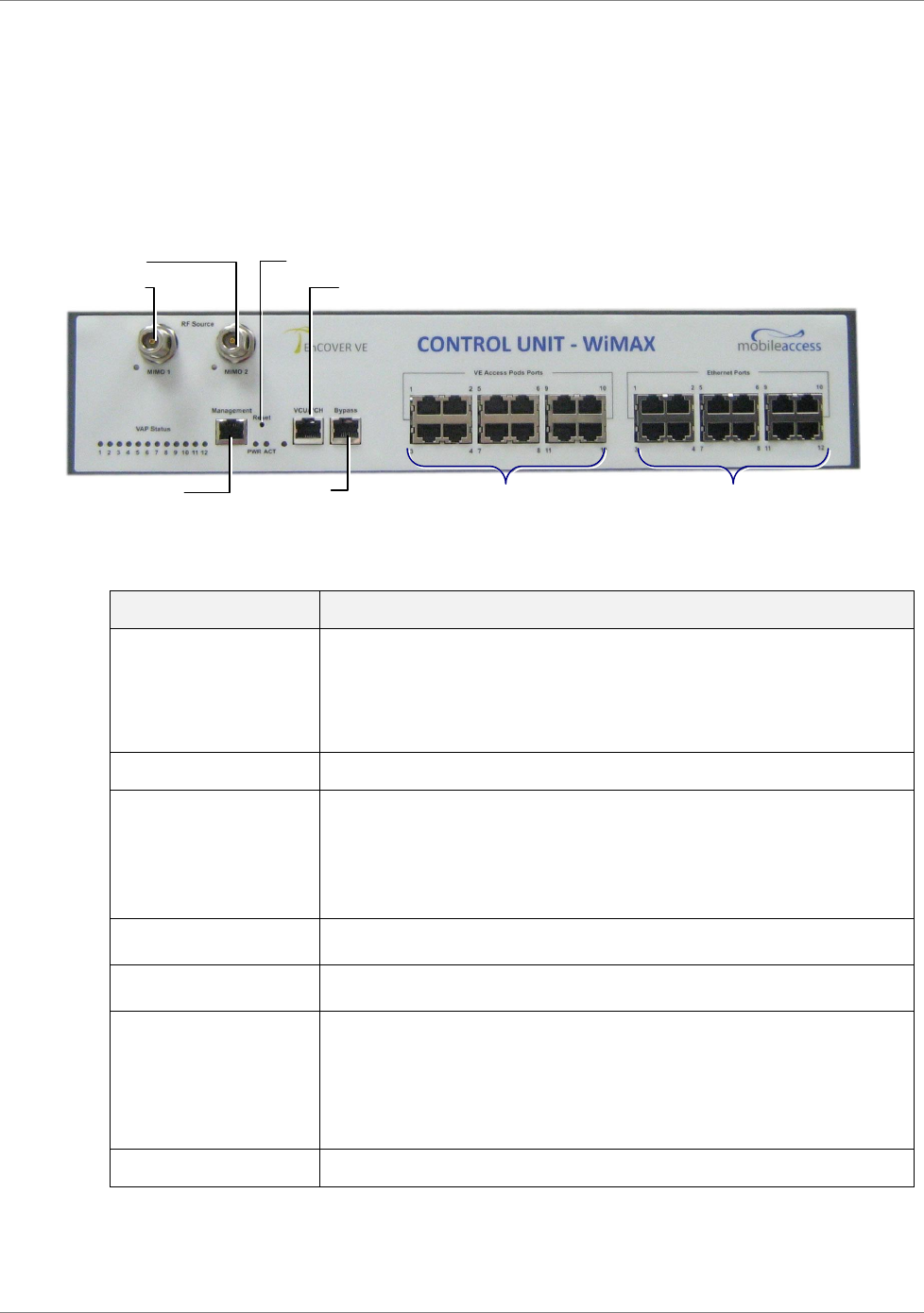
Overview
MobileAccessVE WiMAX Instant Coverage Solution User Manual 5
1.2.1.1 VCU Front Panel
The front panel includes the connections to two WiMAX MIMO channels (when supporting SISO
service – only MIMO 1 connector is relevant), interfaces to VAPs and to other VCUs according
to the configuration, and to management.
This section describes the front panel interfaces and LEDs.
Figure 1-4. VCU Front Panel Ports
Table
1-1: VCU Ports Description
Ports
Description
MIMO1
MIMO2
RF connections (two TDD MIMO channels) to the service provider
WiMAX BS equipment. Coax cables.
Note: When supporting SISO service – only MIMO 1 connector is
relevant.
Management
RJ45 WEB management connection.
VE Access Pod Ports
1-4; 5-8; 7-12
VAP/VCU port connections. RJ-45 connection to VAP/VCU through
the LAN infrastructure. CAT-5e/6 cables.
If VCU is connected as Master – these are connections to the Slave
VCUs (and optionally also to VAPs).
If VCU is connected as Slave – these are connections to VAPs.
Ethernet Ports 1-4; 5-
8; 7-12
Ethernet port connections to Ethernet Switch. Ethernet cables.
VCU/VCH
Used for connecting a Slave VCU to the Master VCU in a multi-tier
deployment (connects to one of the VAP ports of the Master VCU).
Bypass
Relevant for Slave controllers in topologies in which the connection
to the Master VCU is also used to transport Ethernet signals to the
switch – the Ethernet signals are separated from the WiMAX signals
and flow through the Bypass port to the switch.
See the Appendix - VE Connections in Central Ethernet Source
Topologies for more information.
Reset
N/A in current version
Reset
Management
MIMO1
MIMO2
Ethernet Ports 1-4; 5-8; 7-12
VAP Ports 1-4; 5-8; 7-12
VCU/VCH Port
Bypass
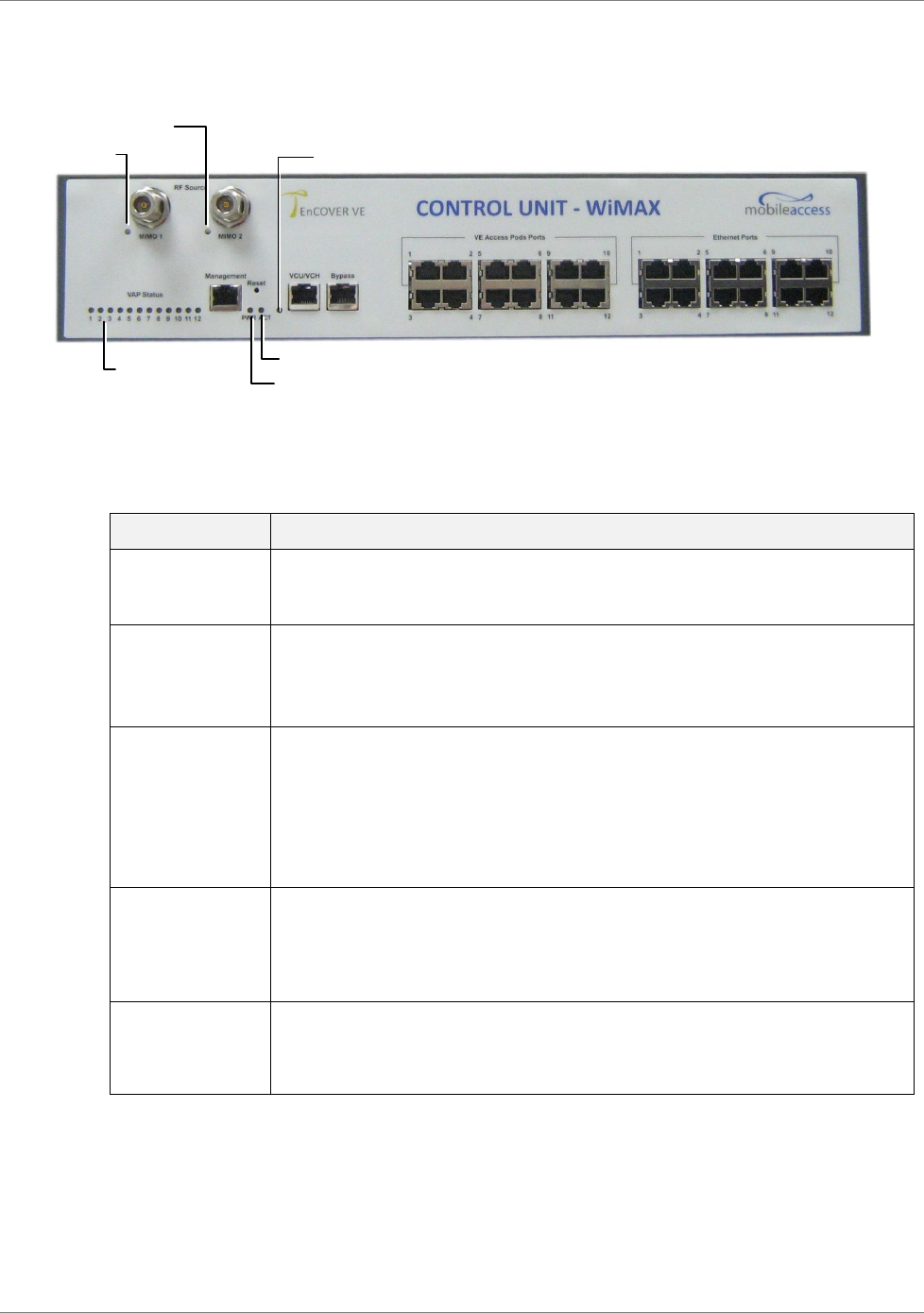
System Elements
6 MobileAccessVE WiMAX Instant Coverage Solution User Manual
The front panel LEDs are described below.
Figure 1-5. VCU Front Panel LEDs
Table
1-2: VCU LEDs Description
LED
Description
PWR
Indicates whether the VCU receives power:
Green - Power OK
Disabled - No power received by VCU
ACT
VCU activity LED:
Solid Green – During initialization
Blinking Green – Normal system operation
Fast Blinking Green – User activated
VCU Identify
on this VCU
VAP Status (one
LED per port)
Indicates the status of the
corresponding
unit (VAP or VCU)
Blinking Green – Unit is initializing
Solid Green – Normal operation of unit
Solid Orange – Unit is faulty, or unmanaged. This can be due to
mismatch type, VoIP phone, etc.
Fast Blinking Green – User invoked “Identify” command on the unit
Off – No VAP or VCU connected to this port.
RF (one LED per
Channel)
Indicates the status of connected RF capacity source:
Green – Master VCU only. Normal RF level
Orange – Master VCU only. RF level is either too low, too
high, or service has been turned off by the user.
Off – VCU is Slave.
VCU/VCH
Indicates the status of the connection to the Master VCU:
Off – Master mode (not connected to VCU)
Blinking Green – During Attachment process with Master VCU
Solid green – Slave (IF-IF) mode and connected to Master
VAP Status LEDs
PWR LED
ACT
VCU/VCH LED
MIMO1 LED
MIMO2 LED
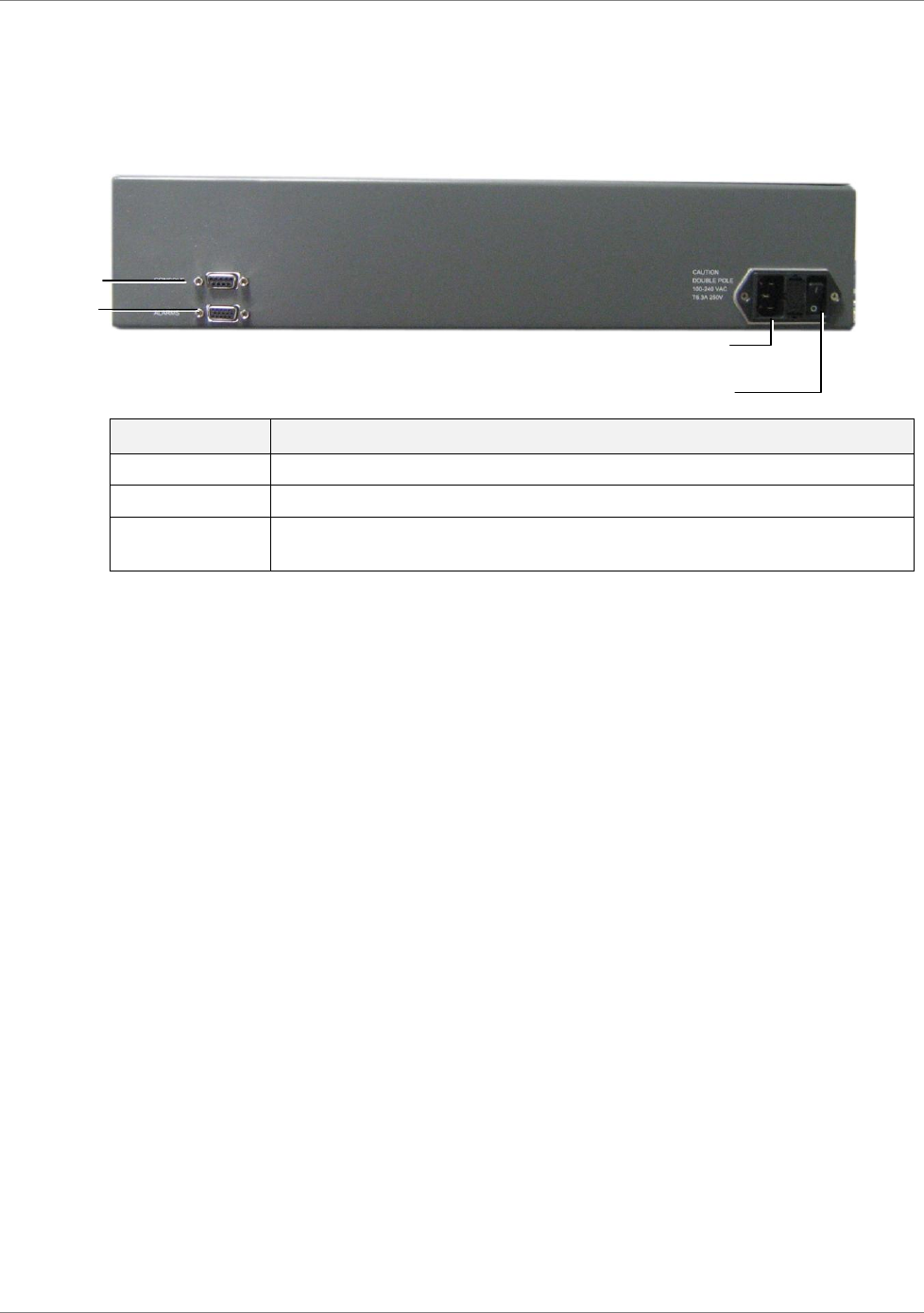
Overview
MobileAccessVE WiMAX Instant Coverage Solution User Manual 7
1.2.1.2 VCU Rear Panel
The rear panel includes the power input, the AUX alarms and service connections.
Figure
1-6. VCU Rear Panel
Table
1-3: VCU Rear Panel Description
Connector
Description
Console
RS232 local connection for service personnel (D-Type 9)
Alarms
AUX alarms connections - see section 3.3.
Power Input
Standard 3-pins AC power connector equipped with an ON/OFF switch.
90-264V AC, 47-63 Hz AC; 350W power consumption maximum.
Console
Power switch
Power connector
Alarms
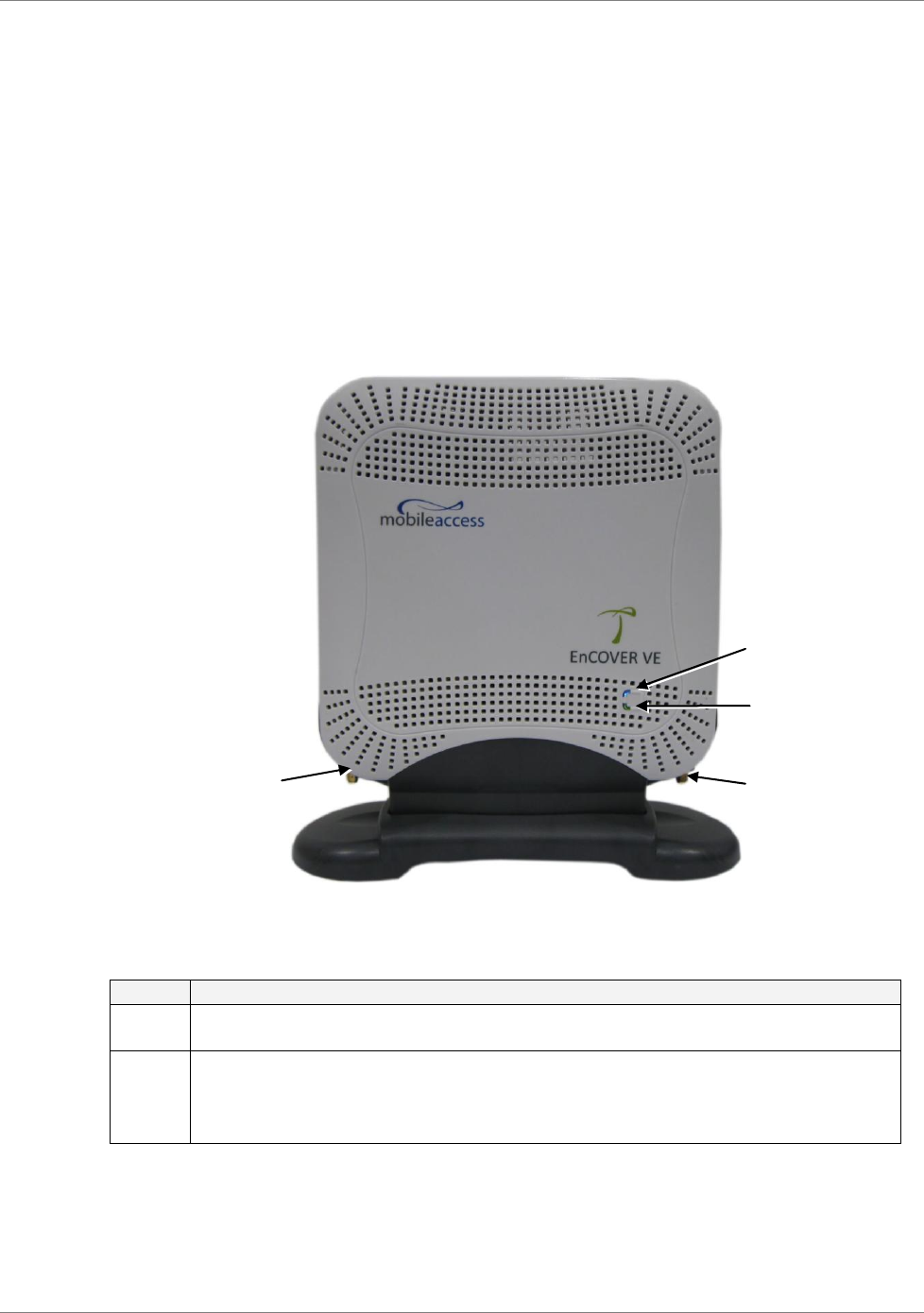
System Elements
8 MobileAccessVE WiMAX Instant Coverage Solution User Manual
1.2.2 VE Access Pod (VAP)
Each VAP provides the following functions:
WiMAX Antennas – distributes the WiMAX signals. The antennas are internal, where external
antennas can also be connected.
Connection to Ethernet port – relevant when connected to jacks where an Ethernet
connection is already available.
The VAP can be mounted/hung on the wall or placed on a flat surface (such as a desk).
The following figure shows the desktop assembly.
Figure 1-7. VE Access Pod-Front
Table 4: VAP LEDs
LED
Description
Power
Solid Green - Power supplied to VAP
Off - No power supplied to VAP
Activity
Off - No power supplied to VAP or Overall Status of VAP is faulty
Blinking Blue - Power on, VAP is initializing (connecting to VCU)
Solid Blue - Power on, unit operating normally
Fast Blinking Blue - User invoked “Identify” command on corresponding VAP
Blue LED (Activity)
Blue Led (Power)
External Antenna SMA
connector
External Antenna SMA
connector

Overview
MobileAccessVE WiMAX Instant Coverage Solution User Manual 9
The following figure shows the desktop VAP rear side and the underside view with the CAT-5e/6
patch-cord cable.
Figure 1-8. VE Access Pod-Rear
1.2.2.1 VAP Antenna Options
Two antenna options are available for VAPs:
Integral internal antennas
Connectors that interfaces to external antennas (for special coverage requirements).
By default, the VAP is set to transmit through the integrated internal antennas. To use the
external antennas connectors, select the “External Antenna” option in VAP Config-Service
RF tab of the VE Web GUI application (see section 7.3).
RJ-45 Connector
to VCU
RJ-45 Connector to
LAN terminal (e.g.
computer)
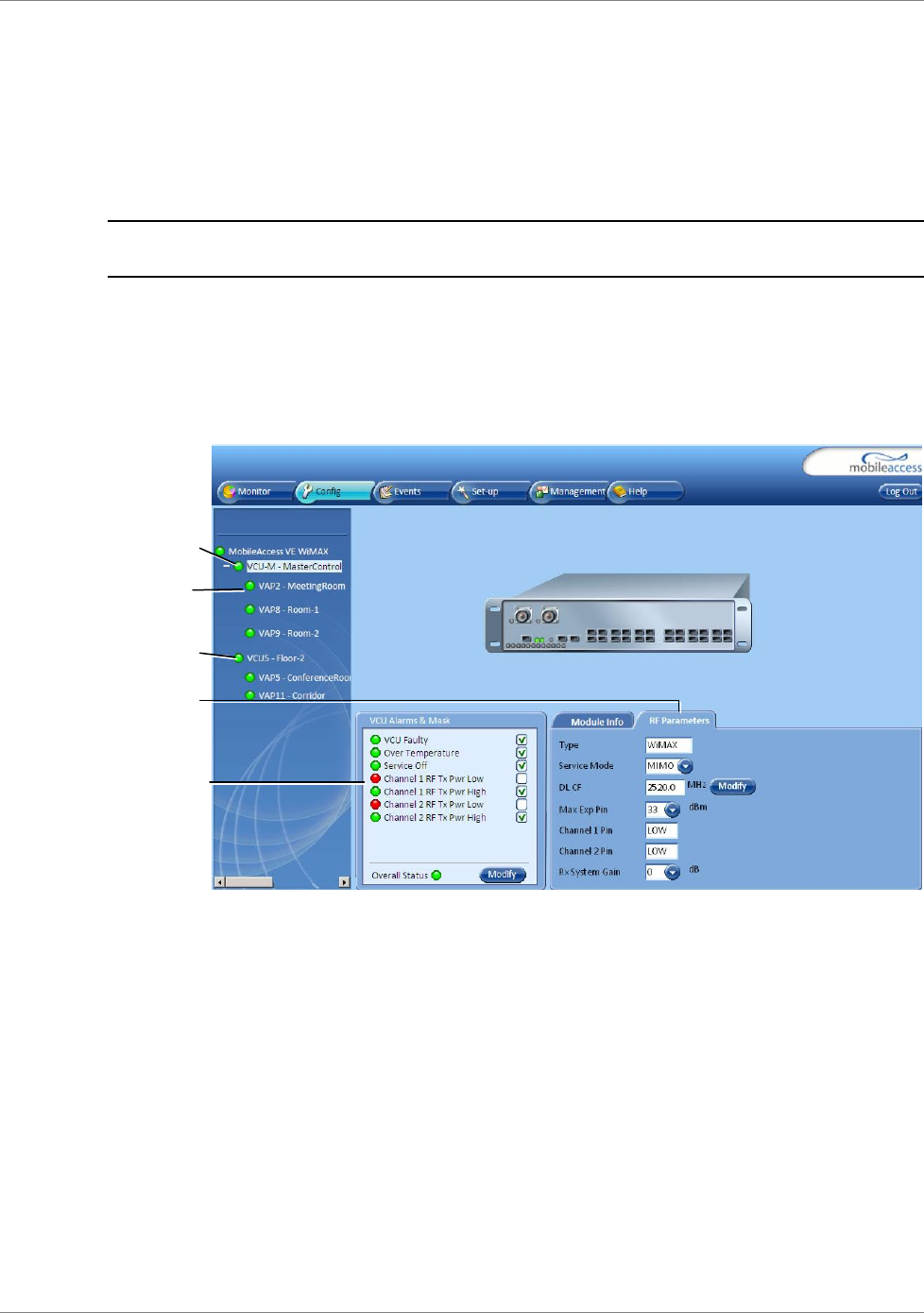
System Monitoring and Management
10 MobileAccessVE WiMAX Instant Coverage Solution User Manual
1.3 System Monitoring and Management
The MobileAccessVE system (Master VCU, Slave VCUs and VAPs) is centrally managed via a
single Web connection to the Master VCU.
Note: When locally connecting to a specific Slave VCU, only the VAPs connected to this VCU can
be monitored. When connected to the Master VCU, the entire deployment can be monitored.
The basic screen, as illustrated below, is the Config tab. It allows the user to view the system
topology and setup parameters, the Master and Slave VCUs, and the corresponding Access Pods.
The following image shows the VCU Master tabs and the corresponding Alarms pane.
1.3.1 Integration with an External Fault Management System
The MobileAccessVE system can be seamlessly integrated into any existing Fault Management
(FM) system that supports SNMP events. The Master VCU generates SNMP event for each
relevant system alarm and forwards this trap to the pre-configured IP address of the external
Fault Management system.
(Selected) Master VCU
Slave VCU
VAPs corresponding to
Slave VCU
Master VCU Alarms
Master VCU RF
parameters
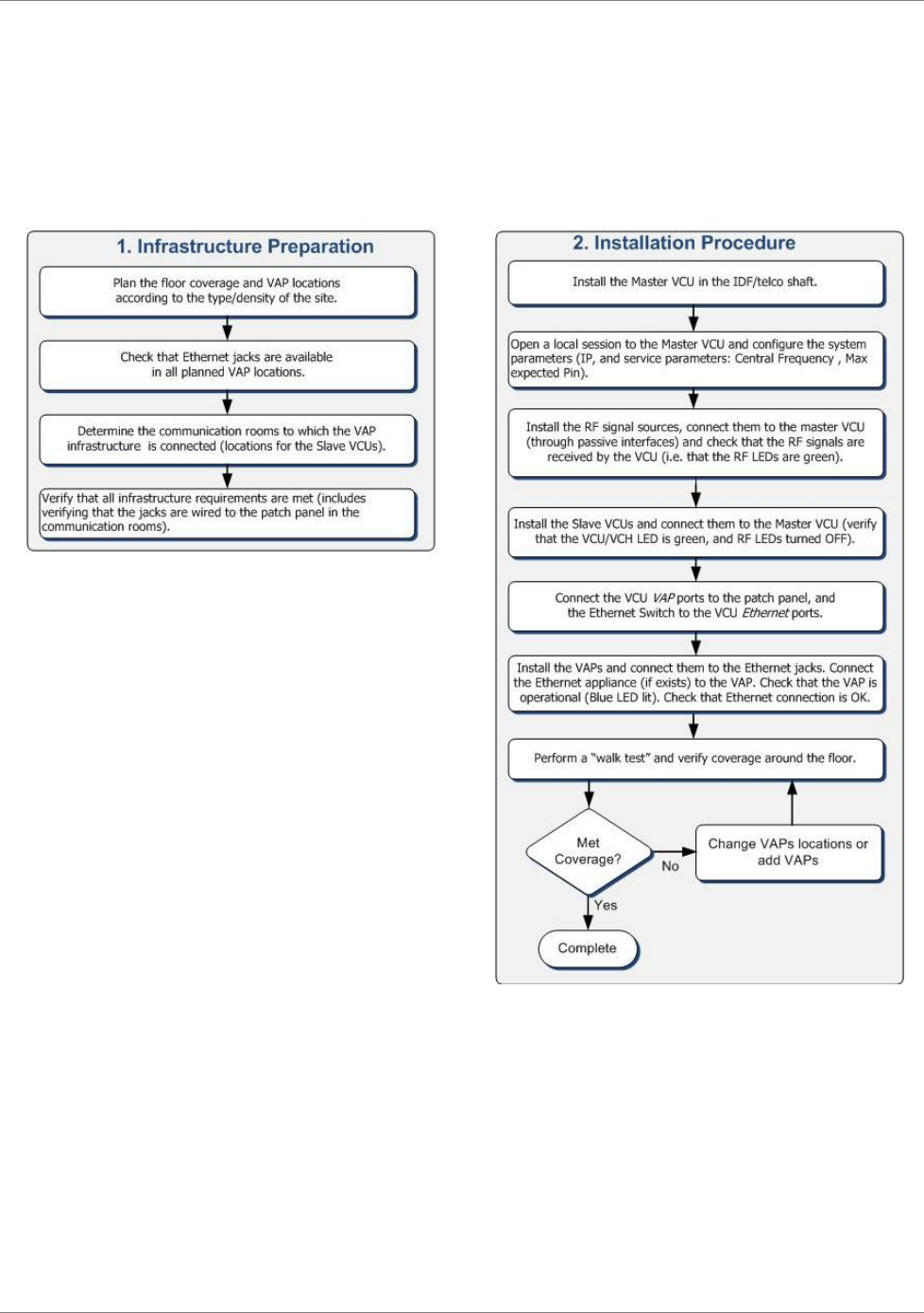
Overview
MobileAccessVE WiMAX Instant Coverage Solution User Manual 11
1.4 Overview of the Installation Procedure
The following figure provides an overview of the installation procedure.
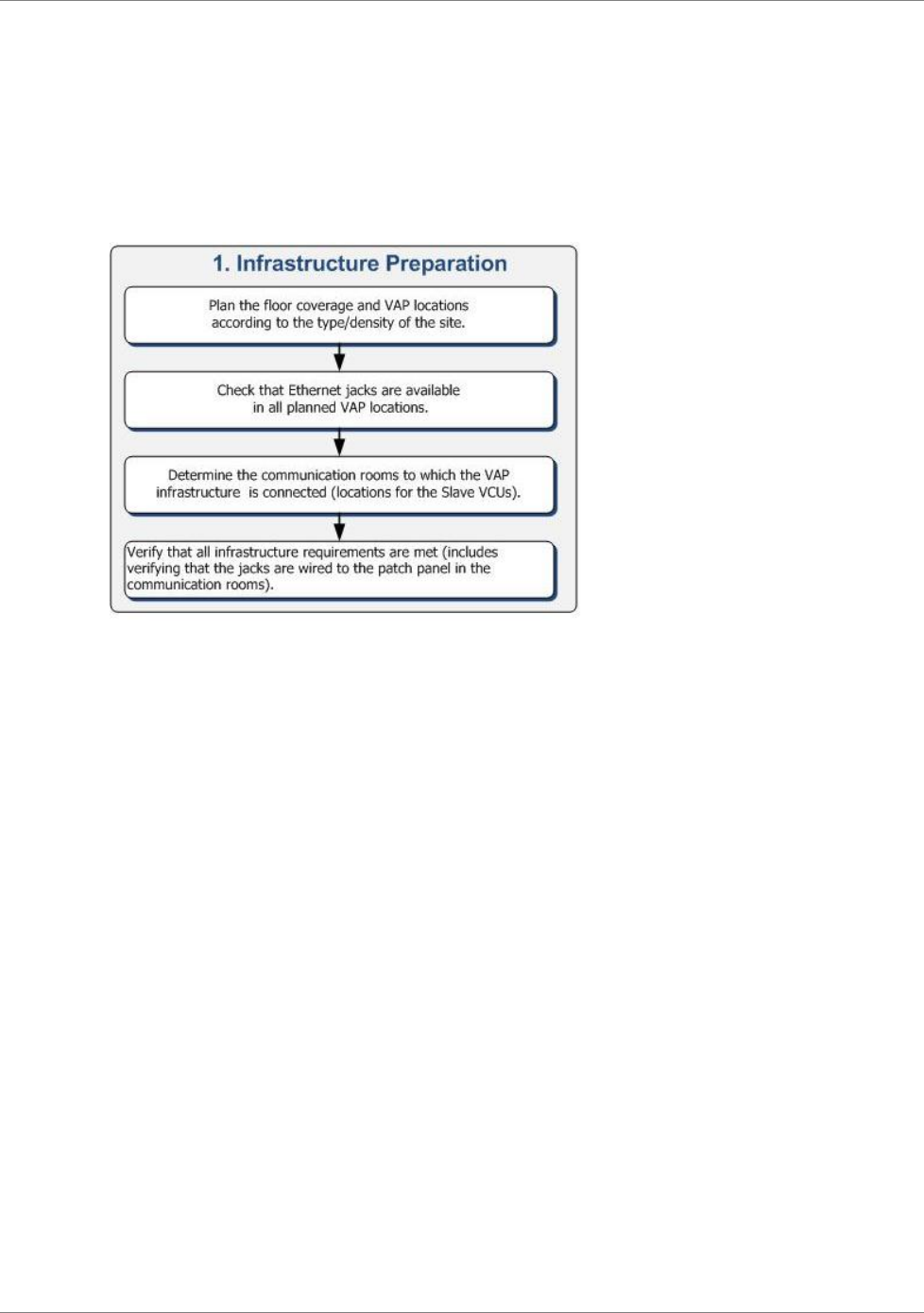
Overview of the Installation Procedure
12 MobileAccessVE WiMAX Instant Coverage Solution User Manual
2 Infrastructure Requirements and Layout
Planning
The following figure shows the flow for the infrastructure preparation.
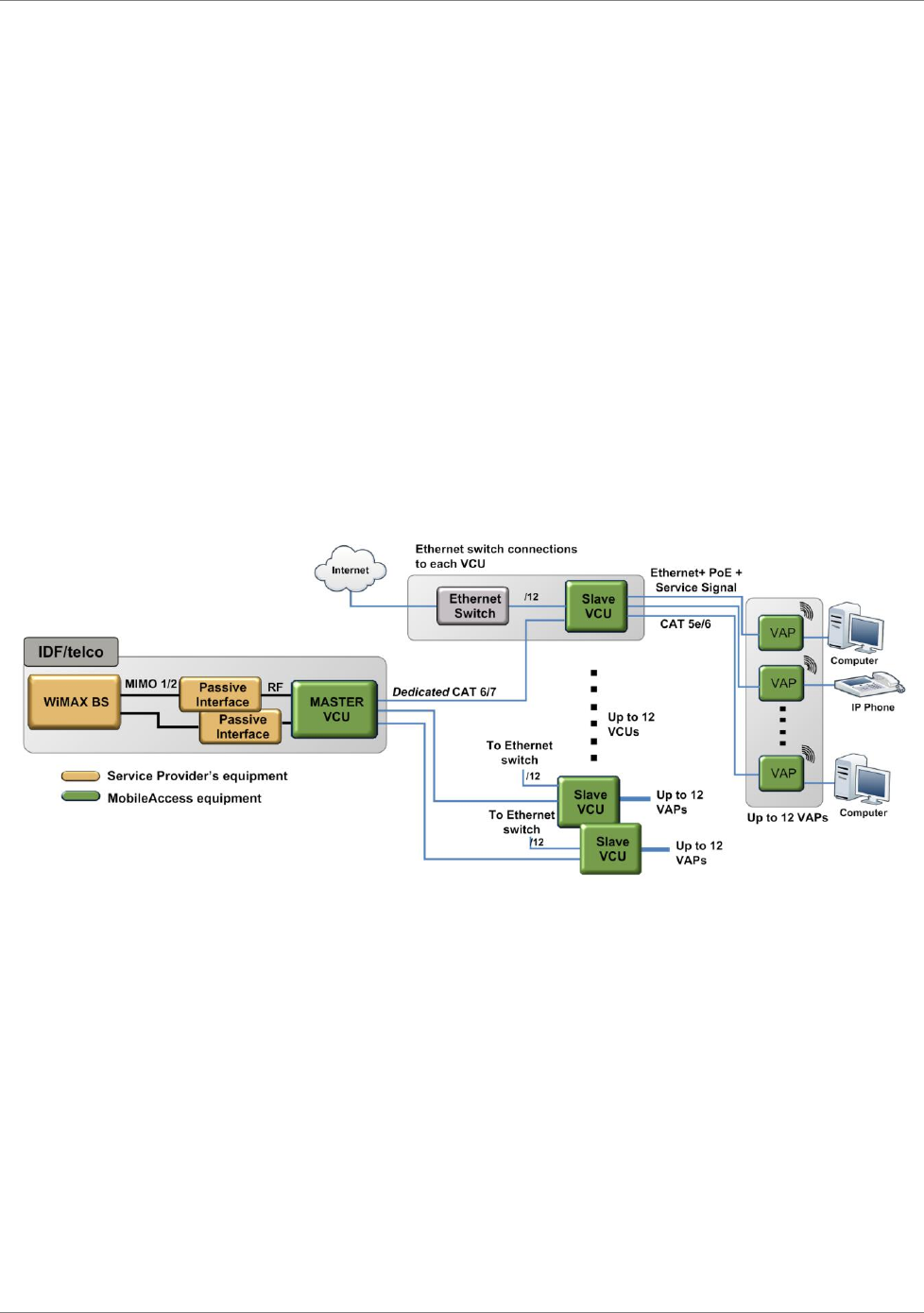
Infrastructure Requirements and Layout Planning
MobileAccessVE WiMAX Instant Coverage Solution User Manual 13
2.1 Summary of Unit Locations and Connections
Service provider’s RF equipment - Macrocell, Microcell, Picocell, Femtocell, BDA, etc.
connects to the VCU through a passive interface.
VCUs:
Master VCU installed at the main IDF/telco cabinet and connected to all VCUs.
Slave VCUs installed at the IDF/telco cabinet of each covered floor and connected to
the Master VCU, the Ethernet switch and the VAPs (through the cabling patch panel).
WiMAX service signals from Master VCU to VCUs – routed through dedicated Ethernet
CAT-6 or CAT-7 cabling.
WiMAX service signals from VCUs to the VAPs – routed through existing Ethernet CAT-
5e/6 cabling infrastructure.
VAP location and mounting - wall-mounting or desktop-mounting. Connection to existing
Ethernet jack (and external antenna if required).
VAP power source - No power connections required. VAPs are power fed from the VCU
using PoE (Power over Ethernet) technology.
Figure
2-1. WiMAX VE Basic Architecture
2.2 Infrastructure Requirements
Ethernet standards specify that the maximum distance between an Ethernet switch and
appliance (computer, WLAN AP etc) shall not exceed 100m (300ft). Therefore, when VE shares
the IT LAN, the maximum distance for a given cable run, cannot be longer than 100 meters
(300ft) between the Ethernet switch and appliance, including all patch cords (from switch to
VCU, from VCU to patch panel, from RJ-45 outlet to VAP, and from VAP to appliance).

Infrastructure Requirements
14 MobileAccessVE WiMAX Instant Coverage Solution User Manual
Typically the horizontal cabling system will be connected to patch-panels in the communication
rooms. The entire cabling system (including the patch panels and patch cords) shall adhere to
the CAT-5e (or CAT-6) standard. Specifically all pairs of the CAT-5e cable should be wired in the
patch panels (and patch cords).
1. IDF/telco closet space for one VCU (48.3 x 30 x 4.44 cm).
Note: When planning the IDF/telco shaft, take the RF equipment (Picocell/Microcell or
BDA) and the VCU in to consideration.
2. 350 Watts of AC power to the VCU IDF/Telco closet.
3. Building infrastructure:
Category 5e or CAT-6 cabling, Shielded Twisted Pair (STP)
24 AWG minimum diameter for CAT-5e cabling
Dedicated CAT-6/7 STP cable from Master VCU to Slave VCUs with run lengths NOT
exceeding 100m (300ft) and not shorter than 10m.
NOTE: in certain deployments the master-slave CAT-6 STP connection may be shared
with Ethernet signals - refer to Appendix VE Connections in Central Ethernet Source
Topologies for more details
CAT-5e/6 STP cable from VCU to each VAP with run lengths NOT exceeding 100m
(300ft) and not shorter than 10m (33ft). VAPs can be connected over existing CAT-5e/6
cabling infrastructure and existing Ethernet jacks without affecting the LAN.
Note: Verify with the IT department that the existing cables support the VE installation.
If available, review the infrastructure documentation to determine cable types and
lengths. If the cable information is not available, attempt to visually identify the cable
type. Depending on the cable vendor, the cable type may be listed on the cable sheath.
It is recommended to use a Fluke cable tester to measure the cable length of the most
remote VAPs.
4. Master VCU Cable Connections:
2 x N-type female, 50 ohm interfaces to carrier equipment
Up to 12 x RJ-45 interfaces to Slave VCUs
1 x RJ-45 interface to Management
1 x D-Type 9 pins RS-232 interface for local craft
1 x D-Type 15 pins interface for External Alarms (dry contacts)
5. Slave VCU Cable Connections
1 x RJ-45 interface to Master VCU (not used in small single tier deployments)
12 x RJ-45 interfaces to VAPs
12 x RJ-45 interfaces to Ethernet Switch for LAN service
(1) RJ-45 connector for switch bypass
1 x D-Type 9 pins RS-232 interface for local craft

Infrastructure Requirements and Layout Planning
MobileAccessVE WiMAX Instant Coverage Solution User Manual 15
2.3 Coverage and Installation Planning
Note: The following section provides the information required for planning the VAP installation
on a single floor. In a multi-tier installation, this procedure is performed for each individual floor.
The WiMAX coverage area of each VAP is affected by the density and type of environment to be
covered. Therefore, it is recommended to determine the location in two phases:
Plan the
ideal
location of each VAP in order to achieve complete WiMAX coverage of the
floor and then
Select
exact
location according to the location feasibility, where each VAP unit may be
mounted on a wall or placed on a desk and an option for an external antenna is available.
The supplied services (WiMAX only or Ethernet and WiMAX) depend on the jack to which the
VAP is connected:
If the jack supports an active Ethernet connection – the VAP will distribute LAN traffic along
with the WiMAX service.
If the jack is not currently active (not connected to an Ethernet switch) - the VAP will
distribute only WiMAX.
This section provides information on coverage criteria in various types of environments (Open,
Standard, Dense and Combined) and provides rules-of-thumb for various installations of the
VAPs.
Note: Section
2.4 provides a detailed example of installation planning in various types of
environment. It is recommended to review this example after reading this section.
2.3.1 Types of Environment
This section describes the different types of installation environments and provides guide lines
for best coverage of each type of space.
The coverage guidelines in this section are conservative “rule of thumb” estimates of RF
coverage per VAP, meant to be used in scenarios in which detailed designs are not performed.
When the coverage layout is designed, the coverage per VAP is expected to increase by up to
33%. Coverage estimates in this section assume 25% overlap between the coverage areas of
neighboring VAPs to ensure robust, full coverage throughout the enterprise with no “dead
zones”.

Coverage and Installation Planning
16 MobileAccessVE WiMAX Instant Coverage Solution User Manual
2.3.1.1 Open environment
An environment with minimum of obstacles (such as walls). This type of space can be a large
conference or meeting room, cubical areas, lobby or atrium areas.
Table
2-1: Open Environment Installation Distances
Signal Propagation from VAP
64 feet (21 m)
Recommend spacing between VAPs
128 feet (42 m)
Recommended maximum distance of
VAPs from outer walls
64 feet (21 m)
Coverage area per VAP
12,750 sqft (1,185 sqm)
2.3.1.2 Standard Environment
A traditional office environment with offices, hallways and scattered cubicles.
Table
2-2: Standard Environment Installation Distances
Signal Propagation from VAP
56 feet (19 m)
Recommended Spacing between VAPs
112 feet (38 m)
Recommended Maximum distance of
VAPs from outer walls
56 feet (19 m)
Coverage area per VAP
9,900 sqft (920 sqm)
2.3.1.3 Dense Environment
A dense environment consists of a relatively large amount of walls, offices, equipment, tall file
cabinets, bookshelves and other items that could potentially impact the wireless signal.
Examples for this type of environment are dense offices, hospitals and manufacturing spaces.
Table
2-3: Standard Environment Installation Distances
Signal Propagation from VAP
41 feet (13.5 m)
Recommended Spacing between VAPs
82 feet (27 m)
Recommended Maximum distance of
VAPs from outer walls
41 feet (13.5 m)
Coverage area per VAP
5,300 sqft (495 sqm)
2.3.1.4 Combination of Environments
In areas with combinations of environments of various densities, place the VAPs on the border
between the different types of areas – closer to the denser area.
For example, in a cubical area with the outside wall having offices, simply locate the VAPs a little
closer
to the outside offices
to provide coverage through the office walls. (See VAPs 11 and 13 in
the floor plan map in section 2.4.3.)
To ensure maximal coverage, VAPs can be re-located or added. If a coverage gap is detected,
the VAPs can be re-located until the coverage gaps are filled.

Infrastructure Requirements and Layout Planning
MobileAccessVE WiMAX Instant Coverage Solution User Manual 17
2.4 Planning VAP Layout
This section describes the steps for planning the VAPs along the covered floor. An example of
planning map is attached at the end of this section.
Note: It is highly recommended to use a floor plan when planning the VAPs locations.
2.4.1 RF Coverage Factors
It is important to note the type of factors that can severely impact RF coverage which should be
avoided:
Metallic structures such as elevators, high file cabinets and some moveable metallic
partitions severely degrade RF signal and all efforts should be made to locate VAPs in front
of or above metallic objects (desks, filing cabinets) to allow the signal to propagate.
Wall materials such as concrete, tile and cinderblock along with bathroom fixtures typically
have fairly high signal attenuation and should be considered as dense spaces.
Types of glass (typically exterior or mirrored) that have metallic coatings on it which can
affect RF coverage, however that is typically not encountered inside a building.
2.4.2 Mapping Locations
To map the VAP Locations
1. Map out the available Ethernet jack locations: mark all the CAT-5e/6 drops locations on the
floor plan map.
TIP: The size and number of the ceiling tiles can be used to measure distances.
2. Using the floor plan and the VAPs coverage guidelines (as given in 2.4.3), mark the
approximate location of each VAP in the facility.
VAPs may be added (or removed) at anytime for optimal coverage.
3. For each jack to be used for connecting a VAP, check if the jack is already connected to the
Ethernet switch (via the patch panel). Record the connections for each jack, for reference.
4. Connect the Ethernet cables corresponding to the selected jacks according to section 3.4.1.
5. It is also recommended to check the area in which the VAPs are to be installed and make
sure that the installation is feasible.
2.4.3 Connecting Directional Antennas
Each VAP has an integrated internal antenna that provides isotropic radiation as well as two
interfaces for external antennas which enable connecting directional antennas to VAPs installed
near outer walls in order to prevent interference. It is then required to configure the VAP to
operate with the external antennas – see section 7.3.
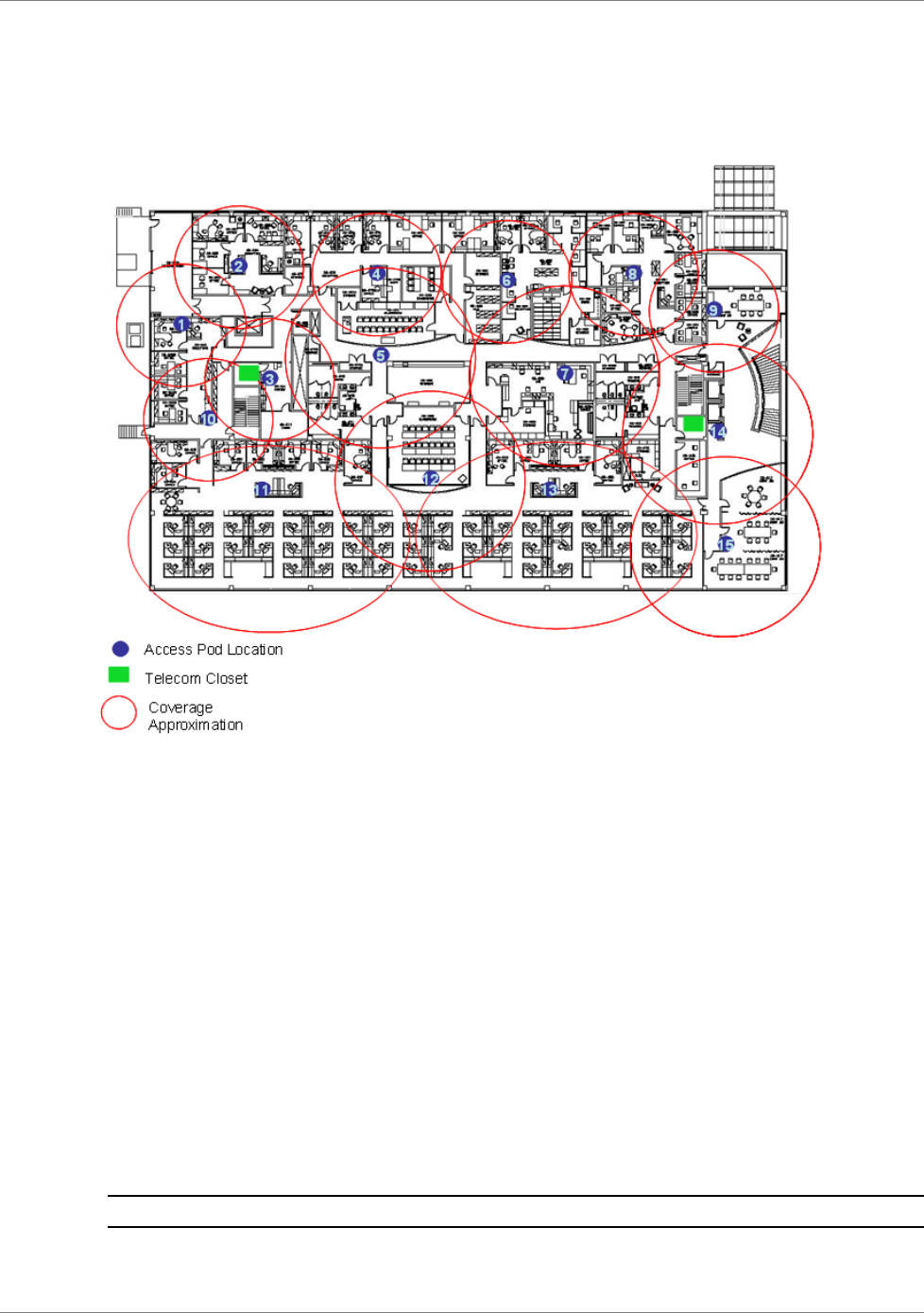
Planning VAP Layout
18 MobileAccessVE WiMAX Instant Coverage Solution User Manual
2.4.4 Installation Plan Example
The Following figure shows a floor plan map with all required marks:
Figure
2-2. Floor Plan Example
Notes:
The red VAP coverage circles are approximately 41, 56 and 64 foot (13.5, 19 and 21 m)
radius for the small, medium and large circles respectively (drew according to the guidelines
given in section 2.3.1).
VAP 3 is surrounded by dense objects, the bathroom and stairwell which would reduce
coverage in that area by the other VAPs.
VAP 5 is an example of a unit that provides good coverage down the hallways.
VAPs 11 and 13 are placed closer to the offices to cover them well but on the open side will
actually cover a much greater area which is why the coverage is larger and shown here
more as an oval than a circle.
The area between VAPs 7 and 14 outside the bathrooms would probably be the lowest
coverage spot in the building because of the bathrooms and stairwell on either side of that
area. If after the system installed, this area is still a little low on coverage, a VAP can be
added, but it may also be covered by VAP 14.
Note: The plan can be modified at any time by moving the units around or by adding units.
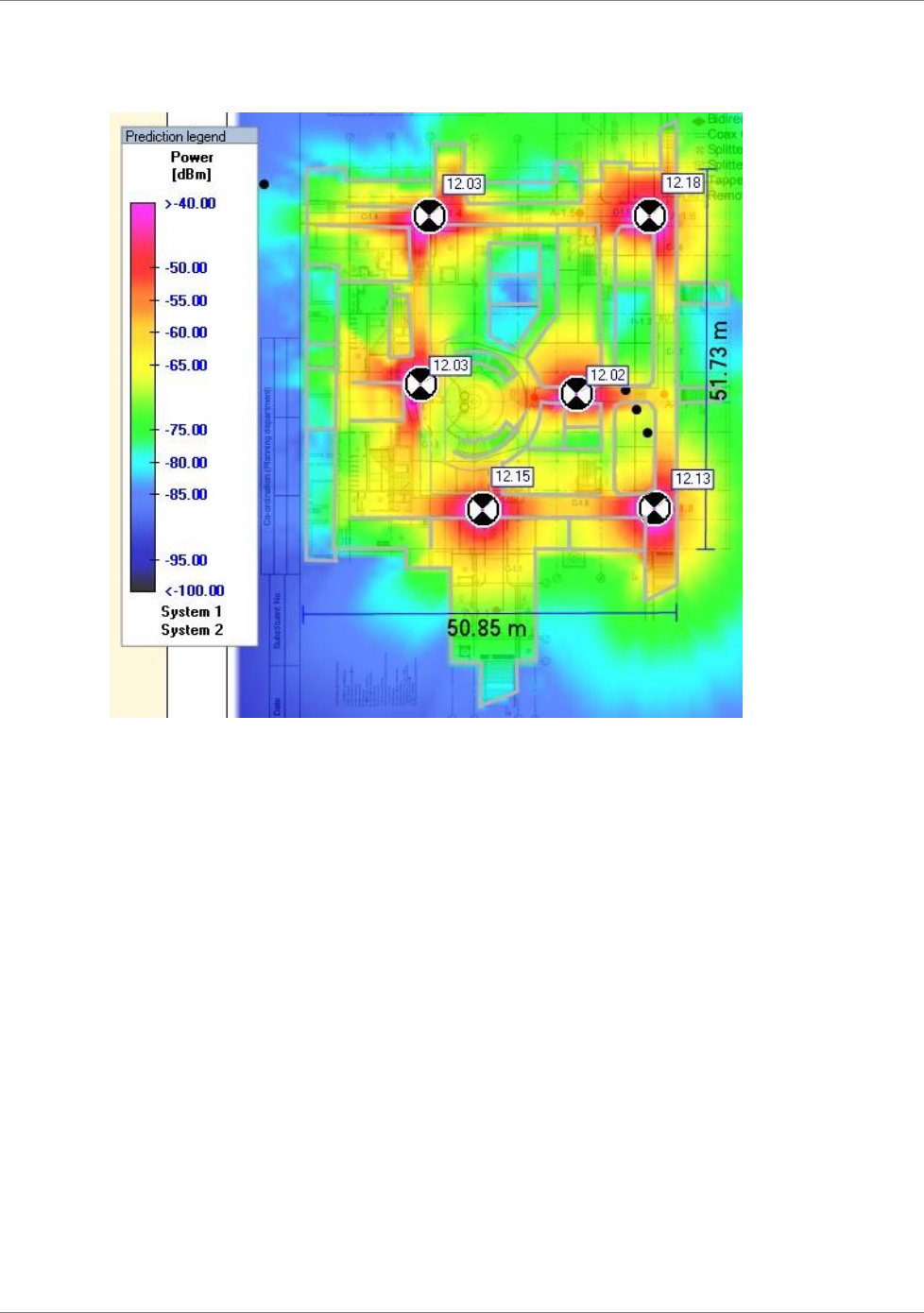
Infrastructure Requirements and Layout Planning
MobileAccessVE WiMAX Instant Coverage Solution User Manual 19
The following figure depicts an actual measured quantified coverage of a floor area planed
according to the above rules
Figure
2-3. Distributed VAPs propagation, 12dBm output power at 1.8GHz.
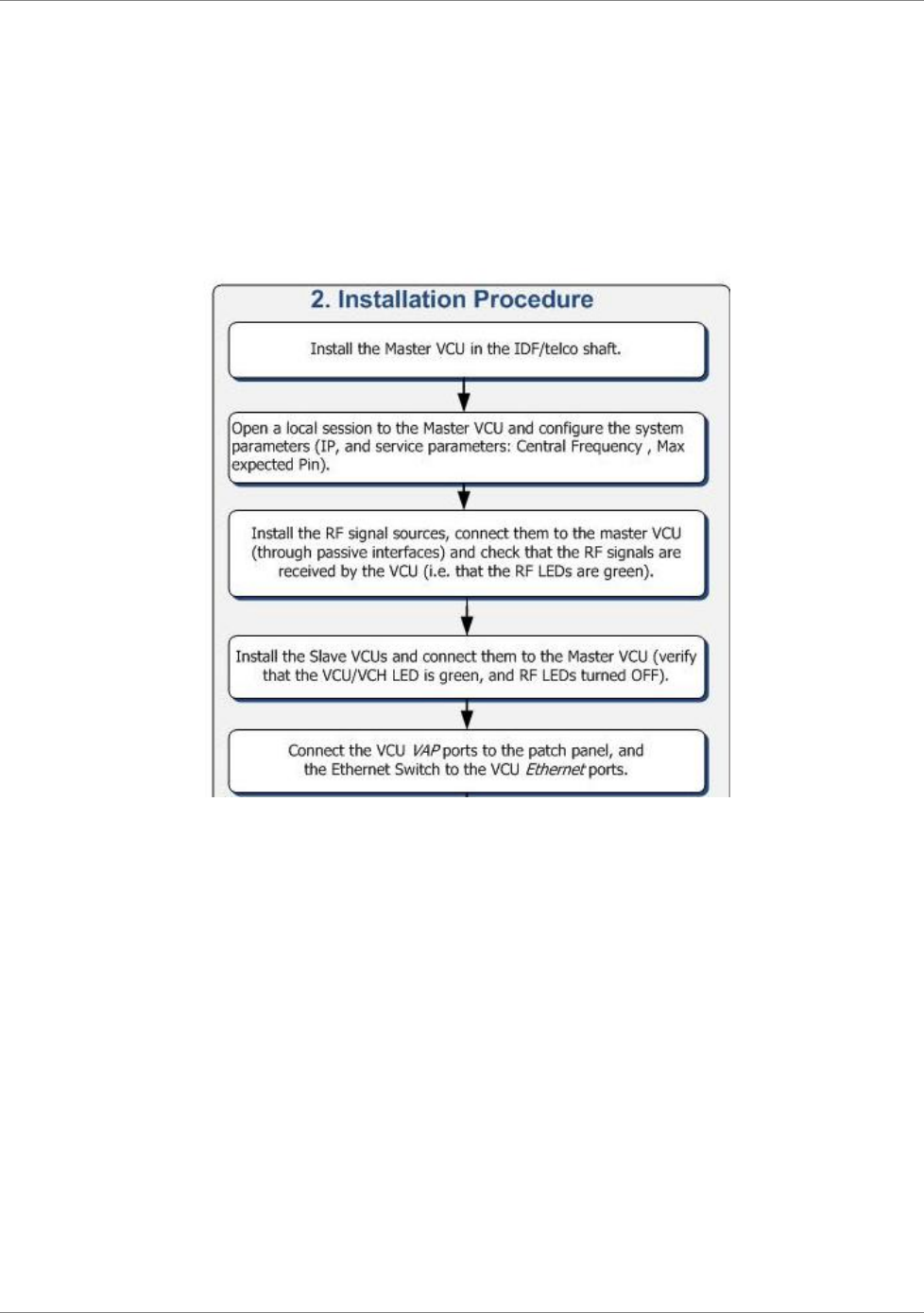
Planning VAP Layout
20 MobileAccessVE WiMAX Instant Coverage Solution User Manual
3 VCU Unit Installation and Configuration
This section describes the installation and configuration procedures of the VE Control Unit (VCU).
These should be performed only after planning the floor coverage and installation locations as
described in section 2.3.
The following figure summarizes the main steps of the installation procedure:
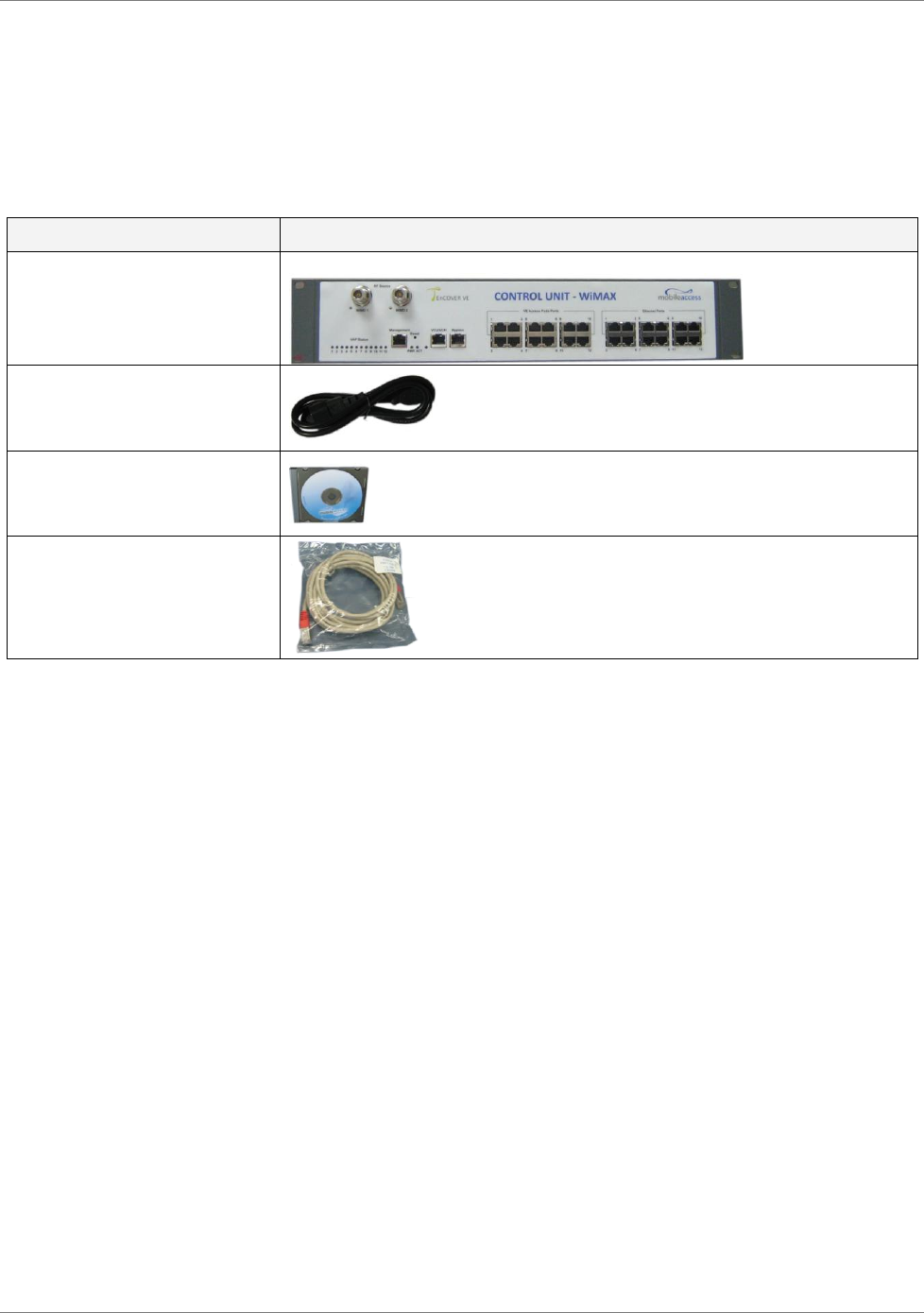
VCU Unit Installation and Configuration
MobileAccessVE WiMAX Instant Coverage Solution User Manual 21
3.1 Installation Kit Contents
The MobileAccessVE Single Tier Solution VCU kit includes:
Table
3-1: VCU Kit
Description
UNIT
WiMAX VE Control Unit (VCU) Kit
(including brackets for securing
the VCU to 19” rack)
Power cord
VE SW CD
Local configuration cable
(crossed RJ-45 cable)
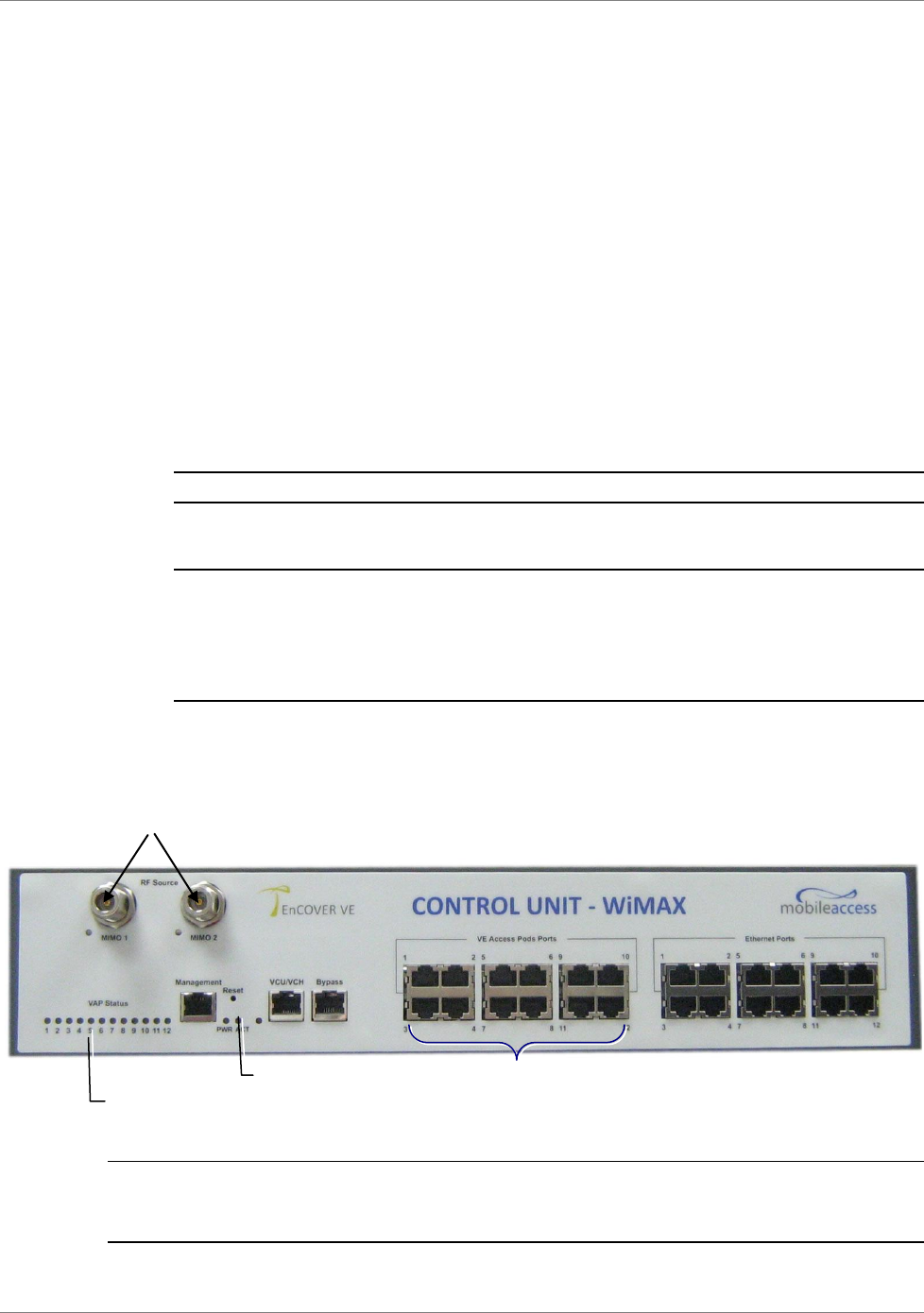
Installing Master VCU
22 MobileAccessVE WiMAX Instant Coverage Solution User Manual
3.2 Installing Master VCU
The VE control unit can be installed as a Master VCU and control up to 12 Slave VCUs. The
Master VCU is installed in the main IDF/telco closet. This section describes the Master VCU
installation procedure.
1. Install the Master VCU in the main IDF/Telco closet. The Master VCU can be installed in the
rack (placed on a shelf or secured using supplied bracket) in the IDF closet along with the
provider‟s signal sources.
2. Apply power to the Master VCU and verify that the PWR LED is lit. Also verify that the unit
ACT LED completes initialization (blinking light) and shows a solid green light.
3. Connect (or request the service provider‟s service personnel to connect) the provider‟s
signal source (Macrocell, Microcell, Picocell or BDA) through passive interface to the
Master VCU front panel RF ports (MIMO1 and MIMO2).
Note: In SISO service mode, only the MIMO 1 RF port is relevant.
Power on the signal sources.
Note: The RF Source LED (see following figure) of the connected port on the Master VCU
should be lit GREEN, indicating that the Master VCU senses the RF signal from the
source at the expected level (according to Max Expected Pin). In case the LED remains
RED after connecting the capacity source, verify that Max Expected Pin is configured
properly and that the service is enabled.
4. Connect the Master VCU VAP ports to the Slave VCUs VCU/VCH ports via the patch-
panel that feeds the dedicated CAT-6 or 7 cabling system.
NOTE: After the Slave VCUs are connected, verify that that the Master VCU VAP Status LEDs,
corresponding to the connected Slave VCUs, complete initialization (blinking light) and show a
solid green light.
MIMO1/MIMO2 ports
VAP Ports 1-4; 5-8; 7-12
ACT LED
VAP Status LEDs
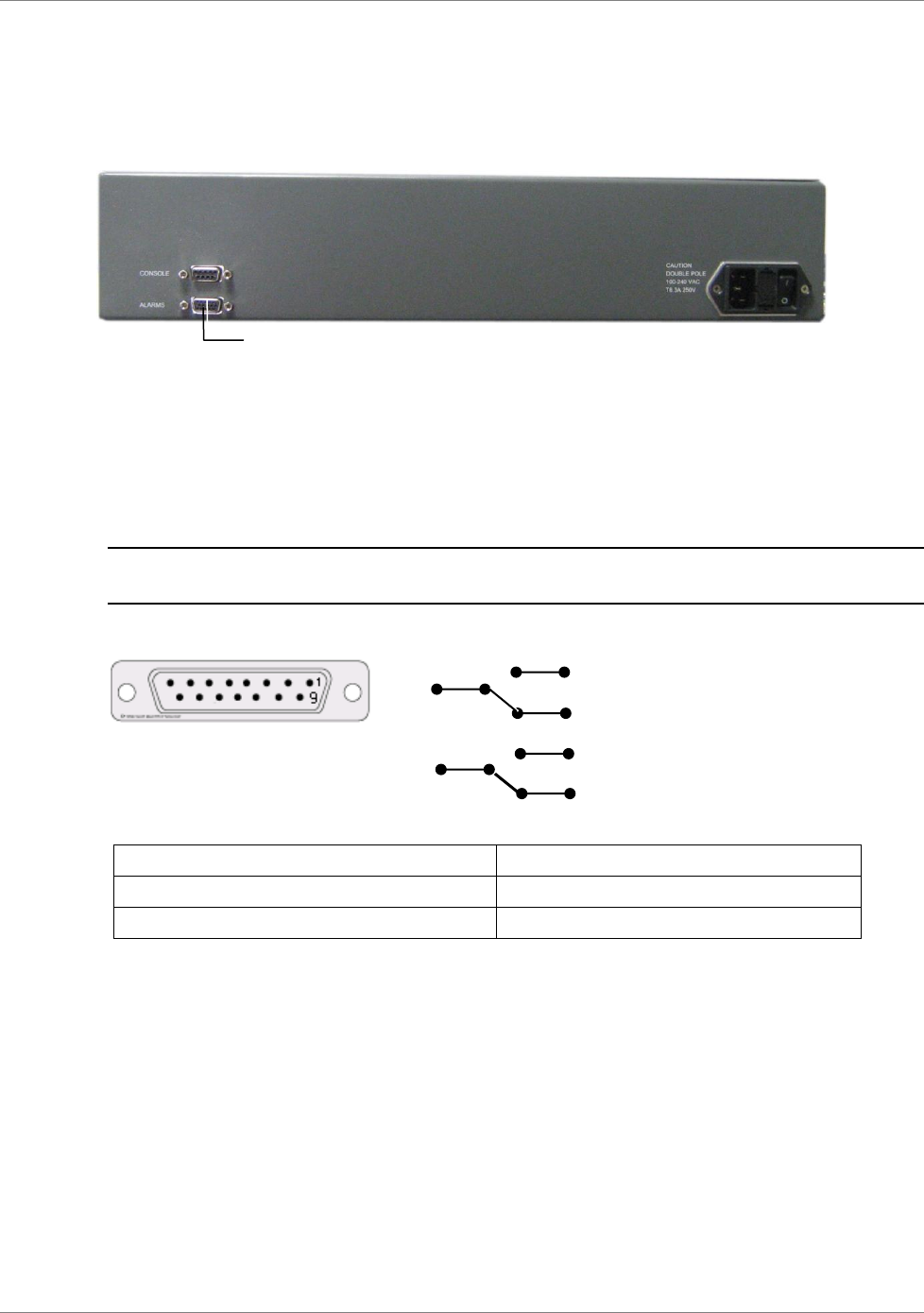
VCU Unit Installation and Configuration
MobileAccessVE WiMAX Instant Coverage Solution User Manual 23
3.3 Auxiliary Alarm Output Connections
The auxiliary connections are performed through the Master VCU rear panel Alarms port. See
following figure.
The controller can provide Major and Minor output alarms. These alarms can be connected
directly to the auxiliary input of the Base Station, or to any other dry-contact application.
A Major alarm is generated when there is an alarm condition in one (or more) VCUs while a
Minor alarm is generated when there is an alarm condition in one (or more) of the VAPs.
Note: If only one alarm is required (Minor or Major) an external connection of a wire jumper
between pins 8 and 13 is necessary (normally closed).
Connect the relevant alarms according to the connector pinout below.
Table 2. Alarms Connector – used pins
8 – Major Error signal (normally closed)
7 – Minor Error signal (normally open)
11 – Major COM
12 – Minor COM
15 –Major Error signal (normally open)
13 – Minor Error signal (normally closed)
Alarms port for auxiliary
connections
11
15
8
Major Alarm
12
7
13
Minor Alarm
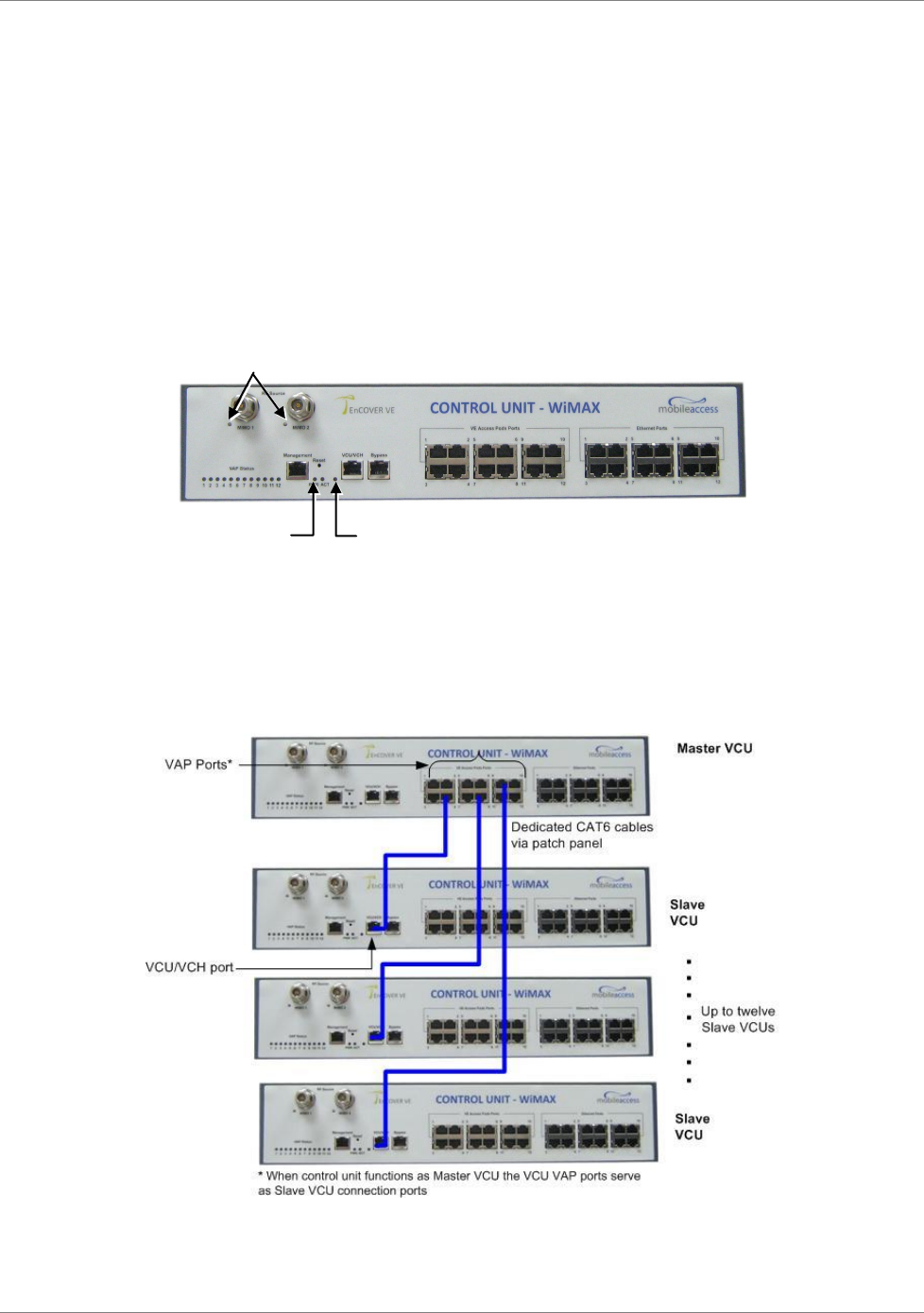
Installing Slave VCU
24 MobileAccessVE WiMAX Instant Coverage Solution User Manual
3.4 Installing Slave VCU
1. Install the Slave VE Control Unit (VCU) in the IDF/Telco closet corresponding to the floor to
be covered. The Slave VCU can be installed in the rack using the supplied bracket in the IDF
closet.
Apply power to the Slave VCUs and verify that the VCU PWR LED is lit and that the unit ACT
LED completes initialization (solid light) and shows a blinking green light. See Figure 3-1.
Figure 3-1. VCU PWR, RF and VCU/VCH LEDs
2. Connect the Slave VCU front panel VCU/VCH port to the Master VCU VAP port via the
patch panel using dedicated CAT6 cables and verify that the VCU/VCH LED completes
initialization (blinking light) and shows a solid green light. The RF LEDs (of both MIMOs)
should turn OFF.
Figure 3-2. Master and Slave VCU Connections
VCU/VCH LED
RF Source LEDs
PWR LED
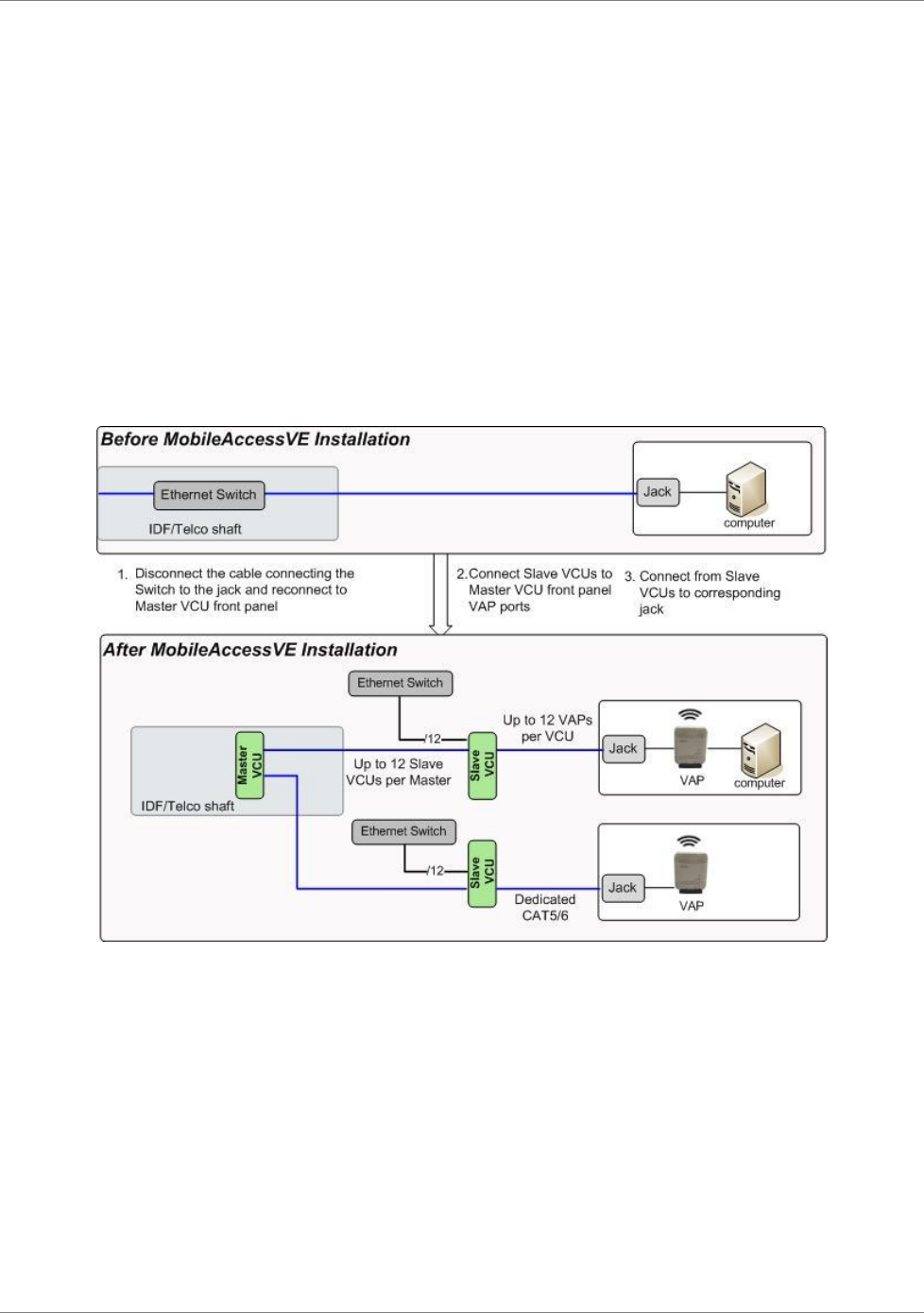
VCU Unit Installation and Configuration
MobileAccessVE WiMAX Instant Coverage Solution User Manual 25
3. Connect the Slave VCU VAP ports to the patch-panel that feeds the existing structured CAT-
5e/6 cabling system.
4. According to VAPs layout plan (as explained in section 2.4.2) connect the Ethernet switch
cables (see section 3.4 for more detailed explanation):
If the jack to be used is already in use (connected to Ethernet switch) – disconnect it from
the Ethernet switch and re-connect it to the corresponding Ethernet port in the Slave VCU
front panel.
Jacks not in use will be connected only to the Slave VCU.
3.4.1 Connecting VAP Ethernet Cables
For VAPs installed on currently ACTIVE Ethernet ports - shift the relevant Ethernet LAN
connections as follows.
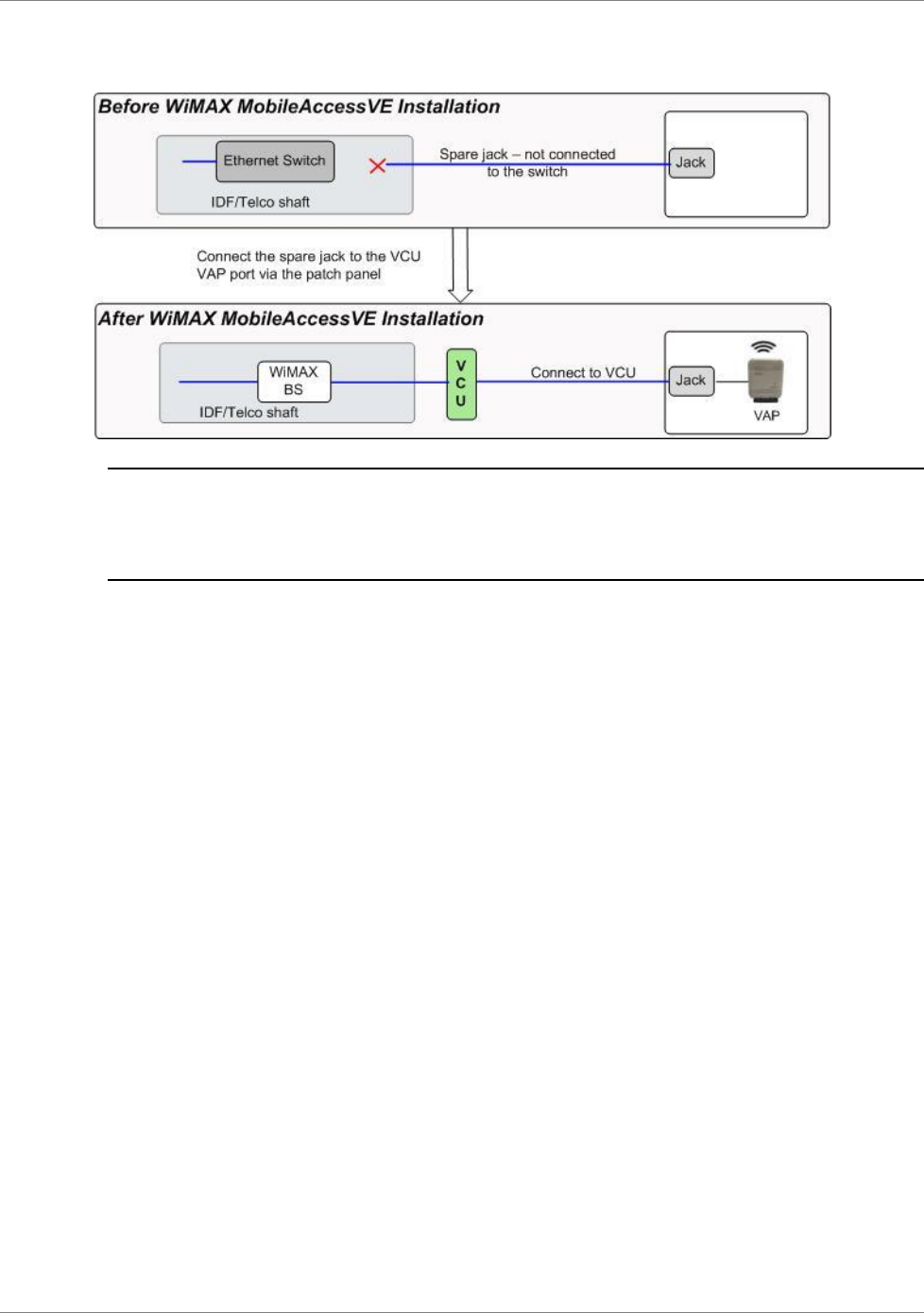
Installing Slave VCU
26 MobileAccessVE WiMAX Instant Coverage Solution User Manual
For VAPs installed on currently INACTIVE Ethernet ports – connect as follows.
NOTE: After the Slave VCUs are installed, and connected to the right ports in the patch panels,
you can proceed with VAP installation as described in chapter
4 . However it is recommended to
first complete the VCU provisioning (see section
3.5) so that when installing the VAPs they will
instantly provide the wireless service (and the installer will be able to check the coverage).
3.4.2 Operation with LAN utilizing Power over Ethernet (PoE)
Power over Ethernet (PoE) is a technology that enables passing electrical power over the
Ethernet cabling. Power can either come from a PoE-enabled Ethernet device (e.g. switch) or
from a “mid-span” device built for "injecting" power into the Ethernet cabling.
PoE can operate over two different pairs in a CAT-5e/6 cable - these two methods are referred
to as „alternative a‟ and „alternative b‟. All PoE compatible appliances such as WLAN APs and IP
Phones support both alternatives and automatically detect and use the power on the appropriate
pairs (alternative a or b).
MobileAccessVE supports sharing LAN infrastructure that use either 802.3af PoE or 802.3at PoE.
Both alternative a or b are seamlessly supported through the VE system.

VCU Unit Installation and Configuration
MobileAccessVE WiMAX Instant Coverage Solution User Manual 27
3.5 Provisioning the Master VCU
This section describes how to set the basic parameters required for operation and remote
management of the Master VCU using the Web GUI. The configuration dialogs are fully
described in Chapter 5 .
The Master or Slave mode is automatically detected according to the VCU's physical connection.
If a connection to another VCU is detected the VCU will be identified as a Slave; otherwise it will
assume the role of a Master.
Notes:
The initial configuration of the Master VCU is performed via local connection (using a
cross-cable and connecting to VCUs default IP address). After performing the initial
configuration and assigning the Master VCU an IP, the system can be connected,
monitored and configured via a remote management connection.
The configuration and management of all of the system units (VCUs and VAPs) is
performed via the Master VCU unit (local or remote connection).
3.5.1 Configuring the Computer IP Parameters
Configure the computer local LAN connection to operate in the same subnet as the default VCU
IP address. Note that the procedure may vary slightly depending on the operating system
installed on your computer. The following procedure is for Windows XP.
To configure the computer’s IP parameters:
1. Click the Start menu and choose Control Panel.
2. In the Control Panel, click Network and Internet Connections.
3. Click Network Connections and then double-click Local Area Connection.
The Local Area Connections Properties dialog appears with the General tab displayed by
default.
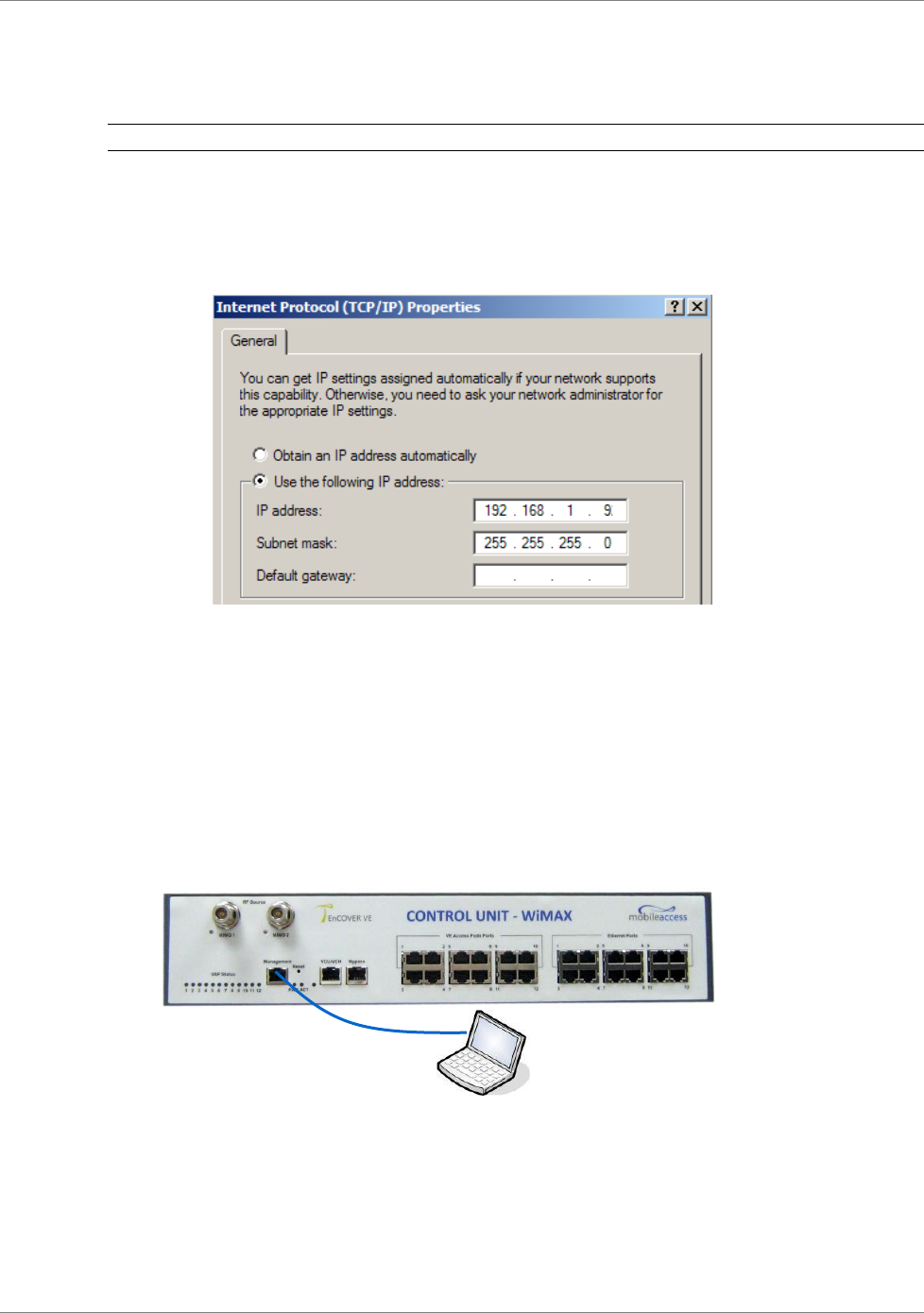
Provisioning the Master VCU
28 MobileAccessVE WiMAX Instant Coverage Solution User Manual
4. In the Items list, select “Internet Protocol (TCP*IP)” and click the Properties button.
5. The “Internet Protocol (TCP/IP) Properties” dialog appears.
NOTE: The Master VCU is supplied with the default IP address 192.168.1.1.
In order to communicate with the unit, it is necessary to assign your computer a
Static
IP
address in the same subnet: 192.168.1.2 to 192.168.1.250.
(i.e. 192.168.1.9 as shown in the example).
Define the subnet mask as shown: 255.255.255.0
6. Click OK.
7. The computer communication parameters are now defined and you can open a session to
the Master VCU and provision the unit.
3.5.2 Login
1. Perform a local connection to the Master VCU unit by connecting the Master VCU front panel
Management port and a laptop computer.
Ethernet cross-
cable
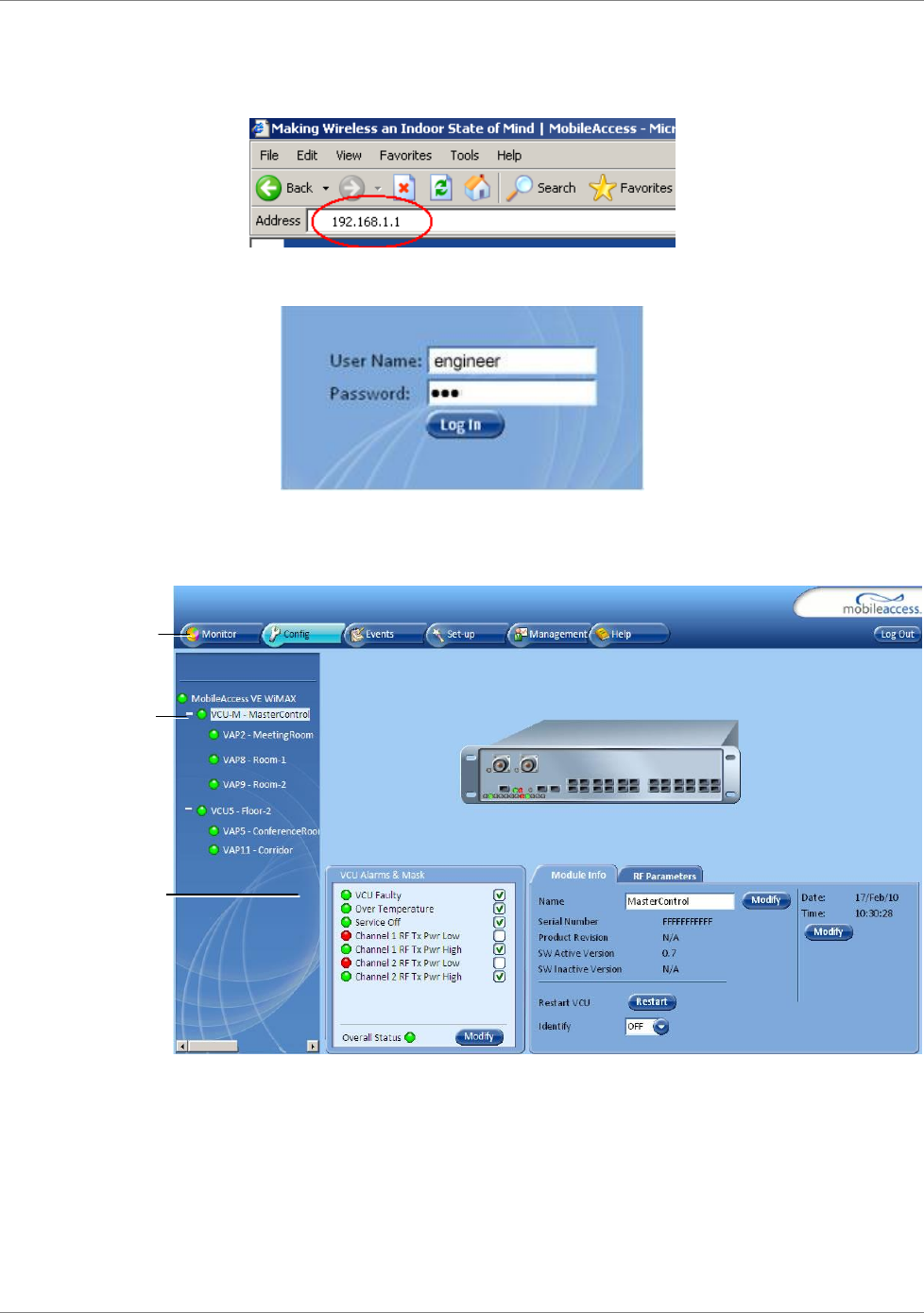
VCU Unit Installation and Configuration
MobileAccessVE WiMAX Instant Coverage Solution User Manual 29
2. Open a web browser and type the Master VCU IP address in the address bar (default:
192.168.1.1).
The Login window appears.
3. Type the User Name “engineer” and enter the Password “eng”.
The MobileAccessVE Web GUI appears.
Network Topology
tree
Sub-tabs that
correspond to each
main tab
Main menu
bar
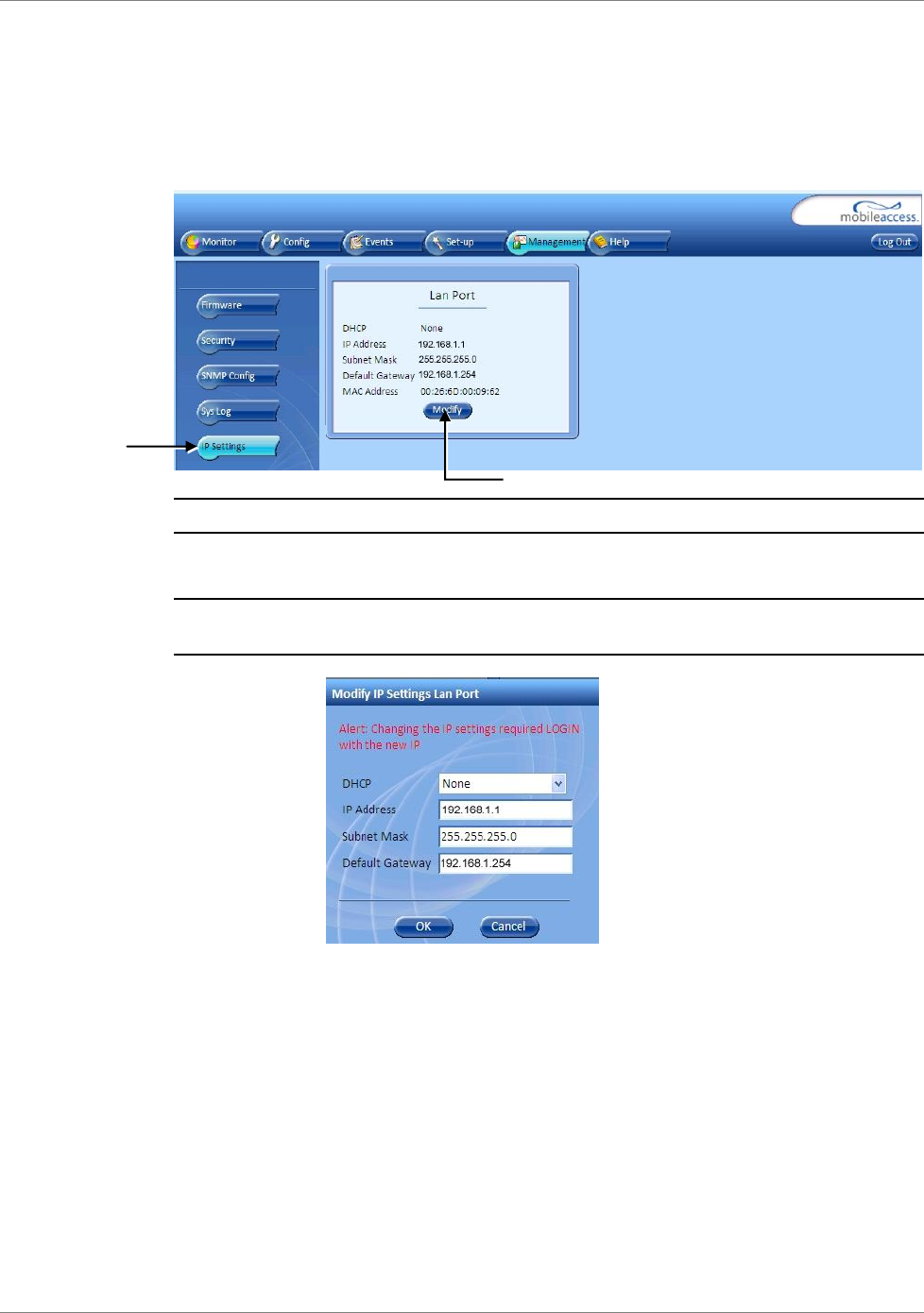
Provisioning the Master VCU
30 MobileAccessVE WiMAX Instant Coverage Solution User Manual
3.5.3 IP Settings
1. In the invoked application window, choose the Management tab in the main menu bar and
click the IP Settings tab on the side bar.
Note: See section
5.3.2 for a description of the Management tab.
2. Click the Modify button to define the STATIC IP Address according to existing LAN.
Note: After the initial IP configuration, the Master VCU can be accessed remotely via
Ethernet.
Set the Static IP address parameter (DHCP is not currently available)
Default definitions:
The Default IP Address : 192.168.1.1
The Default Subnet Mask: 255.255.255.0
The Default Gateway: 192.168.1.254
Click OK.
3. Log out and then log in again with the new IP settings.
Modify button
IP Settings
sub-tab
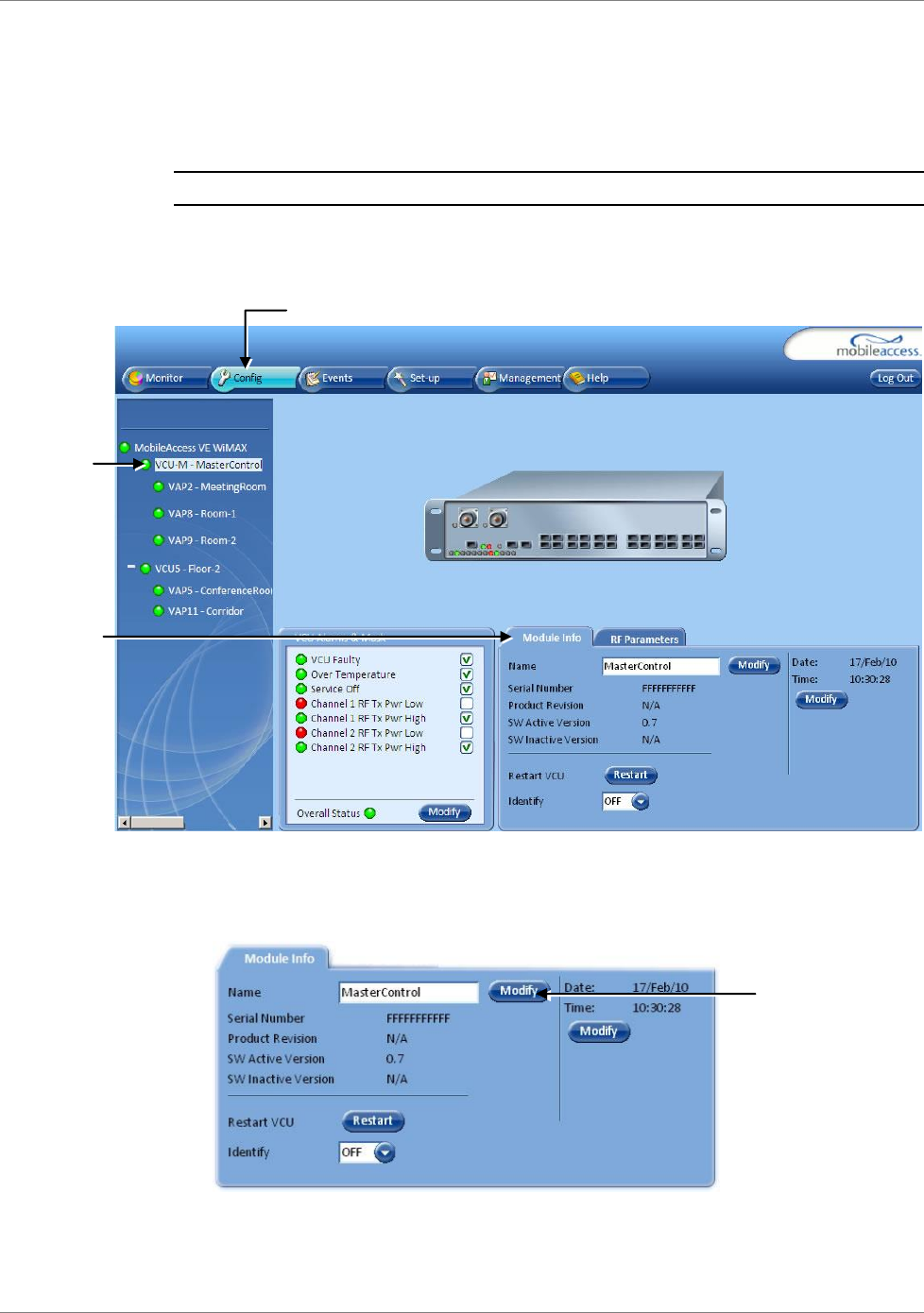
VCU Unit Installation and Configuration
MobileAccessVE WiMAX Instant Coverage Solution User Manual 31
3.5.4 Assigning Identifying Information
1. Select the Config tab in the main menu bar.
Note: See section
5.3 for a complete description of the Config tab.
2. The Master VCU appears in the Network Topology Tree as VCU-M. Select the Master VCU
by clicking on it.
3. Before configuring the Master VCU it is recommended to give the unit an indicative name. To
assign the Master VCU an indicative name:
Select the Module Info Tab and click the Name Modify button.
Click Modify
Config Tab
Master VCU
Module Info
sub-tab
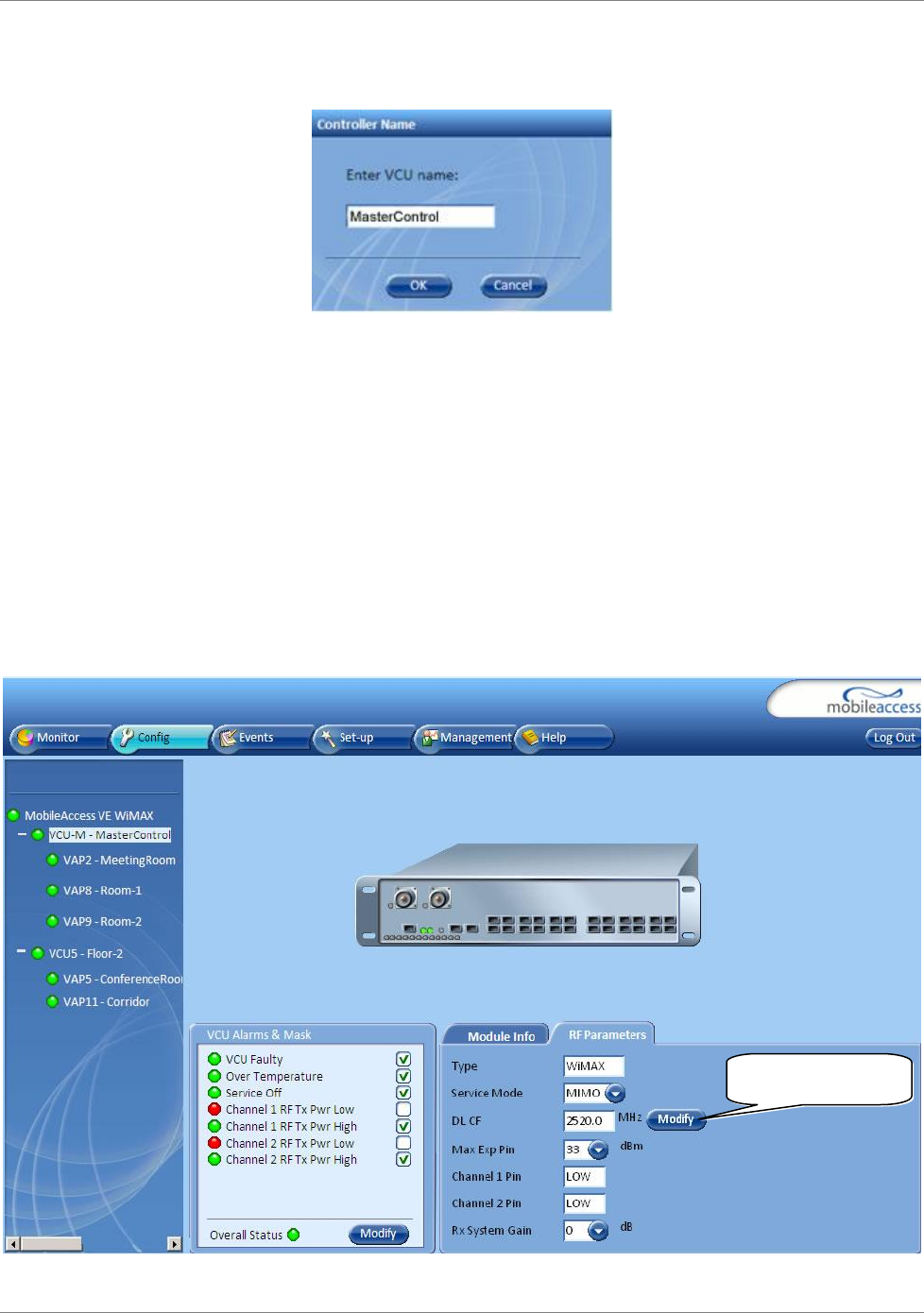
Provisioning the Master VCU
32 MobileAccessVE WiMAX Instant Coverage Solution User Manual
Type the unit name (up to 17 alpha-numeric characters) in the Controller Name dialog and
click OK.
3.5.5 Setting RF Parameters
In a Master-Slave mode (multi-tier architecture) the RF parameters are only configured for the
Master VCU unit.
Set the RF parameters according to the BS transmission configuration (MIMO or SISO). Each
type of configuration is defined through a dedicated tab.
This section describes the MIMO and the SISO configuration procedures.
To configure the MIMO RF parameters:
1. Select the Master VCU in the topology tree and then select the RF Parameters tab. Verify
that the Service Mode parameter is defined as MIMO.
Click to modify MIMO
Center Frequency
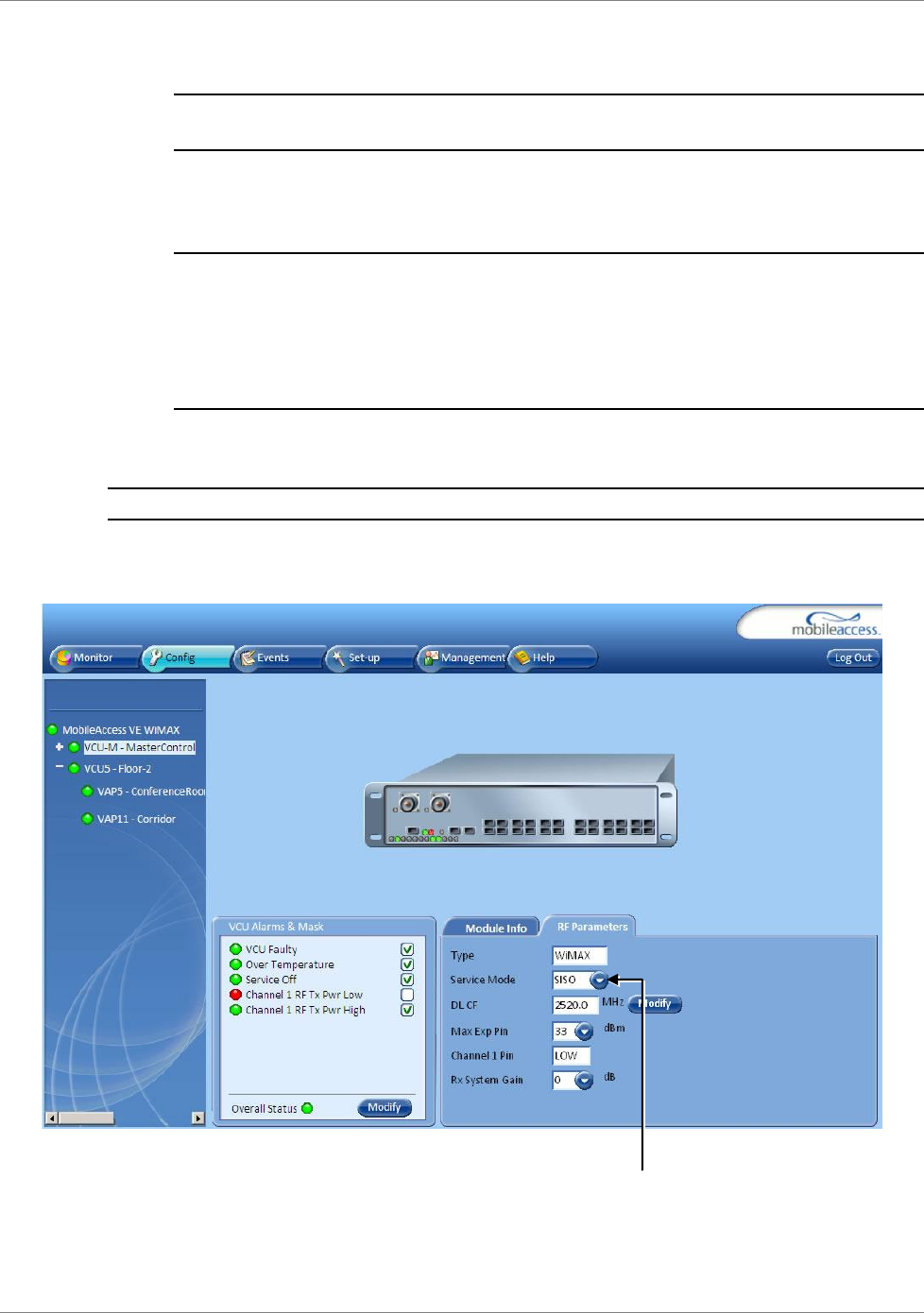
VCU Unit Installation and Configuration
MobileAccessVE WiMAX Instant Coverage Solution User Manual 33
2. Click the DL CF Modify button. Enter the Base Station central frequency and click OK.
Note: The MIMO DL CF parameter defines the same DL central frequency for Channel 1
and Channel 2.
3. Define Max expected power of BS (0-33dBm).
4. Define Rx System Gain (-15 to 5dB)
Notes:
Max expected Pin and DL CF parameters can be obtained from your service provider.
The remaining parameters are predefined to their default values. (Service Bandwidth is
set to 10MHz per channel).
Any updates of the service definition (DL CF or Service Mode) are sent to all connected
VAPs.
To configure the SISO RF parameters:
Note: The RF tab is displayed for MIMO by default.
1. Select the Master VCU in the topology tree and select the SISO option in the Service Mode
drop-down list. The RF parameters tab will display the SISO RF parameters.
2. Click the DL CF Modify button and enter the Base Station central frequency. Click OK.
Service Mode
drop-down list
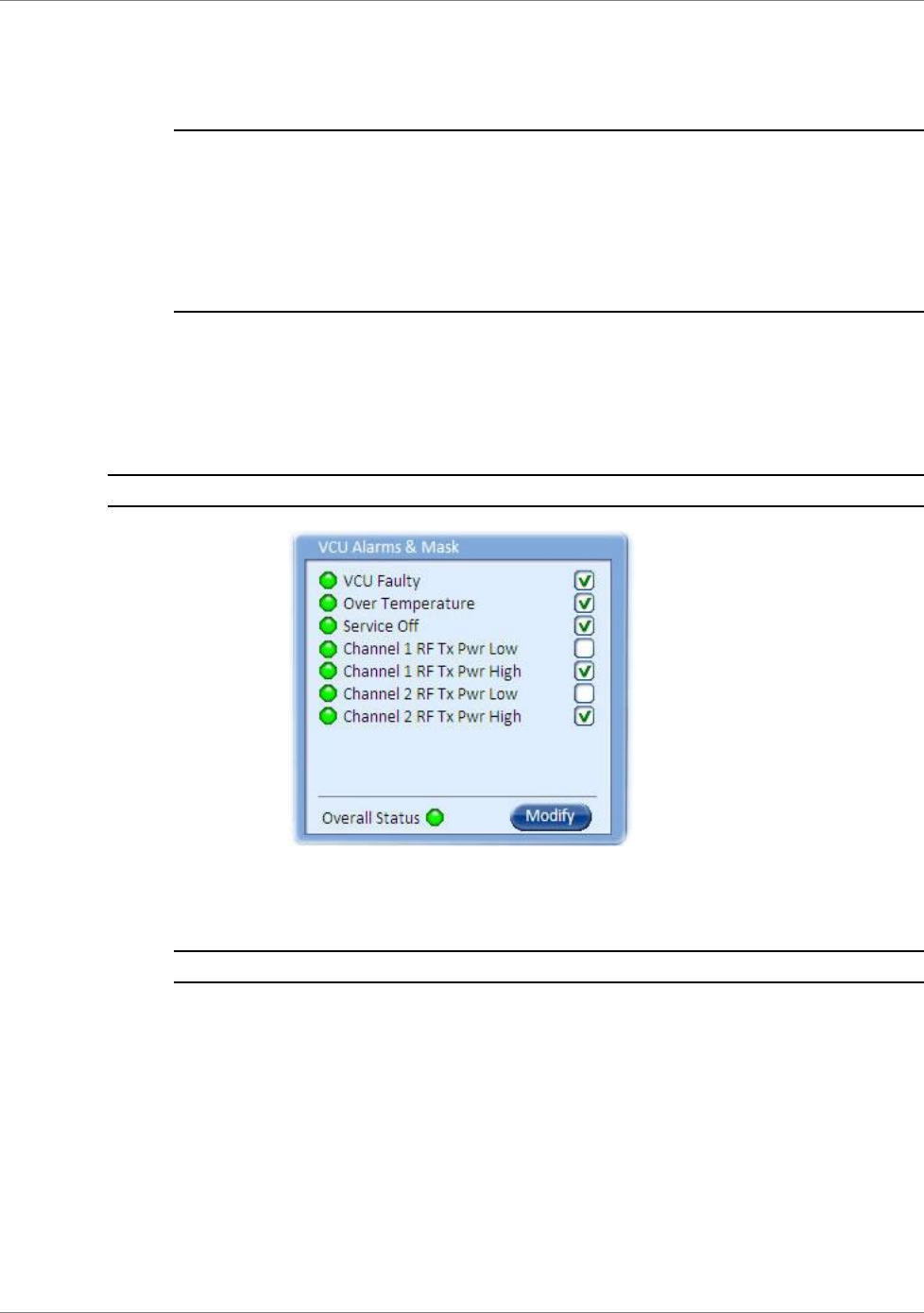
Provisioning the Master VCU
34 MobileAccessVE WiMAX Instant Coverage Solution User Manual
3. Define Max expected power of BS (0-33dBm).
4. Define Rx System Gain (-15 to 5dB)
Notes:
Max expected Pin and SISO DL CF parameters can be obtained from your service
provider.
The remaining parameters are predefined to their default values. (Service Bandwidth is
set to 10MHz).
Any updates of the service definition (DL CF or Service Mode) are sent to all connected
VAPs.
3.5.6 Verifying System Operation
To verify proper operation of the system, refer to the VCU Alarms and Mask sub-tab (in the
Config tab). The following figure illustrates the MIMO alarms.
Note: SISO alarms are similar, however only Channel 1 alarms appear.
Figure 3-3. VCU MIMO Alarms
1. Verify that all the alarms are GREEN.
Note: In the SISO Alarms dialog (Figure 4-3) only Channel 1 alarms appear.
2. Mask irrelevant alarm conditions to avoid affecting the overall status of the unit.
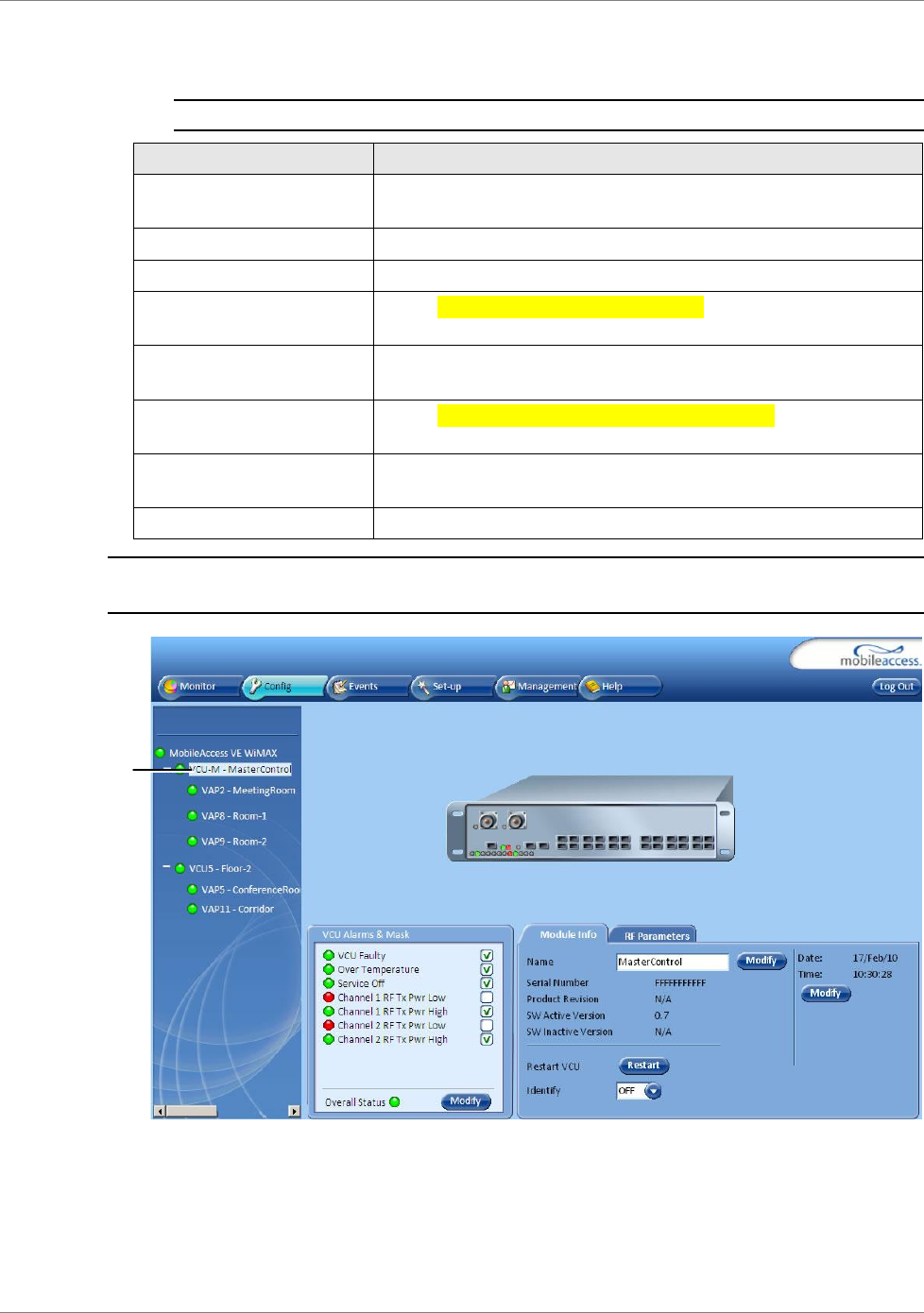
VCU Unit Installation and Configuration
MobileAccessVE WiMAX Instant Coverage Solution User Manual 35
Refer to the alarm descriptions in the table following the figure below.
Note: When SISO service is used only the Channel 1 alarms are relevant.
Alarm
Description
VCU Faulty
RED - VCU fault. Remove and re-apply power to VCU. If
problem persists, replace VCU.
Over Temperature
Temperature of unit exceeds normal range.
Service Off
User has disabled the service.
Channel 1 RF Tx Pwr Low
RED - DL RF Power is lower by 15dBm (or more) from the Max
Expected Pin, or lower than -3dBm.
Channel 1 RF Tx Pwr High
RED - the input power exceeds the maximum expected Pin by
more than 3 dB.
Channel 2 RF Tx Pwr Low
RED - DL RF Power is lower by 15dB (or more) from the Max
Expected Pin, or lower than -3dBm.
Channel 2 RF Tx Pwr High
RED - the input power exceeds the maximum expected Pin by
more than 3 dB.
Overall Status
Indicates Fault (RED) level or GREEN if there are no faults.
Note: To briefly check the VCU status, click on the VCU name in the Topology Tree. The VCU
icon will appear, showing the LEDs status.
Click VCU Master
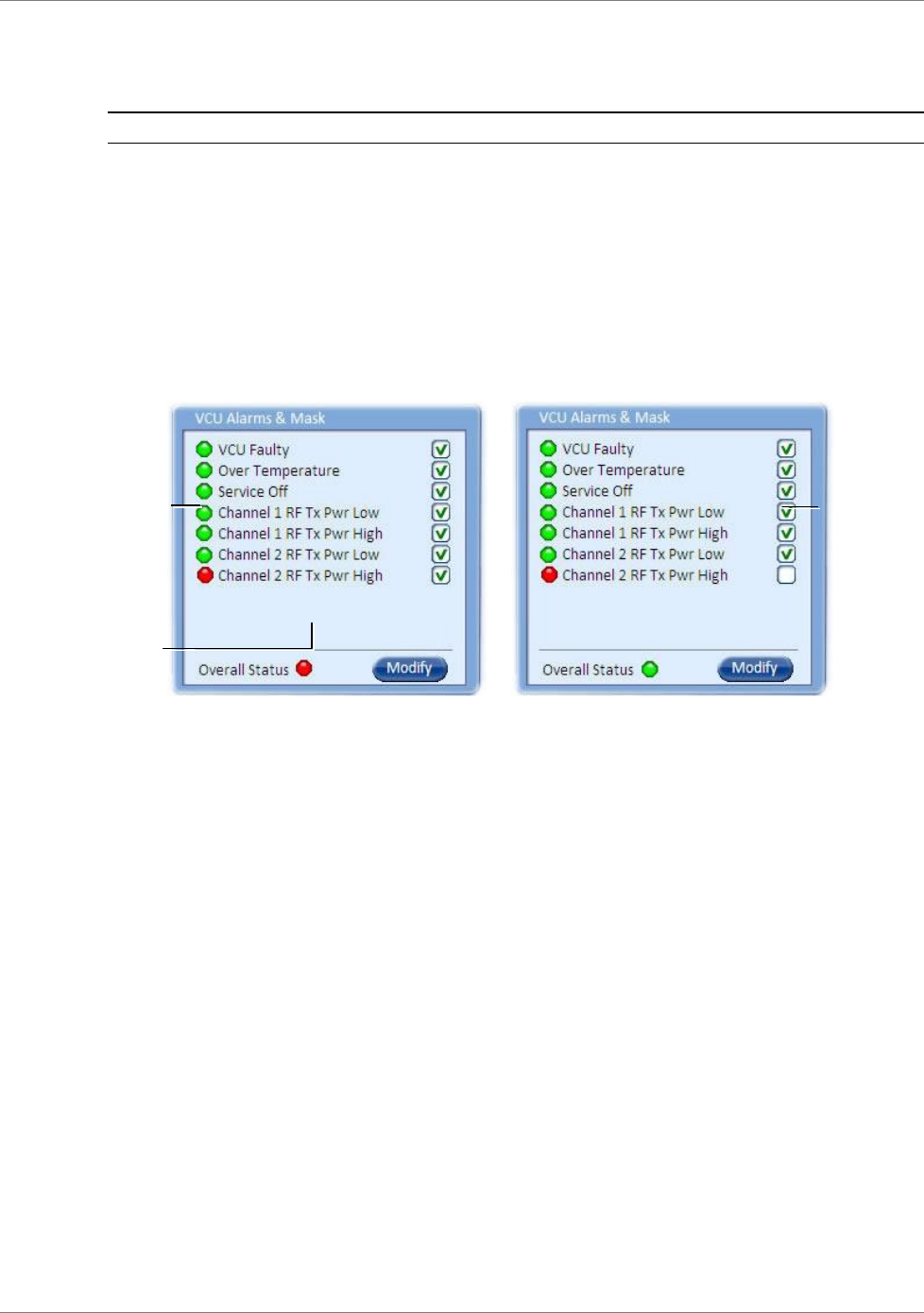
Provisioning the Master VCU
36 MobileAccessVE WiMAX Instant Coverage Solution User Manual
Example of Alarm Mask (Disabling)
NOTE: Tx signal refers to the DL signal from the BS side towards the remote units (VAPs).
In the example below “Channel 2 RF Tx Pwr High” alarm is masked (disabled) – this is the alarm
for the DL signal (from the BS side)
.
The left dialog shows the alarm response when MIMO2 Tx RF Pwr High alarm is enabled and a
fault corresponding to that alarm is detected. (MIMO2 Tx RF Power exceeds the defined range).
The Overall Status will be RED indicating a fault.
The right dialog shows the alarm response when MIMO2 Tx RF Pwr High alarm is disabled
(MASKED). The MIMO2 Tx RF Pwr High LED be RED; but, the Overall Status will be GREEN –
showing NO Fault.
Figure 3-4. Enabled alarm showing fault Figure 3-5. Disabled alarm showing fault
Channel2
RF Tx Pwr
High alarm
masked
(disabled)
Channel2 RF Tx
Pwr High alarm
unmasked (enabled)
Overall status RED
- accordingly
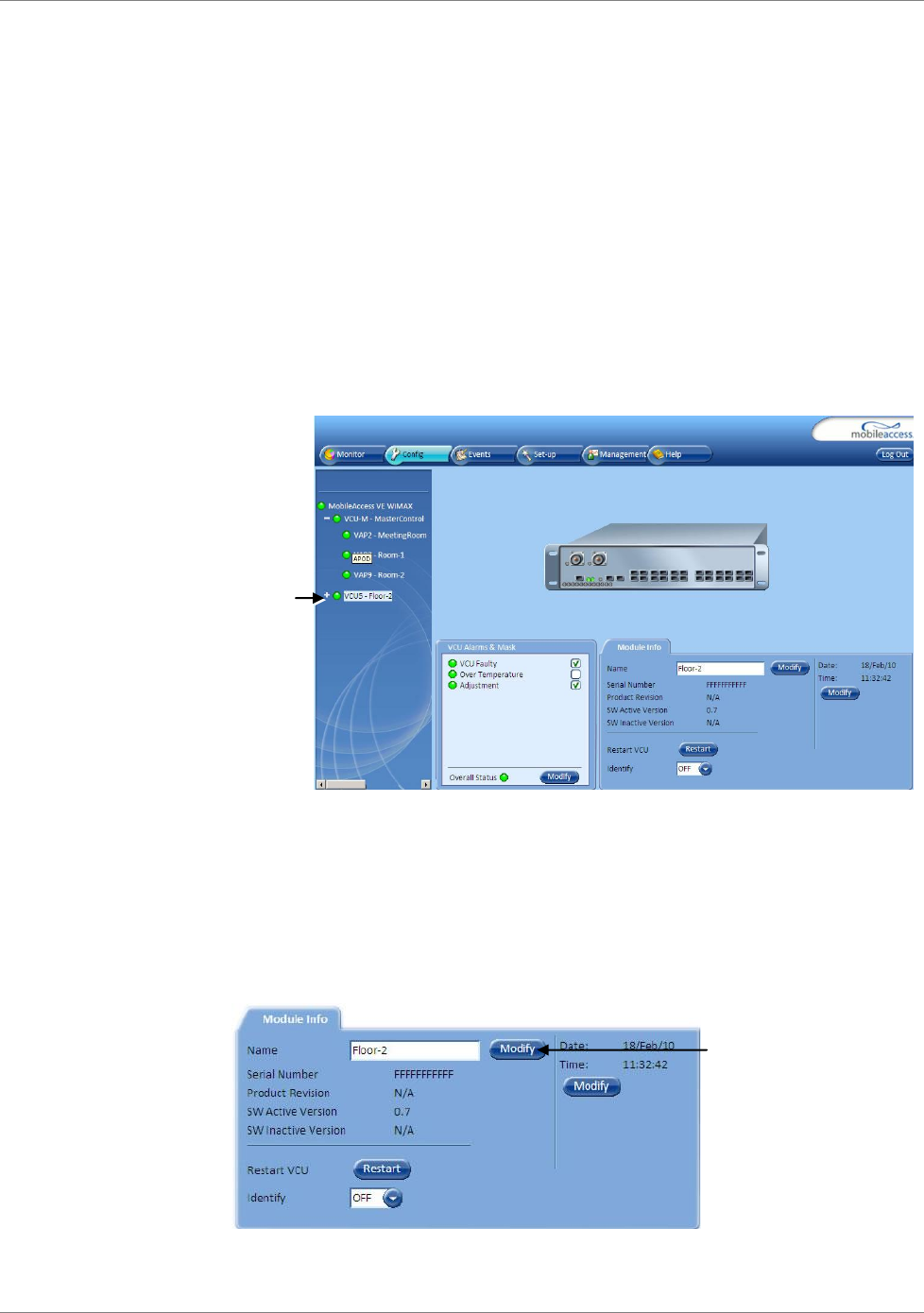
VCU Unit Installation and Configuration
MobileAccessVE WiMAX Instant Coverage Solution User Manual 37
3.6 Assigning the Slave VCU an Identifiable Name
The Slave VCU RF parameters are automatically configured according to the Master VCU
definitions; there is no need to configure the RF parameters individually for each connected
Slave VCU. It is recommended to assign each Slave VCU an indicative name.
The Slave VCU options are accessed performed through a remote connection to the Master VCU,
via the web management.
To assign a name to a Slave VCU:
1. Connect to the Master VCU unit (either locally as explained in section 3.5.1 or remotely) and
select the Slave VCU to be provisioned from the Network Topology Tree.
Each VCU has a default name of the form “VCUPx-name”, where:
Px - Master VCU port number to which the Slave VCU is connected
Name - user-defined name
2. To assign the Slave VCU an indicative name:
Select the Module Info Tab
Click the Name Modify button
Type the unit name (up to 17 alpha-numeric characters) and click OK.
Click Modify
Selected Slave
VCU-
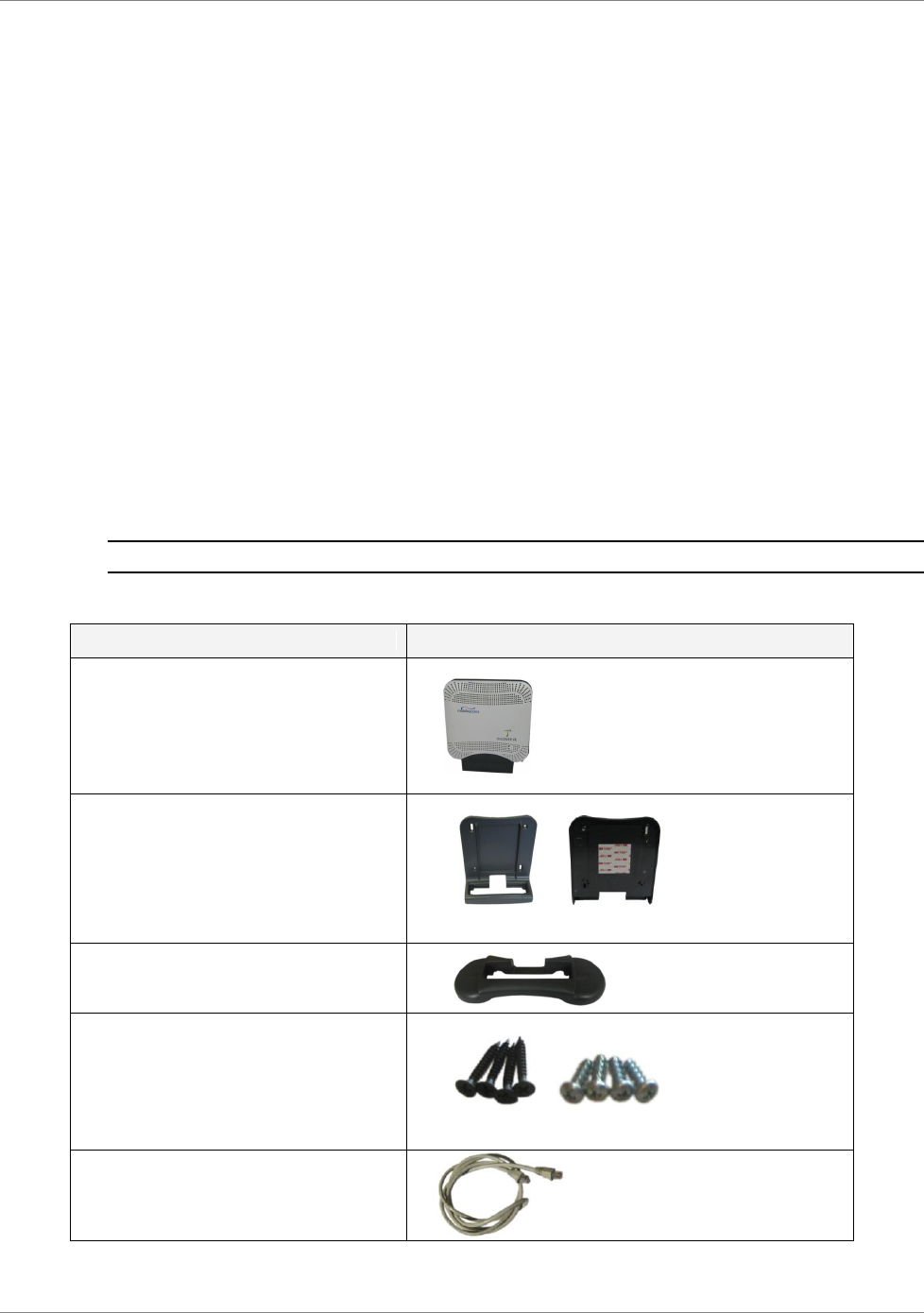
VAP Installation
38 MobileAccessVE WiMAX Instant Coverage Solution User Manual
4 VAP Installation and Provisioning
This section provides a description of the VE Access Pods (VAPs) installation and verification of
normal VAP operation. The VAPs are designed for plug-and-play installation.
The only required configuration is for VAPs to which external antennas are connected since by
default, VAPs are provided to operate with their internal antennas.
4.1 VAP Installation
The VAPs installation procedure consists of connecting each VAP to the Ethernet jack in the
appropriate location to provide optimal coverage (see sections 2.3 and 4.1.2).
4.1.1 VAP Kit Contents
The WiMAX VE Access Pod (VAP) kit includes:
Note: VAPs are provided with two mounting options: desk-mount and wall-mount
Table 3: VAP Kit
Kit Items
UNIT
VE Access Pod (VAPs)
Wall-mount adaptor (with double
sided sticky tape located on rear for
fast installation)
Desk-mount adaptor
8 screws:
o 4 short screws – for securing
adaptor to pod
o 4 longer screws – for securing
wall-mount adaptor to the wall
(“anti-theft” installation)
RJ-45 jumper cable
Front
Rear – showing tape
Long screws
Short screws

VAP Installation and Provisioning
MobileAccessVE WiMAX Instant Coverage Solution User Manual 39
4.1.2 VAP Locations and Mounting
It is recommended to place the VAPs on top of desks, cube walls, filing cabinets or higher on
walls so as to maximize the provided coverage per VAP.
Note: Mounting a VAP beneath a desk or other low location (e.g office corner) decreases the
effective coverage of the VAP and therefore a higher number of VAPs would be required to cover
the same area.
When installing the VAPs, consider the following:
Placing the units (whenever possible), in an open area
Availability of CAT-5e/6 infrastructure
The VAPs plug into standard (RJ-45) Ethernet connection jacks.
If the jack to be used is already connected to Ethernet switch. For more information see
2.4.2 and 3.4.
Aesthetics of the VAP location
4.1.2.1 Desk Mount
Place the VAP on the Desk-mount
Secure the Desk-mount adaptor to the VE Access Pod using the four supplied short screws.
Connect the RJ-45 jumper cable (CAT-5e/6) to the VAP‟s RJ-45 connector to be connected to
the VCU (the adaptor, screws and cable are included in the VAP kit).
Place the VAP on a flat surface according to the planned location
Plug the other side of the cable into standard (RJ-45) Ethernet connection jack of the cable
which is routed to the VCU.
When using an external antenna, connect the Ext. Antenna SMA connector(s) to the external
antenna(s). This option must be SW configured via the web GUI (internal antenna is enabled
by default).
Note: The maximum external antenna gain should not exceed 10 dBi.
Verify that the VAP receives power and connects to the VCU via the LEDs on the unit (both
the GREEN LED and the BLUE LED should be lit).
+ =
Desk-mount adaptor
Access Pod
Ext. Antenna SMA
connector
RJ-45 to
computer
Ext. Antenna SMA
connector
RJ-45 to
VCU
Blue LED
Green LED
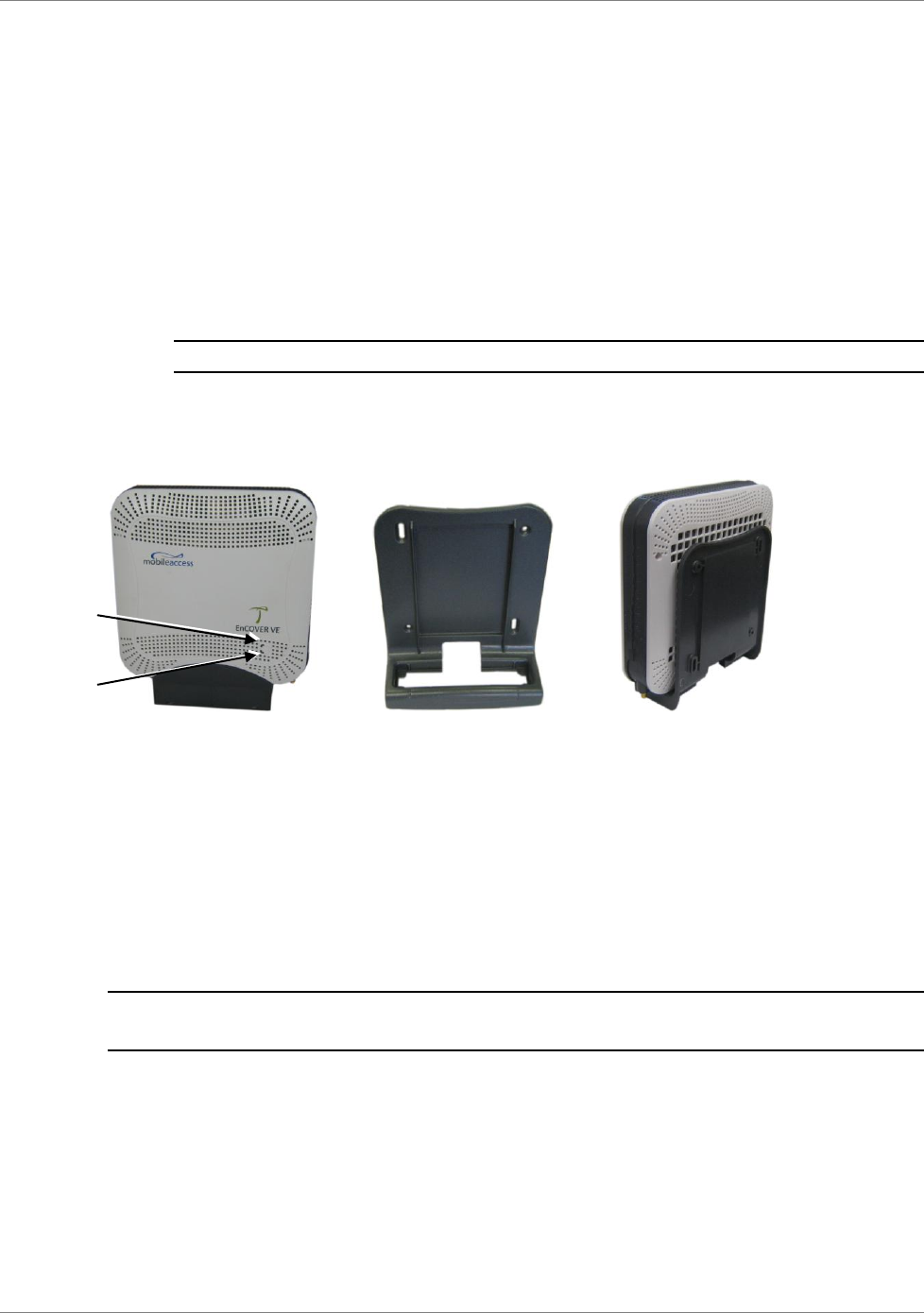
Verifying VAP Coverage Area
40 MobileAccessVE WiMAX Instant Coverage Solution User Manual
4.1.2.2 Wall Mount
Assemble the VAP to the wall-mount (the adaptor with sticky tape and wall mount screws and
cable are included in the VAP kit as described in Table 3: VAP Kit)
Attach the VAP to the wall according to the planned location using supplied screws (for “anti-
theft” installation) or the double sided sticky tape for the wall-mount adaptor located on the
rear (for “plug-and-play” installation)
Plug the other side of the cable into the adjacent standard (RJ-45) Ethernet connection jack.
When using an external antenna, connect the Ext. Antenna SMA connector(s) to the external
antenna(s). This option must be SW configured via the web GUI (internal antenna is
enabled by default).
Note: The maximum external antenna gain should not exceed 10 dBi.
Verify that the VAP receives power and connects to the VCU via the LEDs on the unit (both
the GREEN LED and the BLUE LED should be lit).
+ =
4.2 Verifying VAP Coverage Area
Verify coverage in the areas, adding and moving VAPs for optimal coverage according to the
principles described in 2.3.
4.3 Provisioning the VAPs
Note: This section provides only the information required for provisioning the VAPs. For a full
description of the VAP configuration options, refer to Chapter
7
The VAPs are auto-discovered by the VCU and can be monitored via a remote or a local
connection to the system Master VCU.
You may (optional) assign each VAP an identifiable name corresponding to its physical location.
The only
required
configuration is for VAPs to which external antennas are connected.
Access Pod
Wallmount Adaptor
Assembly
Blue LED
Green LED
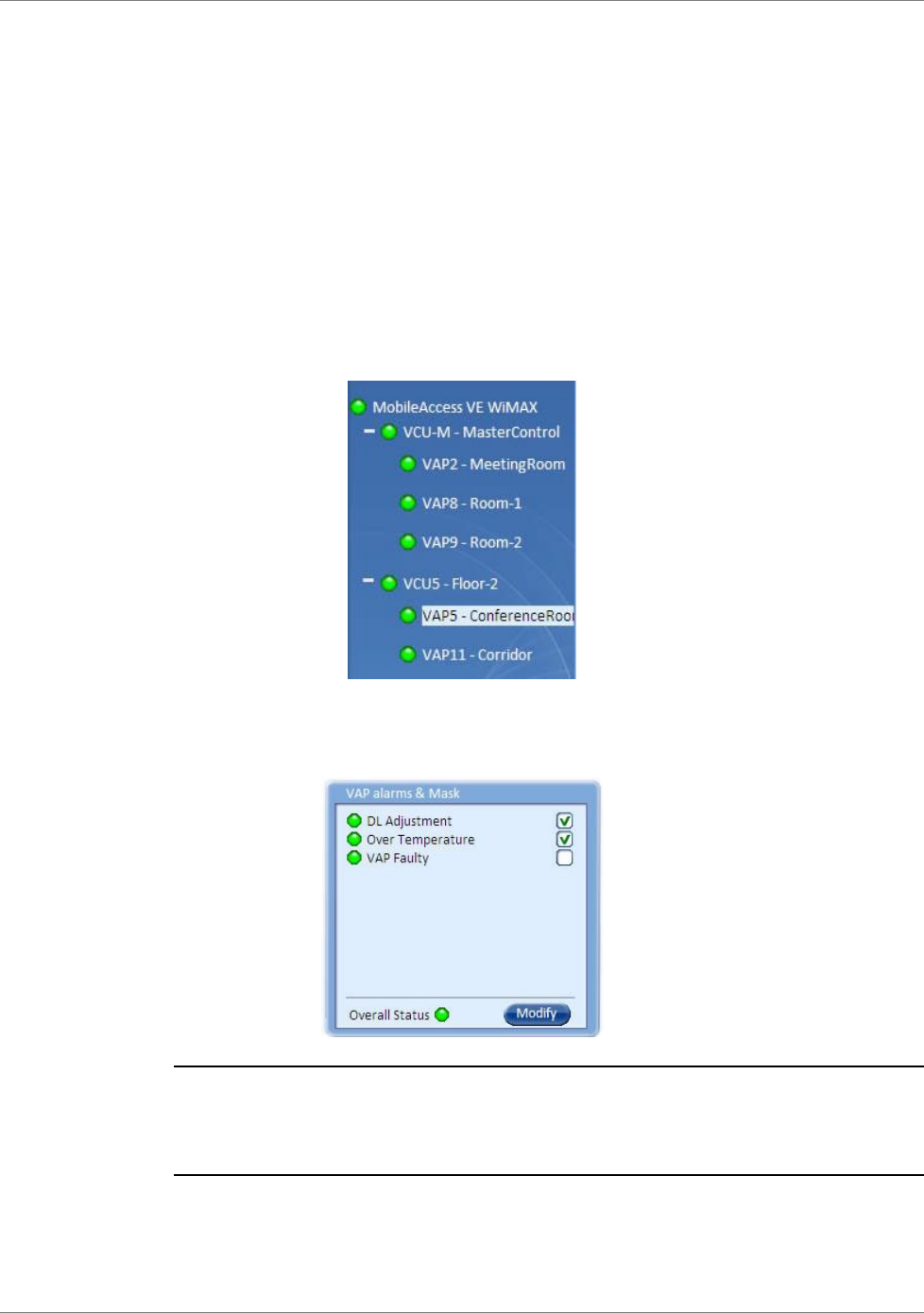
VAP Installation and Provisioning
MobileAccessVE WiMAX Instant Coverage Solution User Manual 41
4.3.1 Verifying Normal VAP Operation
Use the MIMO/SISO RF and Module Info sub-tabs to review the VAP information and status.
1. If a session in not already open to the MobileAccessVE Web GUI application, open a session
to the Master VCU according to section 3.5.1.
2. Select a VAP from the Network Topology Tree.
Each VAP has a default name showing the number of the Slave VCU port to which the VAP is
connected.
3. To verify normal operation of the VAP:
In the Network Topology Tree, under the Control Unit, verify that a GREEN LED is
displayed (either RED or GREEN) for each connected VAP.
If the VAP LED is RED, select the VAP from the network topology tree then select the
Config tab. Refer to the Alarms tab work area. Use the displayed alarms to identify the
problems.
Note 1: VAP alarm mask is saved in the VCU, associated with the port to which the VAP
is connected. In case you replace the VAP, the newly installed VAP will automatically be
set with same alarm mask.
Note 2: For more information on the VAP Alarms, refer to section
0.
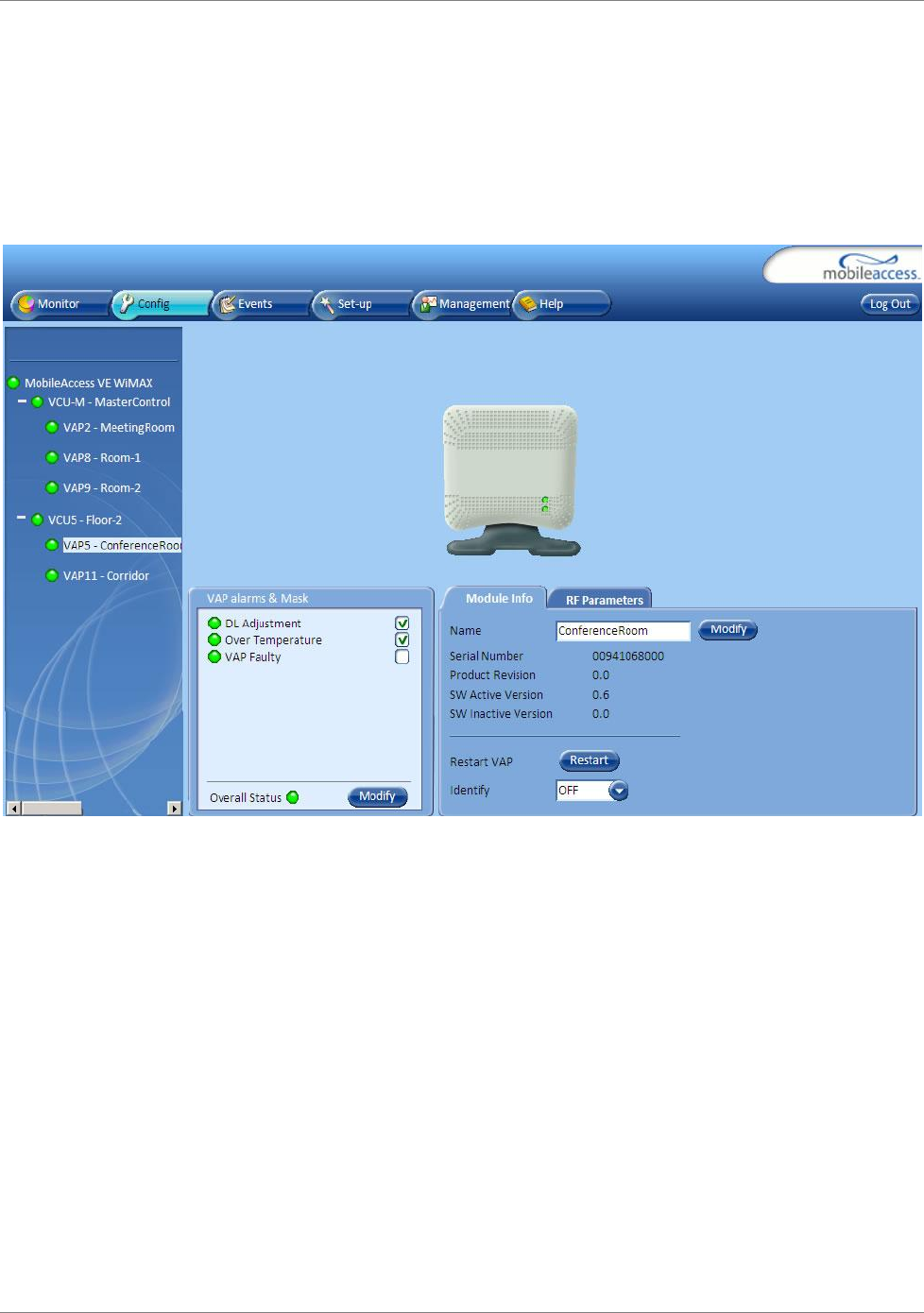
Provisioning the VAPs
42 MobileAccessVE WiMAX Instant Coverage Solution User Manual
4.3.2 Naming the VAP
To assign the VAP an identifiable name:
Open the Config Module info tab.
Click the Modify button.
Type the unit name (up to 17 alpha-numeric characters) and click OK.
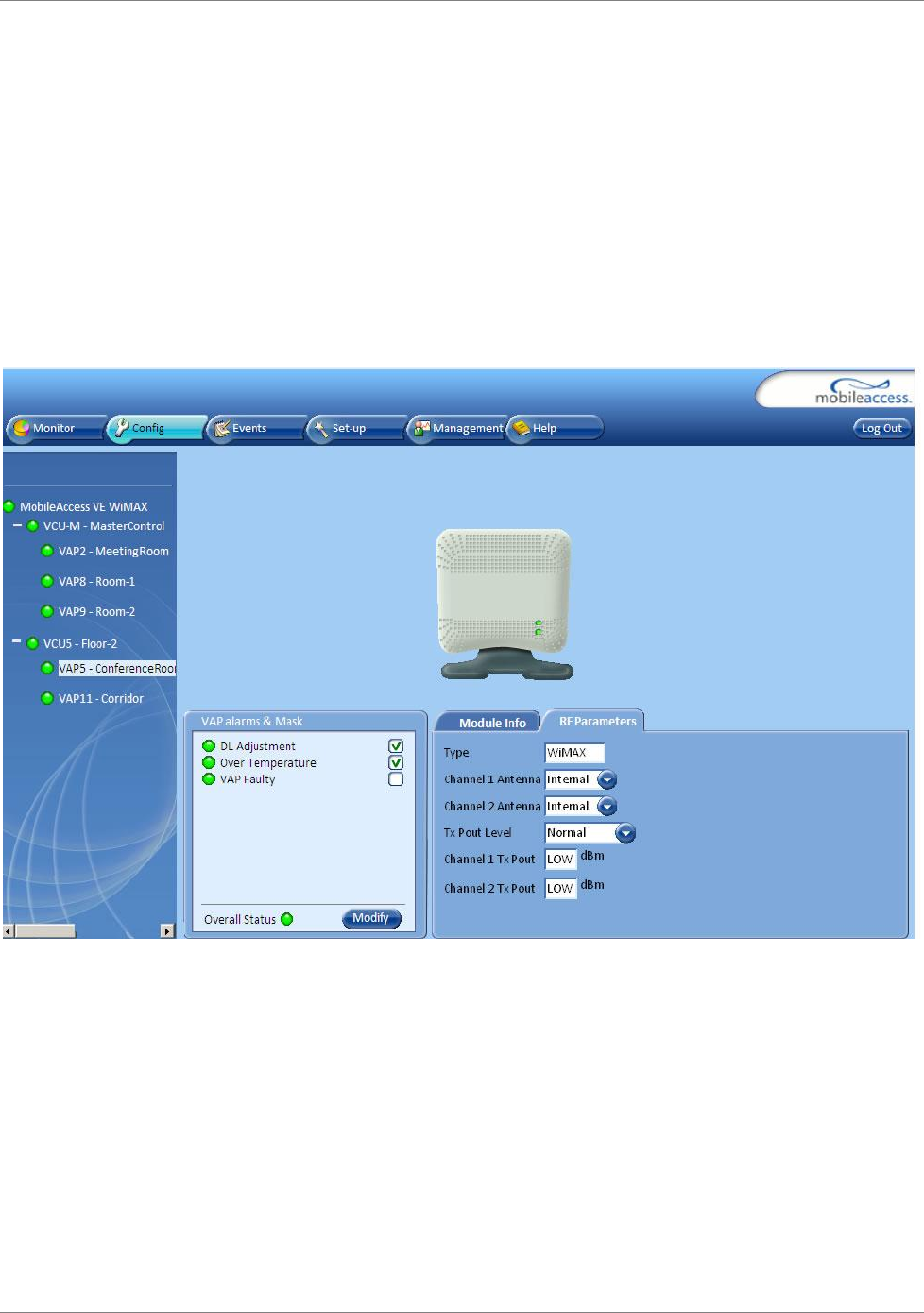
VAP Installation and Provisioning
MobileAccessVE WiMAX Instant Coverage Solution User Manual 43
4.3.3 Configuring VAP for External Antenna
By default, the VAPs are set to operate using the internal antennas.
Use the procedure described in this section to configure all VAPs to which external antennas are
connected.
To configure for operation with external antennas
Select the relevant VAP from the Topology Tree.
Select the RF Parameters sub-tab.
Set the Channel 1/2 antennas as External.
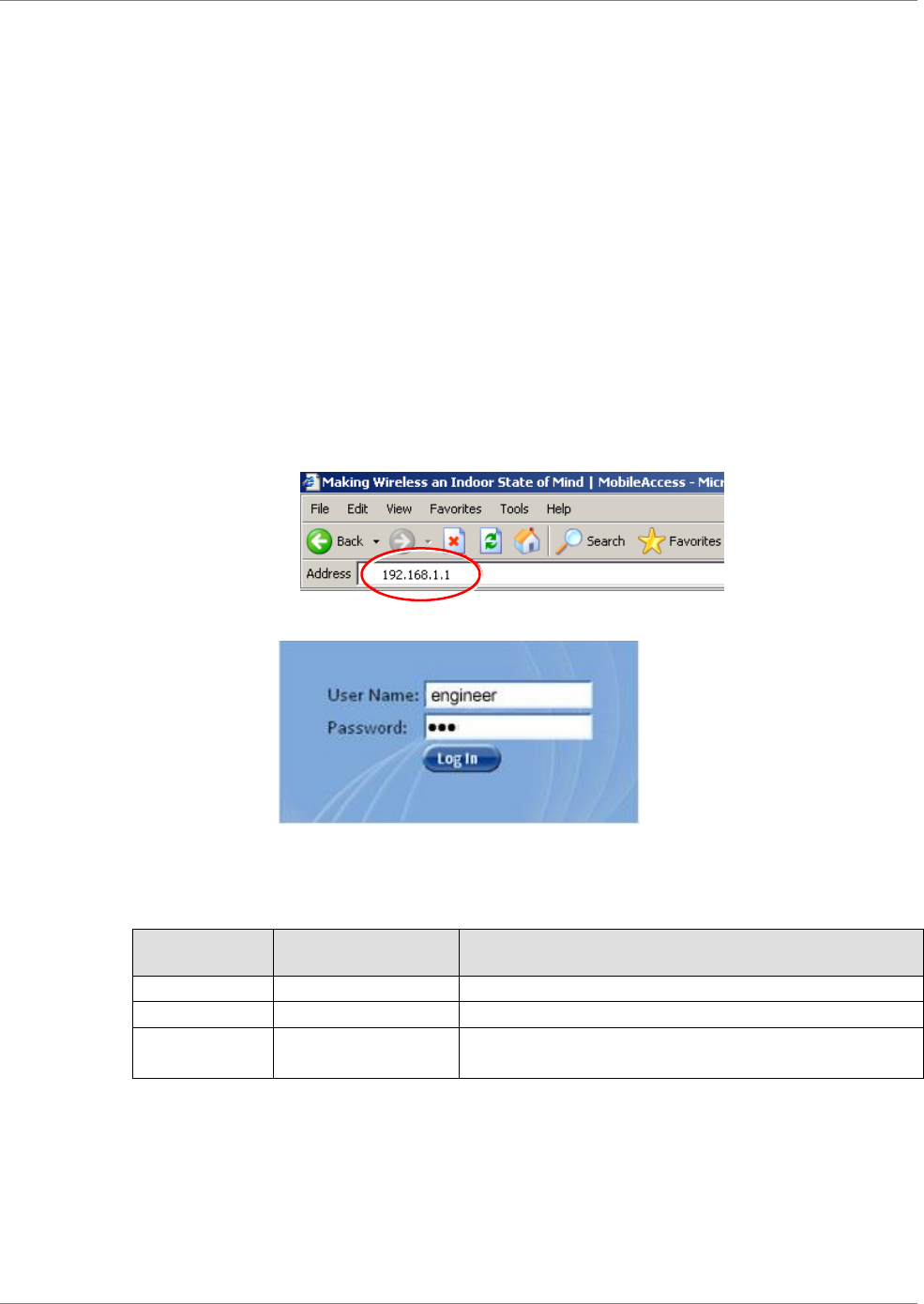
Opening a Session and Authentication Levels
44 MobileAccessVE WiMAX Instant Coverage Solution User Manual
5 Navigating the Web Access Application
The MobileAccessVE Web management application is accessed through any standard web
browser connected to the Master VCU via a network within the same subnet as the Master VCU
or a different subnet which is routable.
5.1 Opening a Session and Authentication Levels
After the initial configuration (as explained in 3.5.1) the MobileAccessVE system can be accessed
via the network.
To access the system:
1. Open a web browser and type in the address bar the Master VCU‟s IP address as you set it
in the Master VCU configuration operation (see section 3.5.1).
2. The Login pane appears.
Enter your User Name and type in your password. The following authentication levels are
available:
Level
Default
Password
Access
operator
oper
This user has Read-Only access.
engineer
eng
This user has access to basic configuration options.
admin
ma98
This user has Field Engineer permissions in addition
to access to changing passwords.
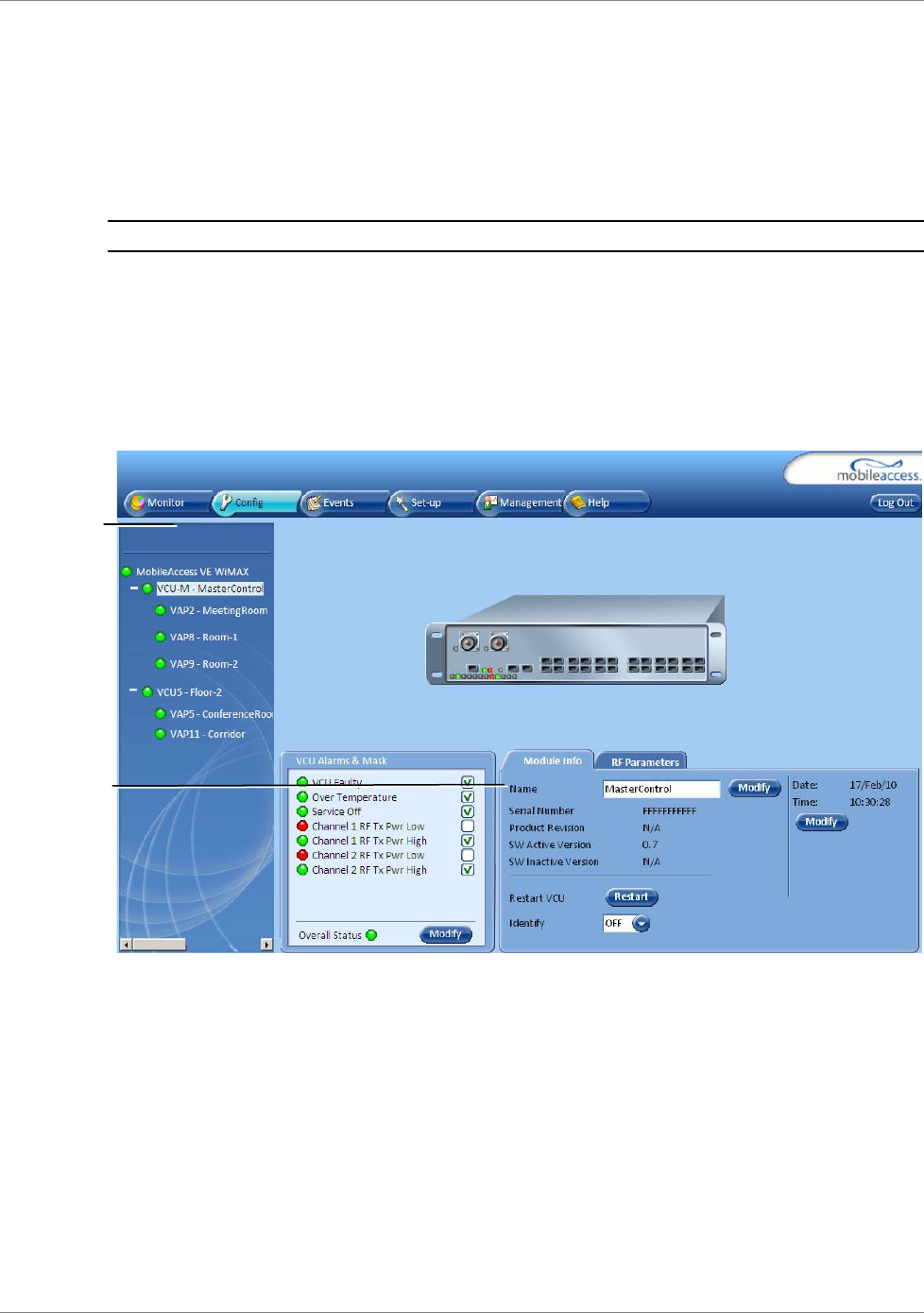
Navigating the Web Access Application
MobileAccessVE WiMAX Instant Coverage Solution User Manual 45
5.2 About the MobileAccessVE Web Access Window
The MobileAccessVE Web window includes six main tabs that provide access to the applications‟
main options, where the Config tab is displayed by default.
Note: The Monitor, Events, Setup and Help tab are future options.
The appearance of the screens varies according to the tab displayed. The Main Menu Bar tabs
are:
Config(uration) – Displayed by default upon login. Provides the selected units‟ configuration
parameters and alarms
Management - Provides upgrade, IP configuration and security options
Both of these tabs are described in detail in the following sections.
Menu bar
Sub-tabs
corresponding
to menu bar
options
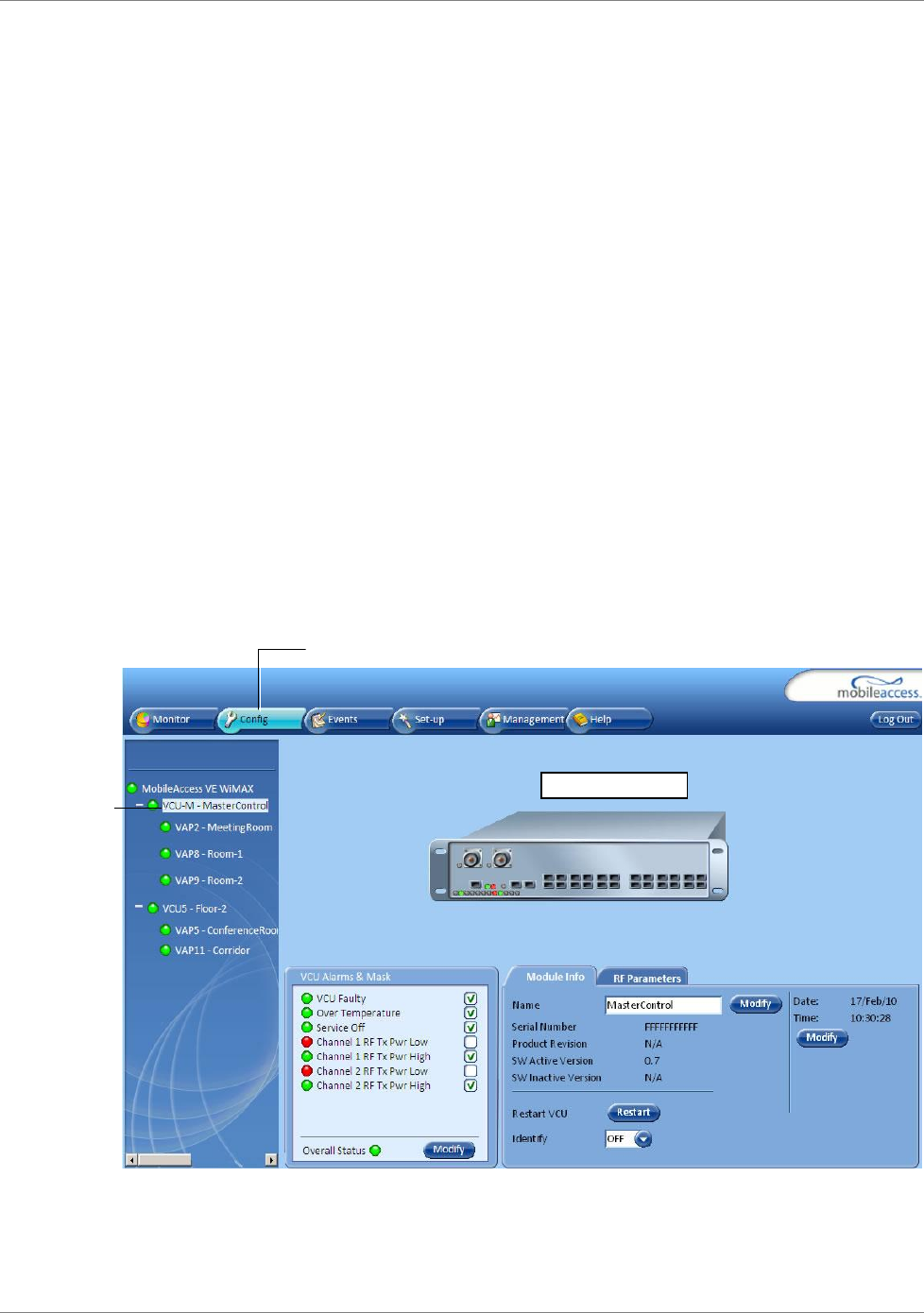
Configuration Tab
46 MobileAccessVE WiMAX Instant Coverage Solution User Manual
5.3 Configuration Tab
The Configuration tab provides the general information and service RF parameters for
configuration of the units appearing in the Network Topology tree. VCU Configuration Options
To access a VCU Configuration tab
Select a Master VCU/Slave VCU from the network topology tree on the left hand side of the
window a click the Configuration tab from the menu-bar. The information and parameters
displayed in the Configuration sub-tabs vary depending on whether a VCU or VAP is selected in
the topology tree.
The Configuration tab is divided in to three main areas:
Network Topology Tree – Displays the system units (Master VCU, Slave VCUs and VAPs) and
their status
Display area – Displays the icon of the unit (Master VCU/Slave VCU or VAP) selected in the
Topology Tree; the display includes the LED statuses. When selecting an element
Work area – Displays the Module Info, alarms and RF tabs corresponding to the unit selected
in the topology tree (Master VCU, Slave VCU or VAP)
Selected VCU
VCU Icon display
Configuration tab
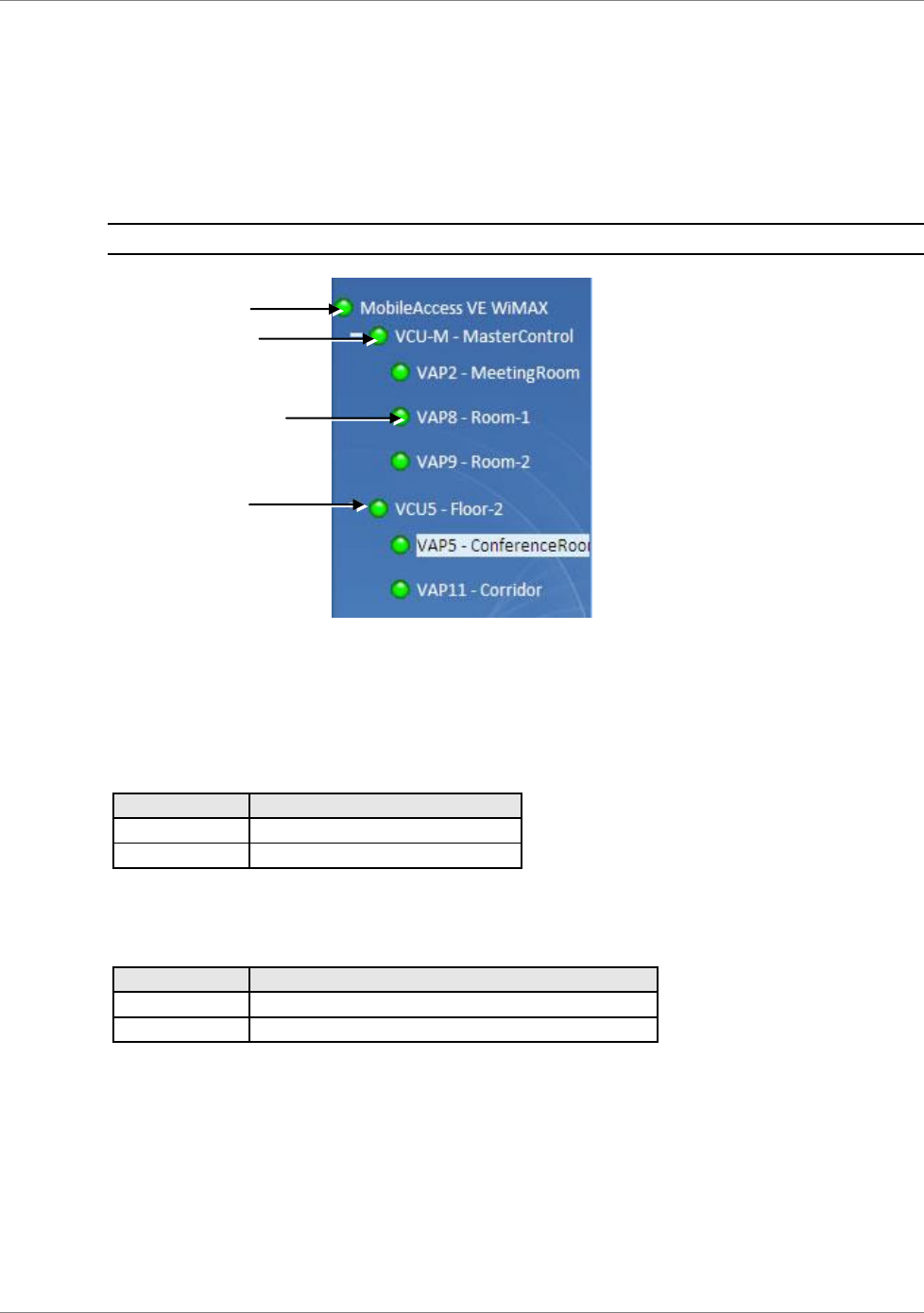
Navigating the Web Access Application
MobileAccessVE WiMAX Instant Coverage Solution User Manual 47
5.3.1 Network Topology Tree
The Configuration Network Topology Tree appears on the left hand side when the Config tab is
selected and displays the Master VCU, Slave VCUs and VAPs in two levels:
First level – VCU
Second level – Up to 12 VAPs
Note: The root is MobileAccess VE.
Each unit is assigned a Type Px-name:
Type – VCU-M, VCU or VAP (for Master VCU, Slave VCU or VE Access Pod)
Px - VCU port number
Name – user defined
Each unit is displayed with a colored bullet that indicates its‟ status:
Color
Indicates
Green
OK
Red
Alarm Condition
The root (the entire MobileAccessVE site) is also associated with a colored bullet that indicates
the overall status of the deployment:
Color
Indicates
Green
OK
Red
Alarm Condition in one or more VCUs or VAPs
Root
Master VCU –
first level
VAP – second level
Slave VCU – first
level
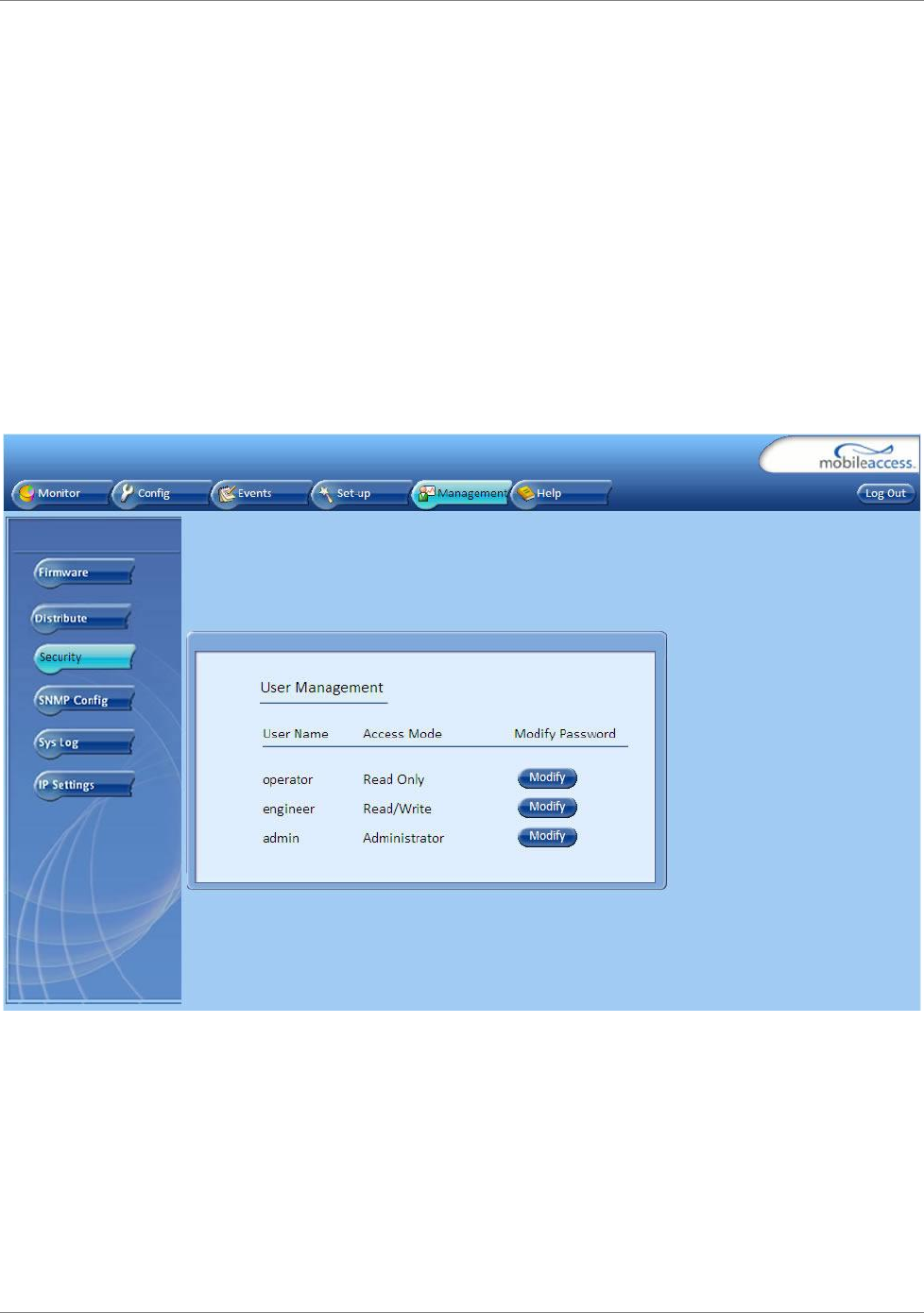
Configuration Tab
48 MobileAccessVE WiMAX Instant Coverage Solution User Manual
5.3.2 Management Tab
The Management tab provides the user administrative management options and includes the
sub-menu tabs:
Firmware – Used for upgrading/downgrading SW to VCUs
Distribute – Used for distributing the upgrade/downgrade SW files to the VAPs
Security – Used for changing user passwords
SNMP Config – Used for defining the SNMP communities and trap destinations
IP Settings – Used for viewing and modifying the network parameters
Sys(tem) Log – N/A
The following figure shows the Management screen with the menu options on left (Security
dialog is displayed here).
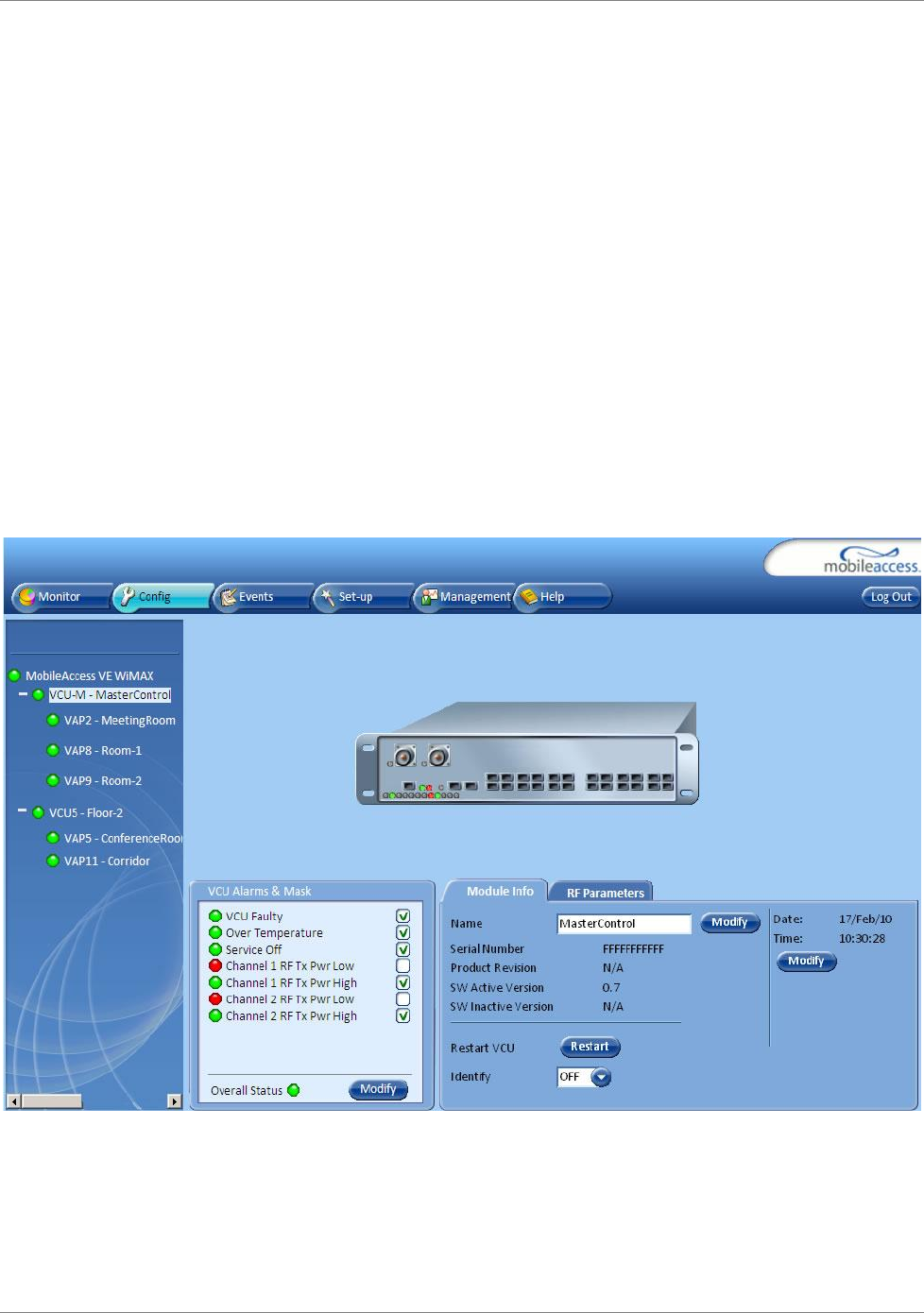
VCU Monitoring and Configuration
MobileAccessVE WiMAX Instant Coverage Solution User Manual 49
6 VCU Monitoring and Configuration
6.1 Viewing VCU General Information
The VCUs general information (such as unit name and SW versions) can be viewed in the Config
Module Info sub-tab.
The tab includes two additional options:
Identify button - Enabling this option enables finding the physical location of the selected
element (see 9.1). When this option is set to ON, the LEDs on the corresponding VCU
flickers.
Reset button - SW reset of the unit
To view VCU general information
Click the Config tab from the main menu and select the VCU from the network topology tree.
The Module Info sub-tab is displayed by default.
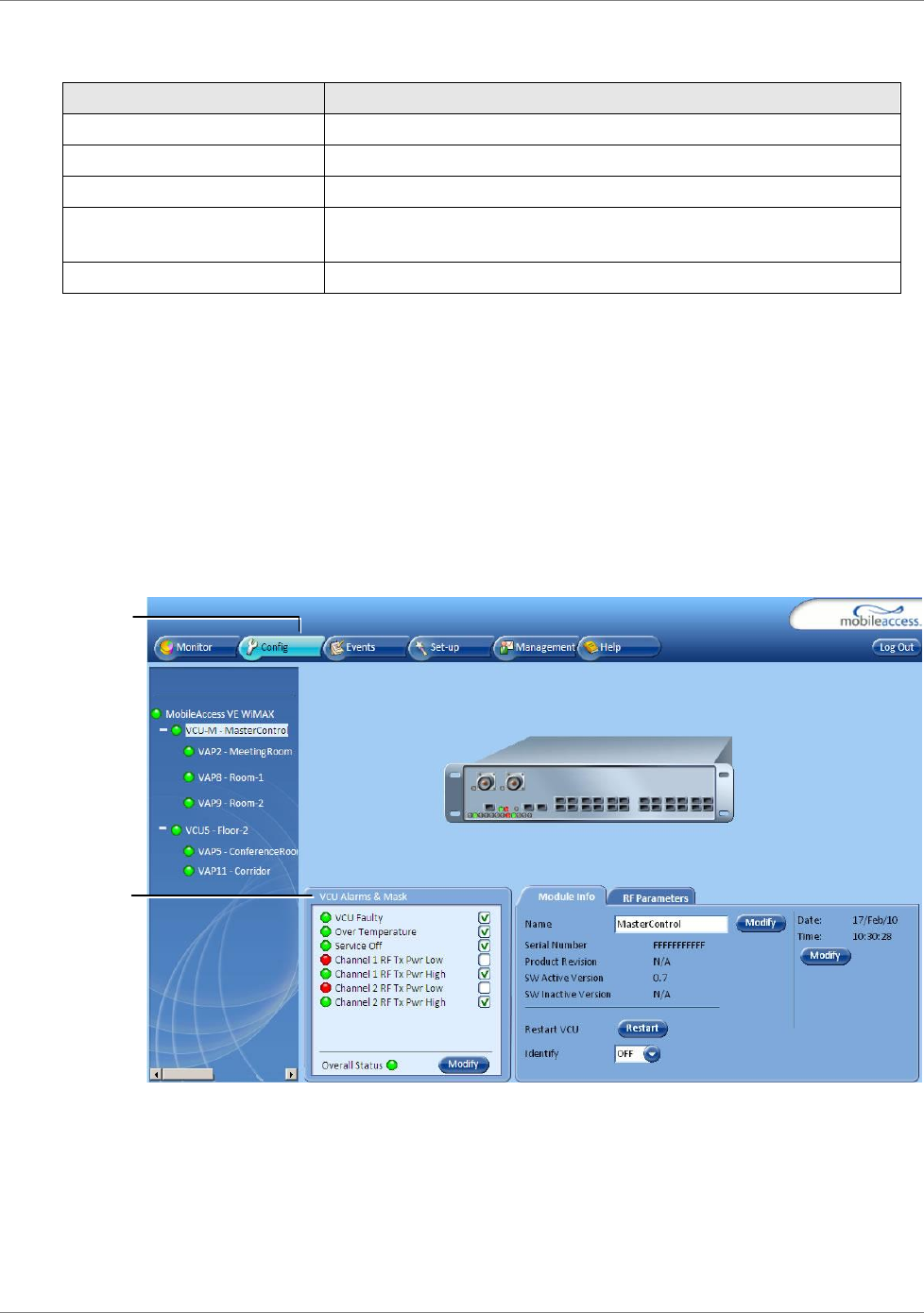
Viewing VCU Alarms
50 MobileAccessVE WiMAX Instant Coverage Solution User Manual
The following information is displayed:
Field
Description
Name
User defined name for system element (up to 17 characters)
Serial Number
Factory set ID number
Product Revision
Revision number of VCU/VAP
SW Active Version
Version of the SW currently being used to manage and monitor
the system
SW Inactive Version
Version of other system SW version not in use
6.2 Viewing VCU Alarms
The alarms displayed in the Alarms tab correspond to the VCU (Master/Slave) selected in the
topology tree. When a VCU element is selected in the topology tree, the Alarm tab displays the
main alarms in the unit.
To view VCU Alarms
In the Topology Tree, click the Control Unit (VCU), click the Config(uration) tab in the menu
bar located at the top of the window and refer to the VCU Alarms and Mask sub tab.
If one or more alarms occur, the corresponding Status indicator is illuminated in RED. If the VCU
is OK and no fault occurs, the Overall Status indicator will show GREEN.
Config tab
VCU Alarms
and Mask

VCU Monitoring and Configuration
MobileAccessVE WiMAX Instant Coverage Solution User Manual 51
The following table provides a description of the alarms displayed in the VCU Alarms and
Mask sub-tab.
Alarm
Description
Channel 1/2 DL RF Pwr Low
DL RF Power is lower by 15dBm (or more) from the Max Expected
Pin, or is lower than -3dBm. Note: Channel 2 alarm is not
displayed when SISO service is used.
Channel 1/2 DL RF Pwr High
Input power exceeds the maximum expected Pin by more than 3
dB. Note: Channel 2 alarm is not displayed when SISO service is
used.
Service Off
User has disabled the service
Over temperature
Temperature of unit exceeds normal range
Adjust
Cable (between VCU to VAP, or between Master to Slave),is too
long (over 100m/300ft)
CU faulty
Hardware fault detected in VCU
Overall status
Indicates Fault (RED) level if there are (unmasked) faults, or
GREEN if there are no faults
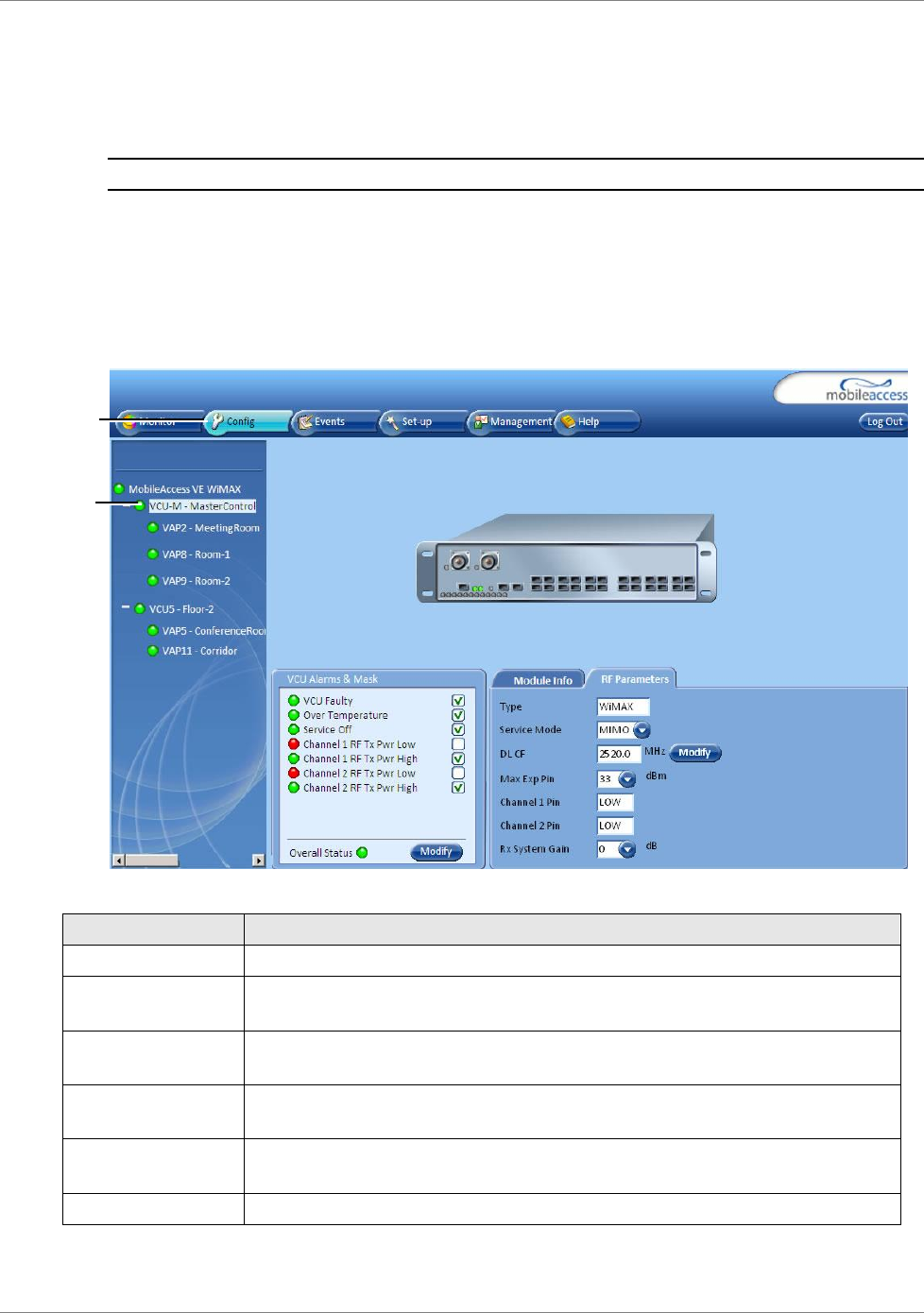
Master VCU RF Parameters
52 MobileAccessVE WiMAX Instant Coverage Solution User Manual
6.3 Master VCU RF Parameters
Note: The RF parameters are not displayed for control units functioning as Slave VCUs.
To access the RF Parameters tab
Click the Config tab from the main menu bar and then select the Master control unit from the
network topology and click the RF Parameters tab. The parameters displayed in RF Parameters
tabs correspond to the selected element. The displayed parameters are similar for MIMO and
SISO service modes, however in SISO mode only the
Channel 1 Pin
parameter is displayed.
The following table provides a description of the RF parameters displayed in the MIMO RF tab.
Parameter
Description
Type
Set (read only) according to unit type (WiMAX)
Service Mode
Provides the service options: MIMO/SISO. The selected option determines
the displayed RF parameters.
DL CF*
Center frequency (from BS). User defined according to WiMAX range. The
CF is the same for both UL and DL signals.
Max Exp Pin*
Maximum expected input power from the BS. Used for adjustment
procedure. Range: 0-33 dBm. User defined.
Channel1/ Channel
2 Pin
Actual measured Pin (read only). In SISO mode only Channel 1 Pin is
relevant.
Rx System Gain
Used for adjusting the UL system gain. Range: -15 dB to +5 dB
* Required parameters to be provisioned by the user.
Selected
Master VCU
Config tab
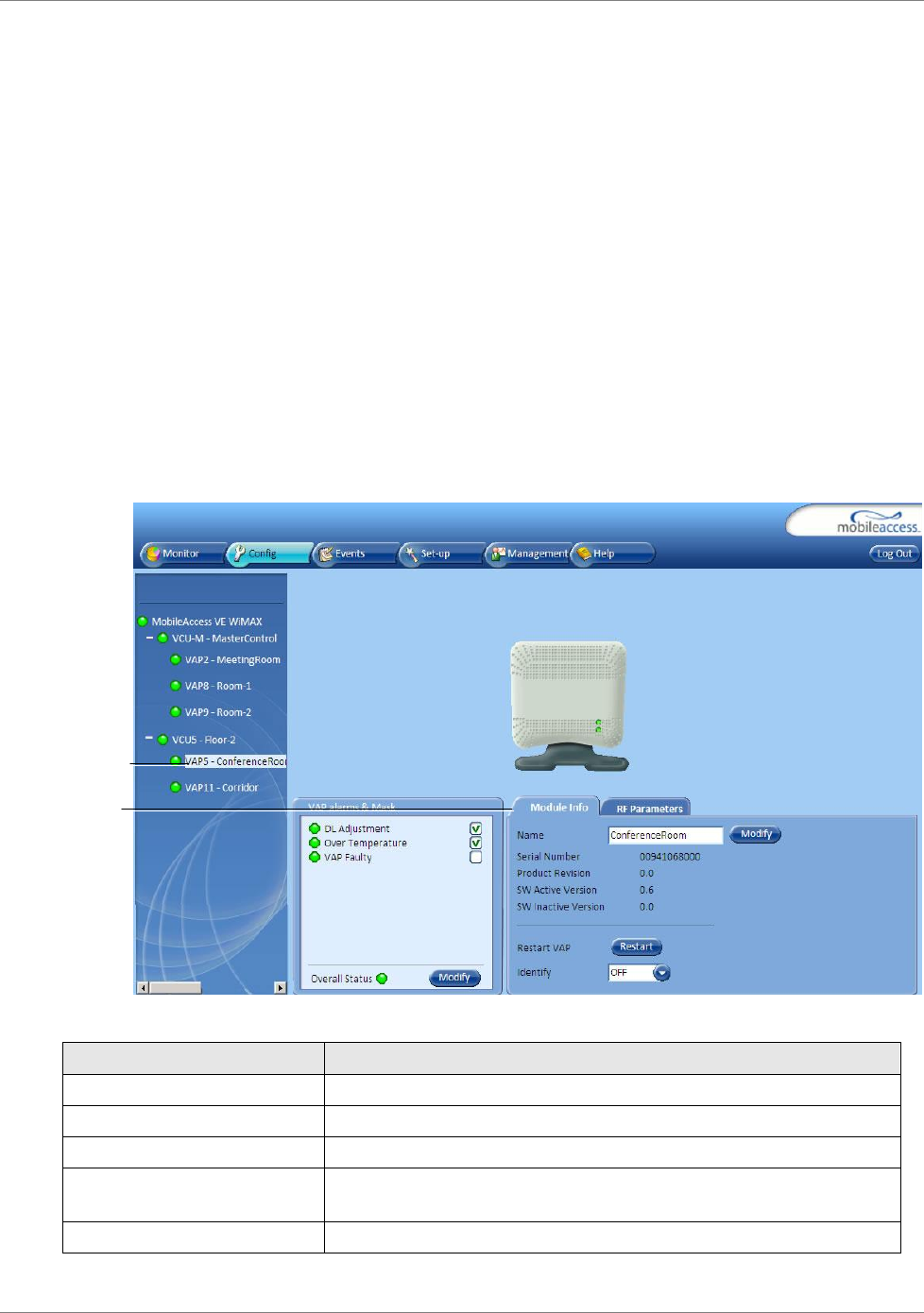
VAP Monitoring and Configuration
MobileAccessVE WiMAX Instant Coverage Solution User Manual 53
7 VAP Monitoring and Configuration
7.1 Viewing VAP General Information
The VAPs general information (such as unit name and SW versions) can be viewed in the Config
Module Info sub-tab.
The tab includes two additional options:
Identify button - Enabling this option enables finding the physical location of the selected
element. When this option is set to ON, the LEDs on the corresponding VAP flickers.
Reset button - SW reset of the unit
To view VAP general information
Click the Config tab from the main menu and select the VAP from the network topology tree.
The Module Info sub-tab is displayed by default.
The following information is displayed:
Field
Description
Name
User defined name for system element (up to 17 characters)
Serial Number
Factory set ID number
Product Revision
Revision number of VCU/VAP
SW Active Version
Version of the SW currently being used to manage and monitor
the system
SW Inactive Version
Version of other system SW version not in use
Selected
VAP
Module Info
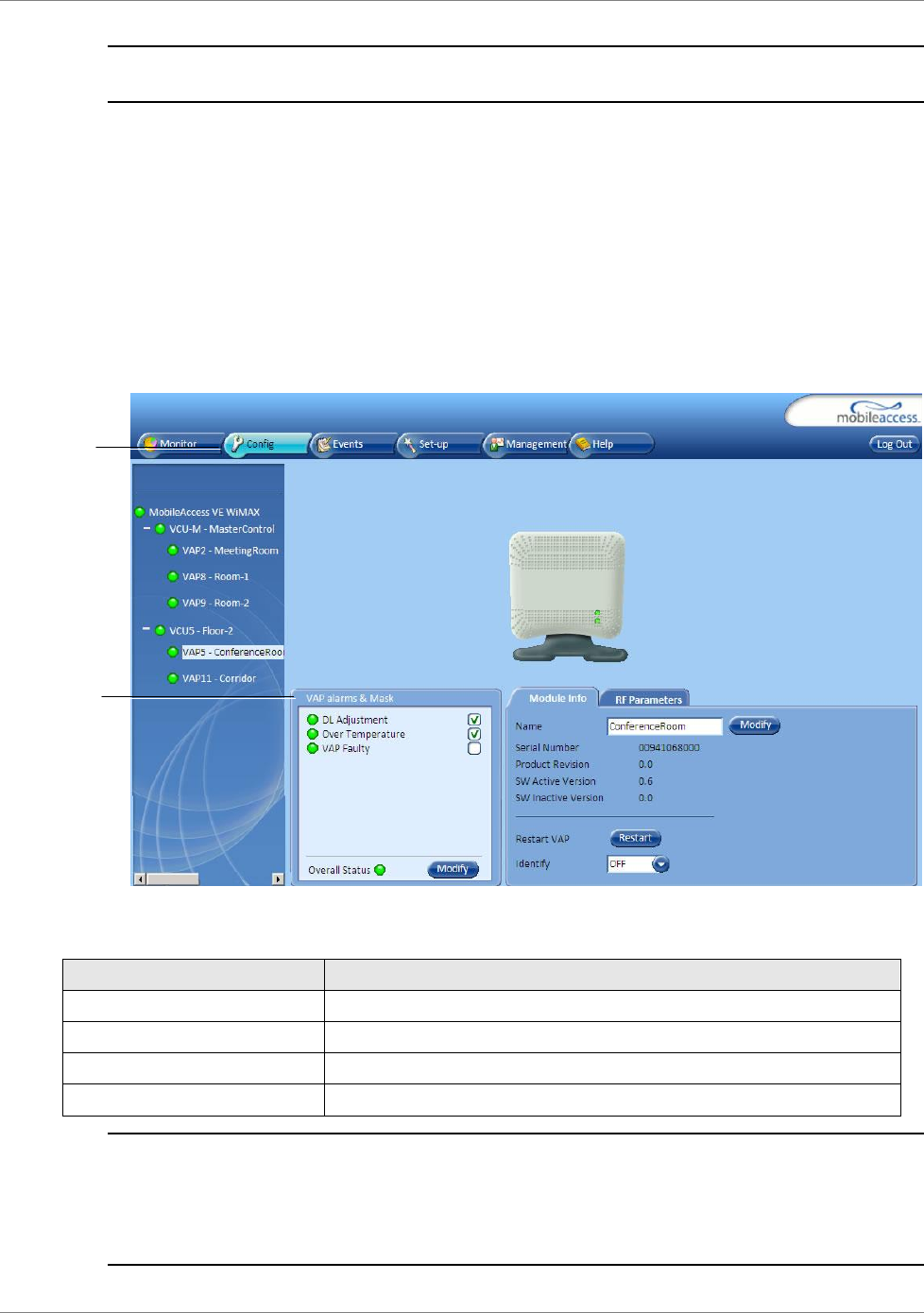
Viewing VAP Alarms
54 MobileAccessVE WiMAX Instant Coverage Solution User Manual
Note: VAP name is saved in the VCU associated to the port to which the VAP is connected, such
that in case you replace a VAP, the new one will be associated with the same name.
7.2 Viewing VAP Alarms
When a VAP element is selected in the topology tree, the Alarm tab displays the main alarms in
the unit.
To access VAP Alarms Tab
In the Topology Tree, click the VAP, click the Config(uration) tab in the menu bar located at
the top of the window and click the VAP Alarms sub tab.
If one or more alarms occur, the corresponding Status indicator is illuminated in RED. If the VAP
is OK and no fault occurs, the Overall Status indicator will show GREEN.
Alarm
Description
Adjustment
RED - Cable (between VCU to VAP) is too long (over 100m/300ft)
VAP Faulty
RED - A fault has been detected in the VAP
Overall temperature
RED - Temperature of unit exceeds normal range
Overall status
Indicates Fault (RED) level or GREEN if there are no faults
Note: Adjustment alarm is raised when VAP is connected over a cable exceeding system cable
length limitation. In such case the system continues to provide the wireless services but you
should check the coverage of the VAP (as output power may be degraded due to excess cable
loss) and check the Ethernet connection (as Ethernet standard maximum cable length is
probably exceeded).
Config tab
VAP alarms
sub-tab
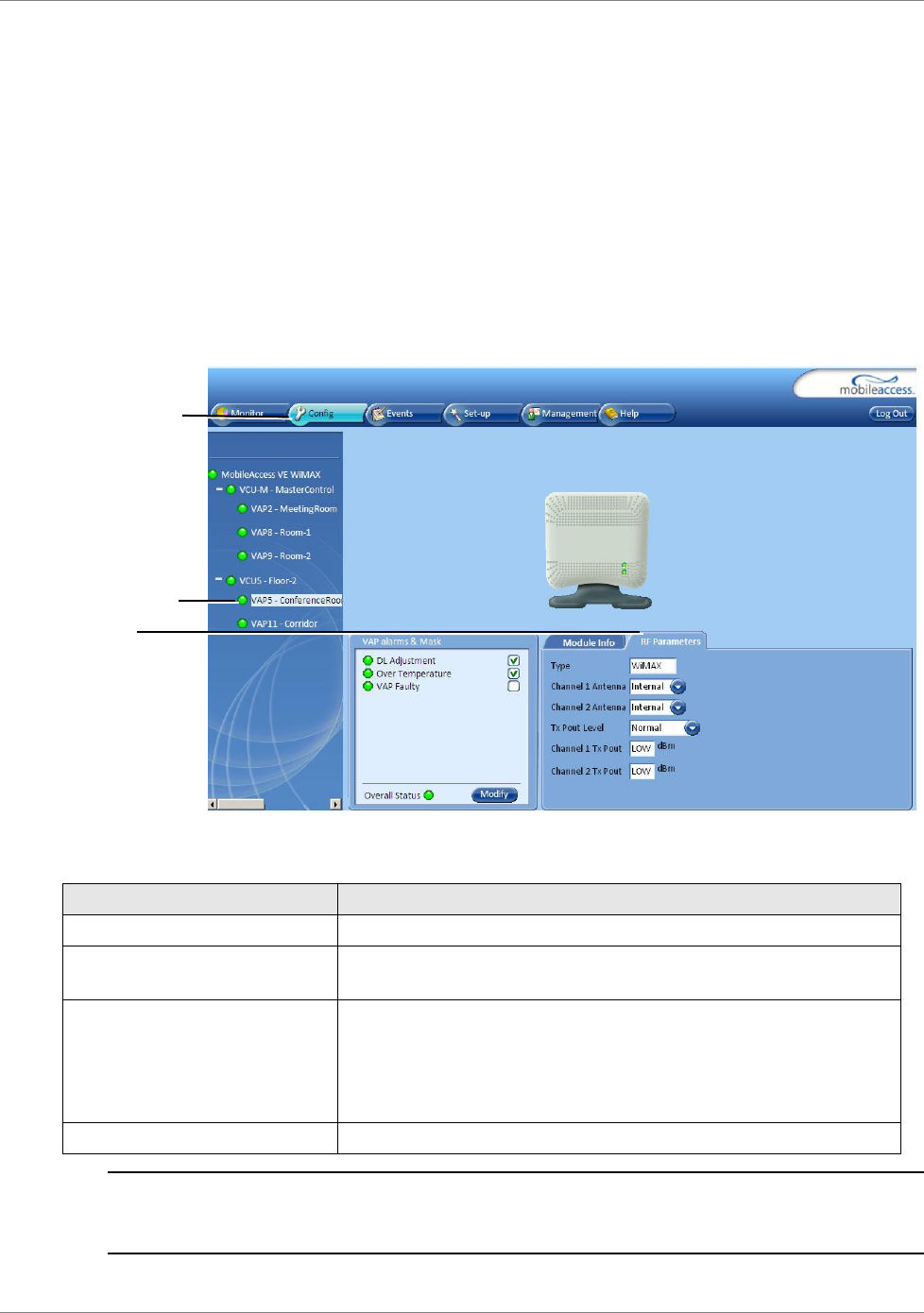
VAP Monitoring and Configuration
MobileAccessVE WiMAX Instant Coverage Solution User Manual 55
7.3 VAP RF Parameters
The VAP RF Parameters sub-tab provides the configurable RF parameters corresponding to the
VAP element selected in the network topology tree. The displayed RF parameters are similar for
both MIMO and SISO service modes (in SISO service mode only Channel 1 parameters are
displayed).
To view the VAP RF Parameters
Click the Config tab from the main menu bar and then select the VAP from the network
topology and click the
RF Parameters
sub-tab. The parameters displayed in RF tab correspond to
the selected element.
The following table provides a description of the displayed VAP RF parameters (in SISO service
mode, only Channel 1 parameters are displayed).
Parameter
Description
Type
Set according to unit type (WiMAX)
Channel 1/ Channel 2 Antenna
Select External only if an external antenna is connected to this
VAP. Otherwise, the option should be set to Internal (default).
Tx Pout Level
Level of from BS side.
Normal = output power will be at required (normal) level
Low = output power will be attenuated by 5 dB less than the
required level. This option can be used for smaller coverage
areas that do not require the full power of the VAP for coverage.
Channel 1/ Channel 2 Tx Pout
Measured output power.
Note: VAP RF settings (Service Mode, DL Pout Level, Antenna) are saved in the VCU associated
to the port to which the VAP is connected, such that in case you replace a VAP all parameters
are automatically set to the new VAP.
Selected VAP
Config tab
RF
Parameters
sub-tab
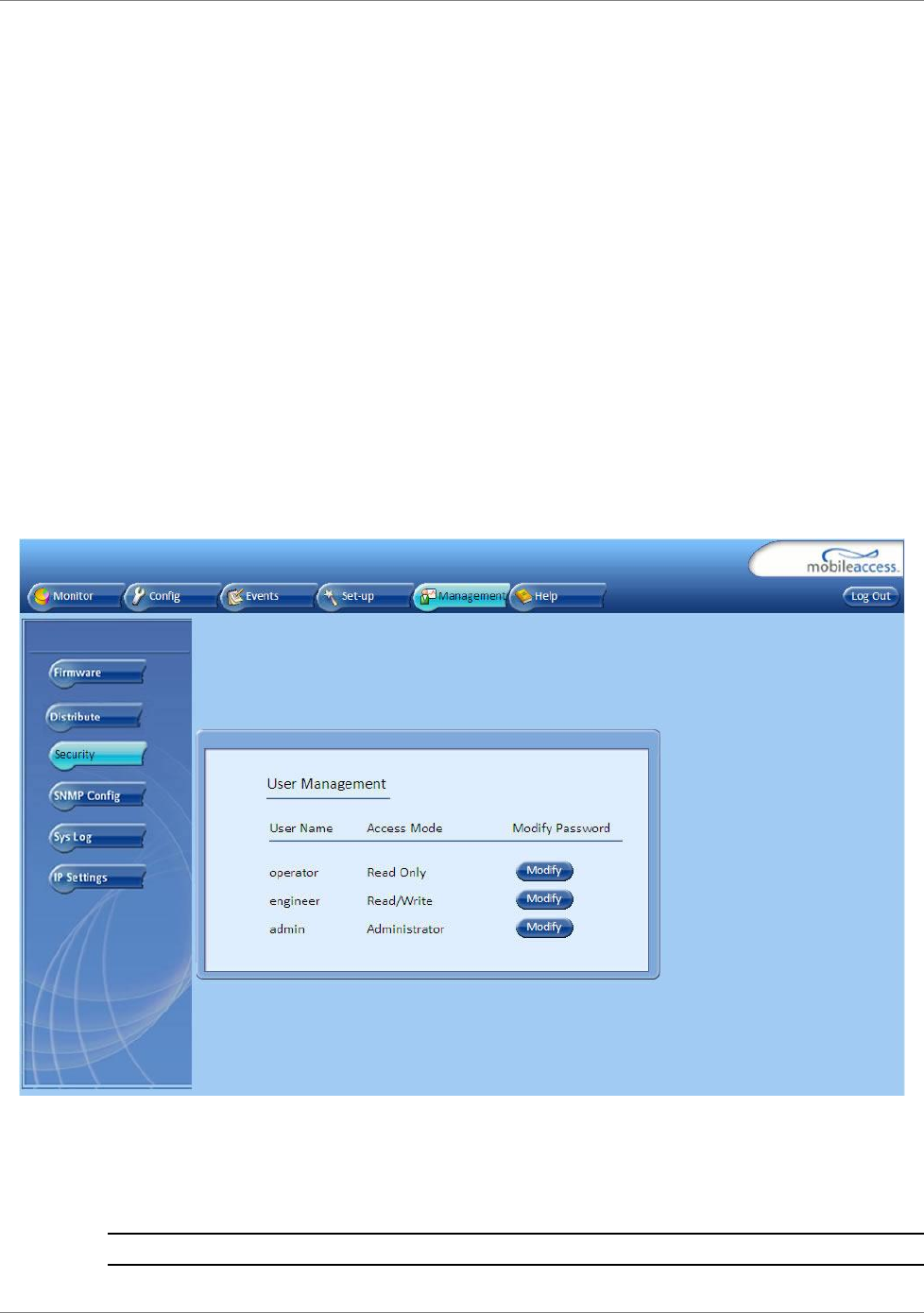
Changing Password
56 MobileAccessVE WiMAX Instant Coverage Solution User Manual
8 Administrative Operations
This chapter describes the following Administrative operations:
Changing password
IP configuration parameters
SNMP Configuration parameters
Unit software upgrade and software management procedures
8.1 Changing Password
The Management - Security tab provides password change options.
To set the application password or change an existing password
1. Select the Security option of the Management tab at the top of the window.
2. Click the Modify (Password) button of the User Name whose password is to be modified.
3. Enter the New Password and re-enter in the Confirm New Password field.
4. Click OK.
Note: Only when connected as an administrator you can change the passwords.
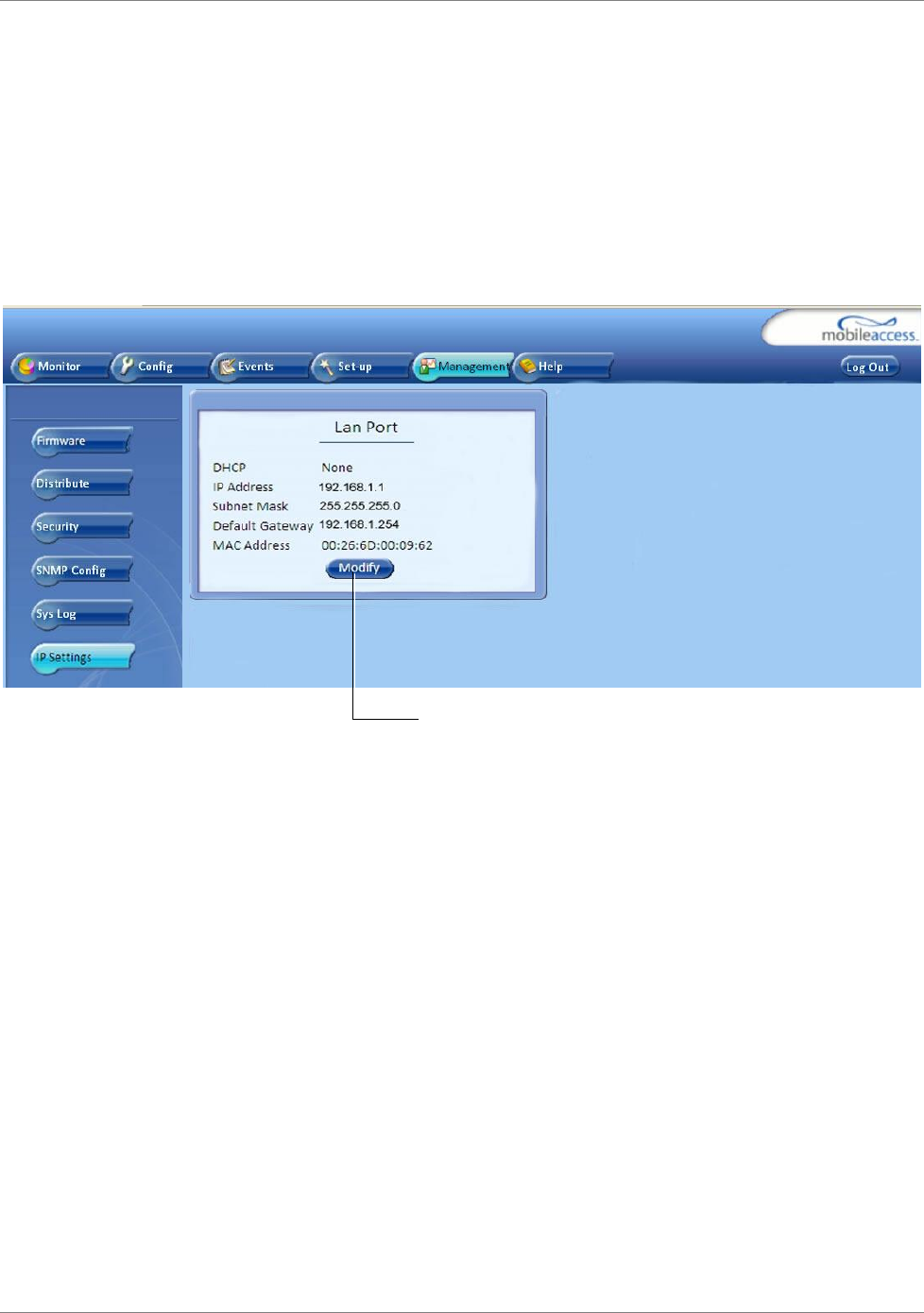
Administrative Operations
MobileAccessVE WiMAX Instant Coverage Solution User Manual 57
8.2 IP settings
The IP Settings tab is used for viewing and modifying the network parameters. The default
parameter settings are as follows:
IP Address: 192.168.1.1
Subnet Mask: 255.255.255.0
Default Gateway: 192.168.1.254
Click Modify button to
change settings

SNMP Configuration Parameters
58 MobileAccessVE WiMAX Instant Coverage Solution User Manual
8.3 SNMP Configuration Parameters
The SNMP Config tab is used for defining the SNMP communities that the devices and
management station belongs to and to where the traps are sent. The SNMP default communities
are:
Read=public
Write=private
The Community Names can be modified by clicking the Modify button in the SNMP
Configuration display area.
Additional Trap Destinations can be added by clicking the Add New button in the Trap
Destination List display area:

Administrative Operations
MobileAccessVE WiMAX Instant Coverage Solution User Manual 59
8.4 Upgrading (or Downgrading) VCU and VAP Software
NOTE: Before you start, verify that the VCU and VAPs upgrade file(s) are located in an accessible
location (i.e. on your computer).
The software for each VCU and its hosted VAPs can be upgraded through access to the VCU.
Note: In installations with Slave VCUs, a session shall be opened to the IP address of the Slave
VCU in order to upgrade the SW of the Slave VCU and associated VAPs.
Two types of files are stored on the VCU and on individual VAPs: Active software on which the
unit operates, and Standby software. The Active and Standby software can be swapped on each
individual unit.
In addition, the VCU holds two software images for VAPs – to be used in download process to
VAPs.
The upgrade procedure consists of the following main phases:
1. Uploading the new VCU and VAP software to the host VCU.
2. Setting the new software as the Active software.
3. Activating the new VCU software on the VCU.
4. Downloading the new software to selected VAPs and activating it as the Active software on
those VAPs.
The procedure is performed via two screens:
Firmware screen – used to manage the software files stored on the VCU.
Distribute screen – used to download the VAP software version to selected VAPs.
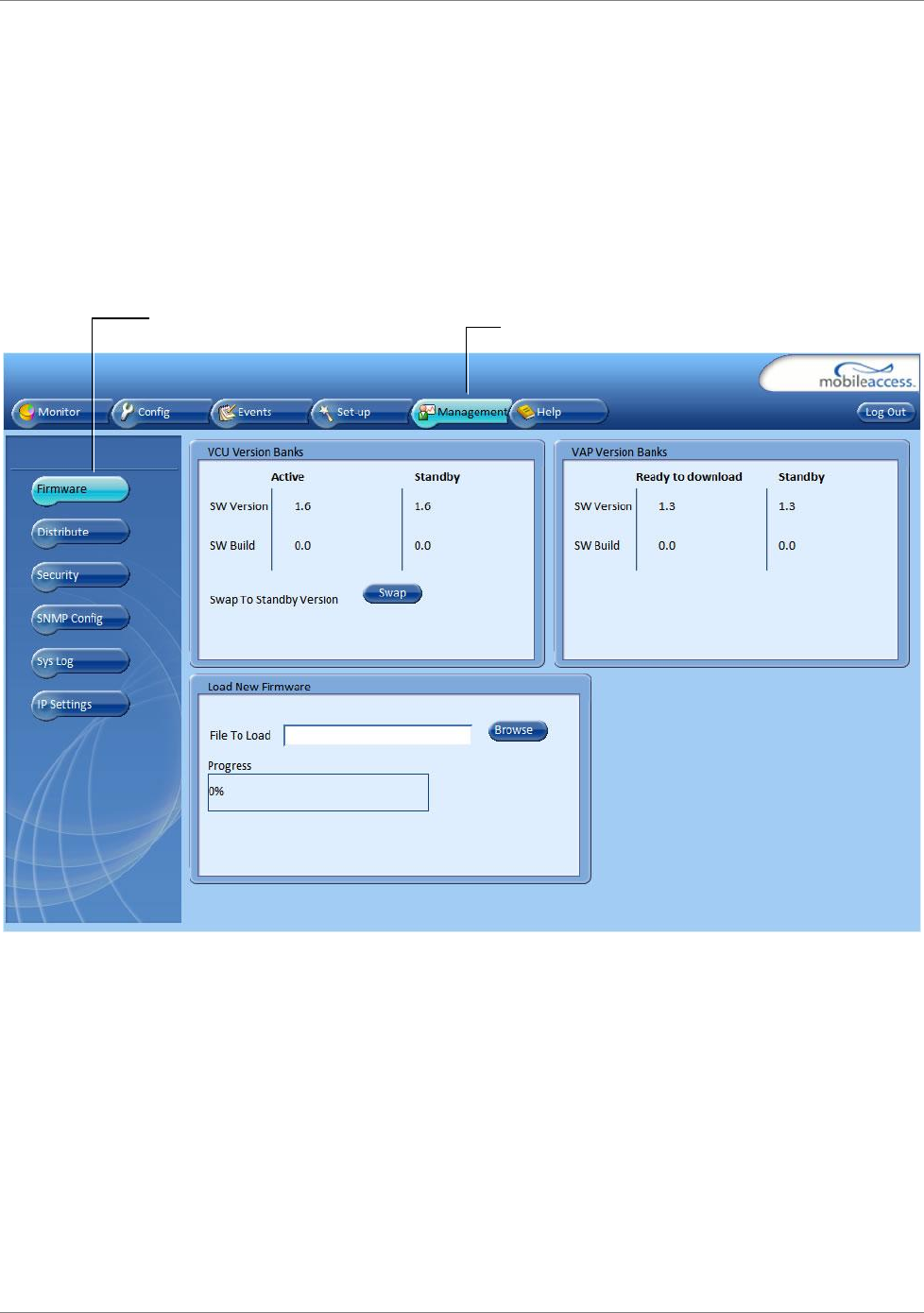
Upgrading (or Downgrading) VCU and VAP Software
60 MobileAccessVE WiMAX Instant Coverage Solution User Manual
8.4.1 Upgrading the VCU SW
To Upgrade the VCU SW Version:
1. Upload the VCU upgrade files from your storage location (i.e. computer) to the VCU as
follows:
Click the Management menu tab and then click the Firmware sub-menu option (left
side).
In the Load New Firmware display area, click the Browse button.
Select the file to be loaded (from your computer location). The Download button
appears and the progress bar will show the download status.
After download is complete the downloaded SW version will appear in the Standby Bank
column of the VCU display area.
2. Define the downloaded version as the Active version (to be used for upgrade) as follows:
(In the VCU display area), click Swap. The downloaded version appears in the Active
Bank column and the Controller is automatically restarted.
The VCU Upgrade procedure is complete.
Management tab
Firmware sub- tab
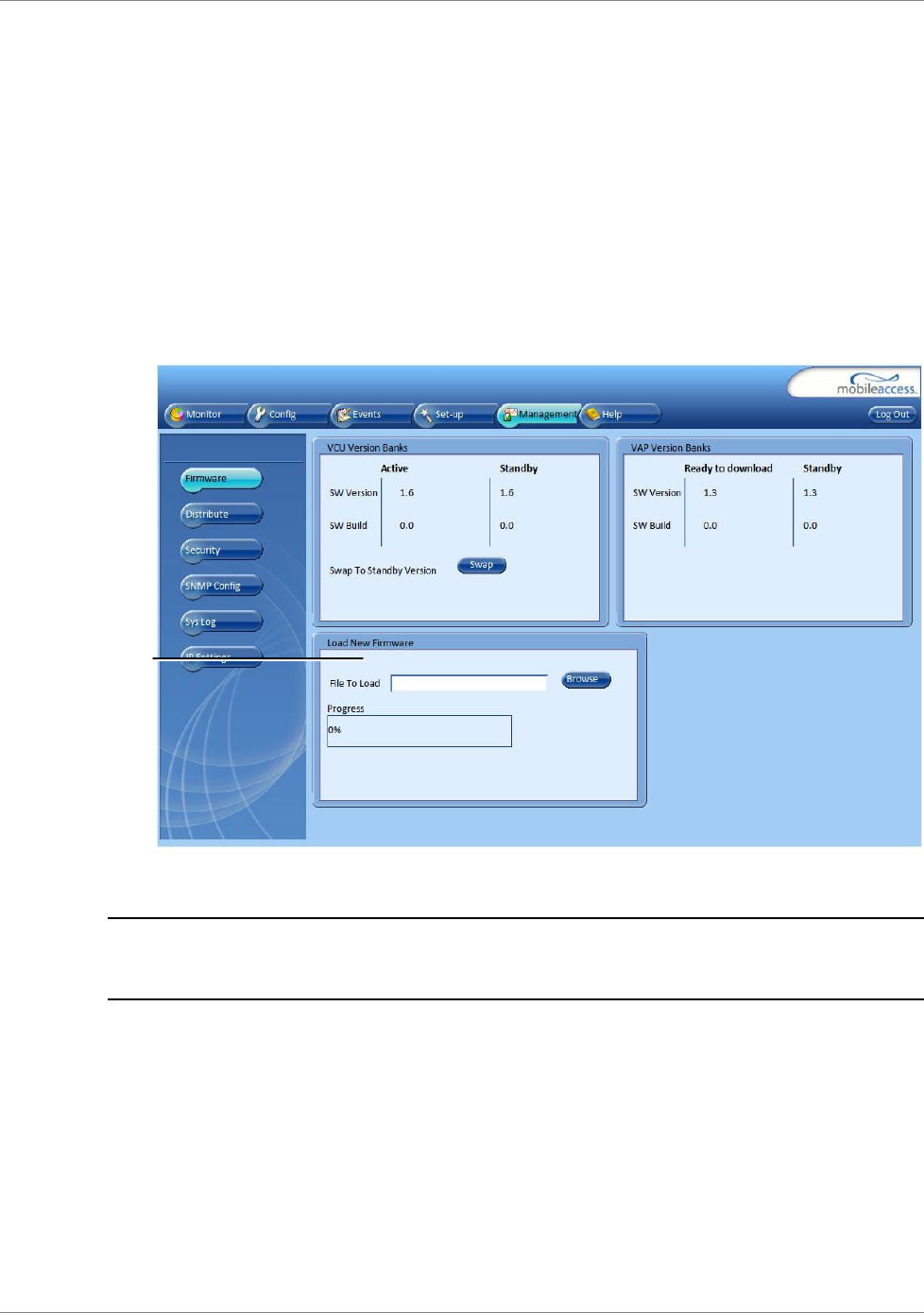
Administrative Operations
MobileAccessVE WiMAX Instant Coverage Solution User Manual 61
8.4.2 Upgrading the VAP SW
To Upgrade the VAPs SW Version:
1. Upload the VAP upgrade files from your storage location (i.e. computer) to the VCU as
follows:
Click the Management menu tab and then click the Firmware sub-menu option (left
side).
In the Load New Firmware display area, click the Browse button.
Browse for the file to be loaded (from your computer location). The Download button
appears and the progress bar will show the download status.
After the download is complete, the downloaded SW version will appear in the Standby
Bank column of the VAP display area.
Notes:
1. Locate the Firmware files on your local hard-drive prior to the download process.
2. During the download process DO NOT disconnect the Web GUI connection to the VCU.
Load New
Firmware display
area
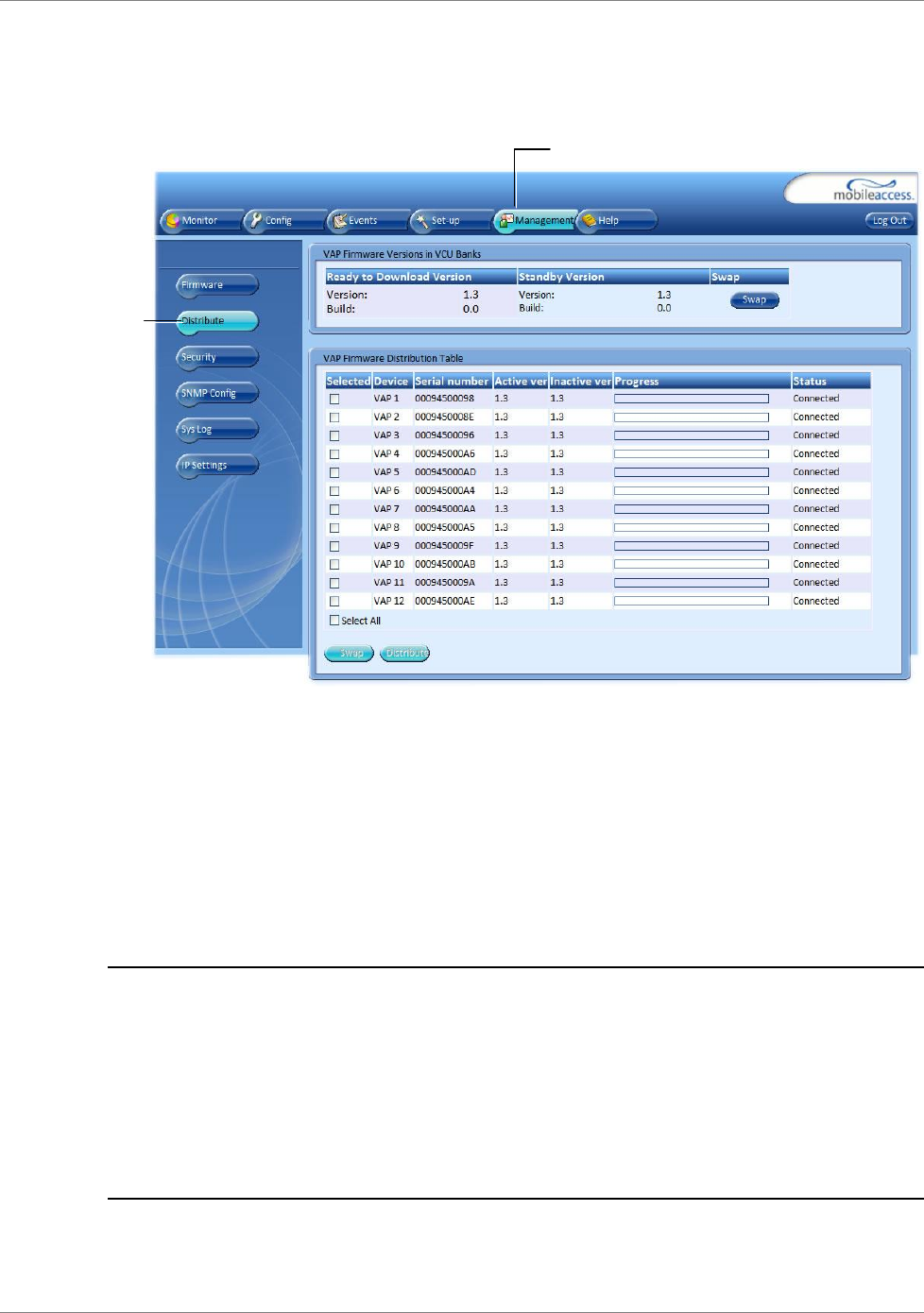
Upgrading (or Downgrading) VCU and VAP Software
62 MobileAccessVE WiMAX Instant Coverage Solution User Manual
2. To distribute the new software to selected VAPs:
Click the Distribute sub-menu option (left side).
3. Download the new version to the selected VAPs (where the downloaded version is stored as
Inactive in the VAPs until a Swap procedure is performed):
In the VAP Distribute Table display area, checkmark the VAPs to be upgraded. (The
Active and Inactive SW versions for each VAP are listed in the relevant columns).
Click the Distribute button to download the new software to the selected VAPs. The
software is stored as the Inactive version in the VAPs.
Set the new software as the Active version in the selected VAPs by clicking the Swap
button.
The VAP upgrade procedure is complete.
Notes:
1. As during the distribution process service may be interrupted, it is advised to perform the SW
download and distribution in a maintenance window schedule to off-peak hours (e.g. during
the night).
2. During the distribution process DO NOT perform configuration changes, DO NOT connect or
disconnect VAPs and do not disconnect the web GUI.
3. After the distribution process is complete and after swapping between VAP SW images, the
VCU will restart automatically. After restart, the VAP firmware distribution table will be empty
and it will be re-populated within several seconds as the VCU re-discovers connected VAPs.
Management tab
Distribute sub-
tab
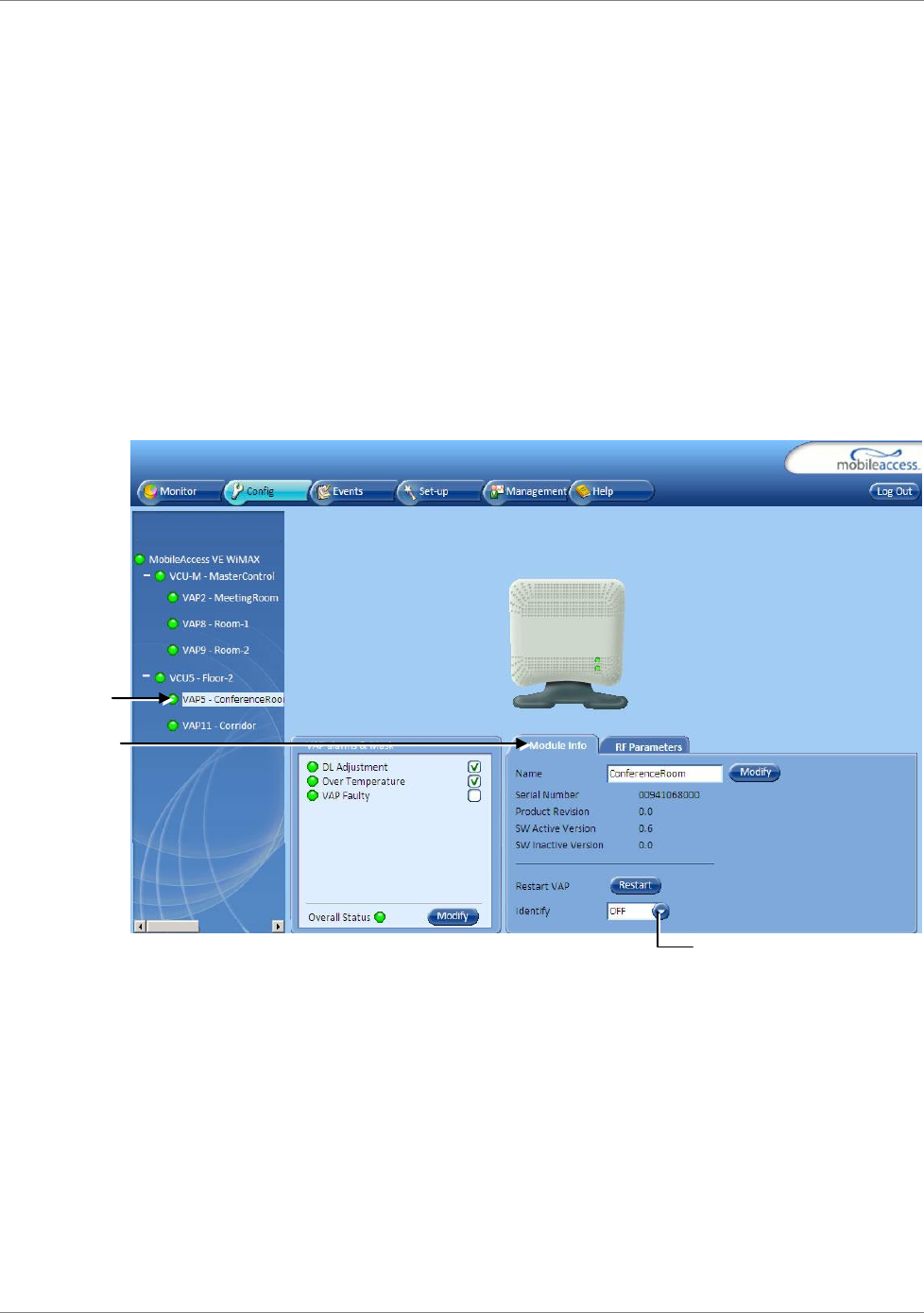
Troubleshooting
MobileAccessVE WiMAX Instant Coverage Solution User Manual 63
9 Troubleshooting
9.1 Finding a Specific VAP in the Building
It is recommended to assign each VAP an identifiable name corresponding to its physical location
as explained in section 4.3.2. If a name was not configured, or for some other reason a specific
VAP cannot be physically located, identify the VAP according to the instructions in the following
example.
To locate a VAP
1. Click the Config tab from the main menu bar and select the VAP to be located from the
topology tree.
2. Click the Module Info sub-tab.
3. Set Identify to ON.
Selected VAP
Identify On/Off
Module Info
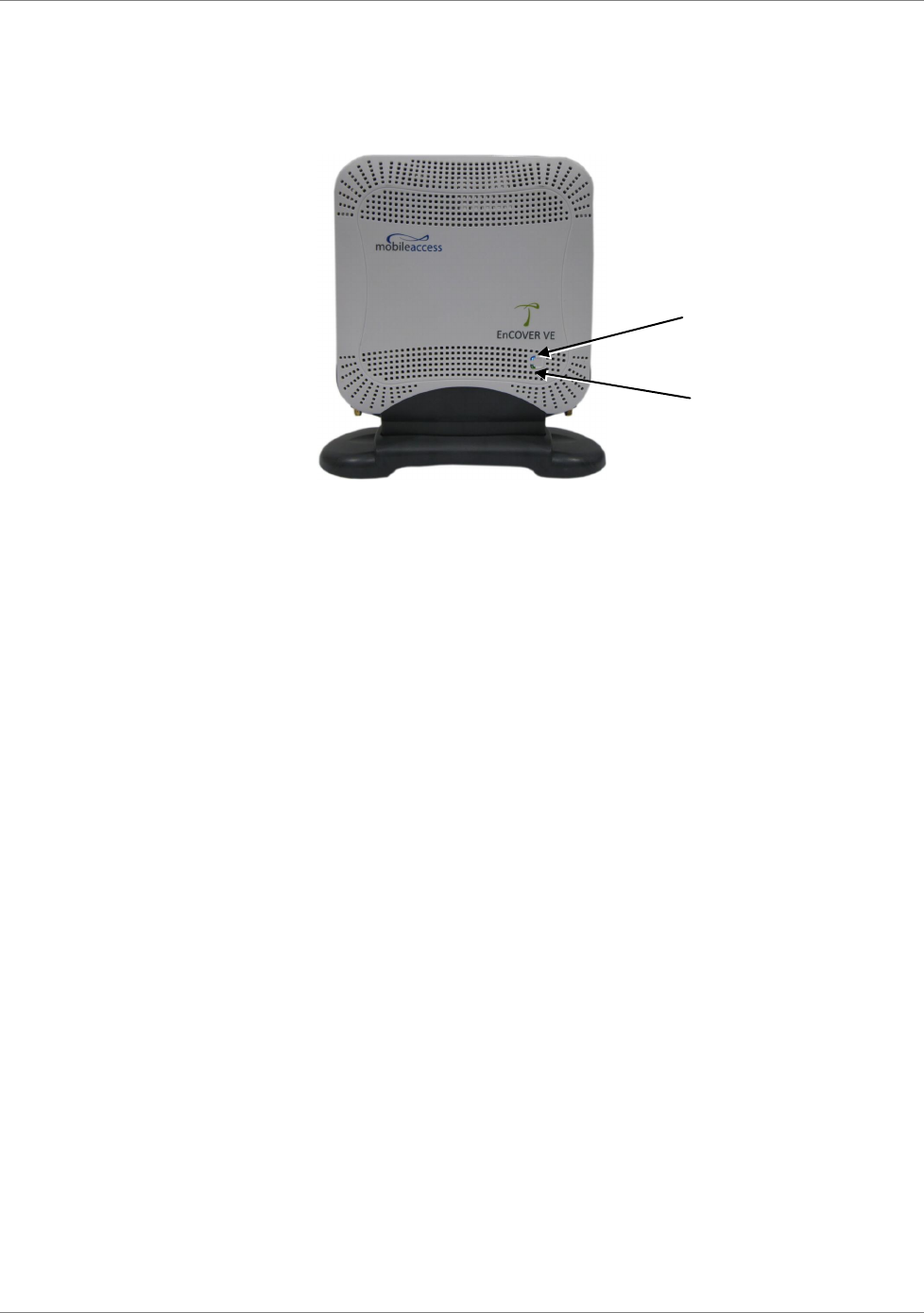
Finding a Specific VAP in the Building
64 MobileAccessVE WiMAX Instant Coverage Solution User Manual
The Activity LED (Blue) on the corresponding Access Pod will start blinking fast. (You will
need to physically locate the VAP to see the blinking LED).
4. Locate the Access Pod.
5. Once found – it is advisable to assign it an identifiable name via the VAP Module Info sub-
tab as described in section 4.3.2 (e.g. floor 3, room 2) and set the Identify field to Off
again.
Blue LED (Activity)
Green LED (PWR)
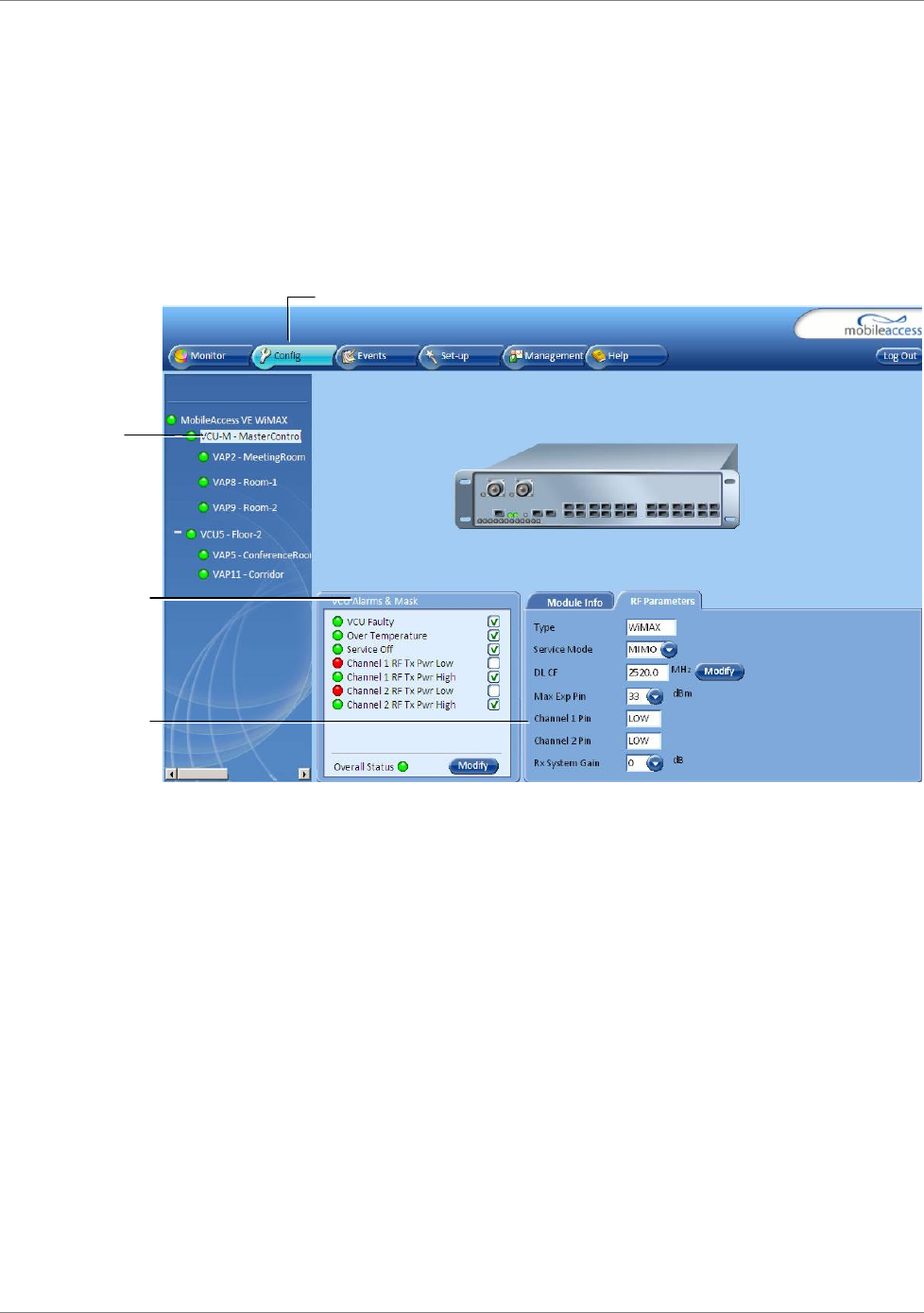
Troubleshooting
MobileAccessVE WiMAX Instant Coverage Solution User Manual 65
9.2 Wireless Service is Not Available
1. Verify that the Master VCU is connected to the BS, powered up and configured.
2. Verify that the Max Expected Power setting is correct by either:
A) Viewing the actual VCU Power Measurement (Channel 1/Channel 2 Pin) in the VCU
RF Parameters sub-tab (see below).
B) or by measuring the actual BS output using a Spectrum Analyzer.
3. Verify correct settings of center frequency and system gain (see DL CF and Rx System
Gain parameters in RF Parameters sub-tab – see example displayed above).
4. Verify that the RF cables are properly connected to the VCU.
5. View the VCU Alarms (above image) and verify that the VCU is working properly.
Config tab
VCU Alarms and
Mask
Channel 1/
Channel 2 Pin
Selected VCU
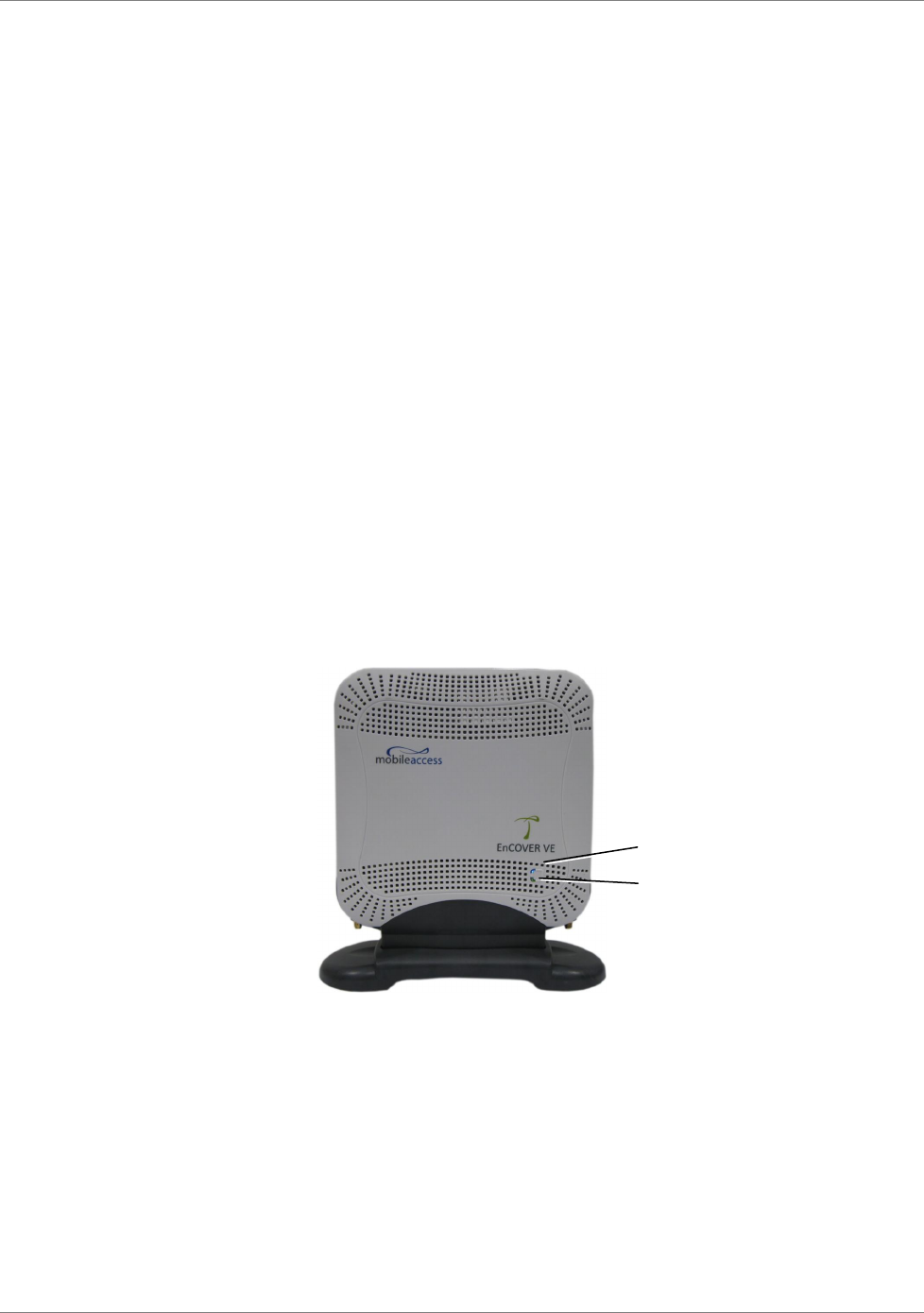
Ethernet service is degraded
66 MobileAccessVE WiMAX Instant Coverage Solution User Manual
9.3 Ethernet service is degraded
Ethernet standards specify that 100m (300ft) is the maximum distance between an Ethernet
switch and appliance (computer, WLAN AP etc). This is relevant when MobileAccessVE shares
the IT LAN. The distance includes all patch cords (from switch to VCU, from VCU to patch panel,
from RJ-45 outlet to VAP, and from VAP to appliance).
1. Review the IT documentation (may be available from your IT department) to determine
cable types and lengths.
2. Check the lengths of the patch cords being used and verify the end-to-end distance does not
exceed 100m (300ft).
3. A Fluke cable tester can be used to measure cable length.
9.4 No Service from Connected Access Pod
This requires physically accessing the Access Pod to check the LEDs, and accessing the Access
Pod through the Web GUI to verify the Access Pod configuration.
1. Physically view the Access Pod and confirm that both LEDs on the Access Pod are lit:
Power LED (Green) is OFF – either no connectivity to the VCU or the VAP is faulty. Try
replacing the VAP. Try connecting the VAP directly to the VCU – if the Power LED is lit
check the cable and the patch cords.
Activity LED is constantly blinking – the Access Pod cannot initialize due to exceeded
cable length. Try using the closest free RJ-45 jack fed with a different cable.
2. Check other Access Pods connected to the same VCU.
3. Verify that the VAP configuration as follows:
Connect to the VCU using the MobileAccessVE Web GUI application (see 5.1).
In the VCU Config tab, click the RF Parameters sub-tab and verify that the Service
Mode parameter is set (MIMO/SISO).
Activity – Blue LED
Pwr – Green LED
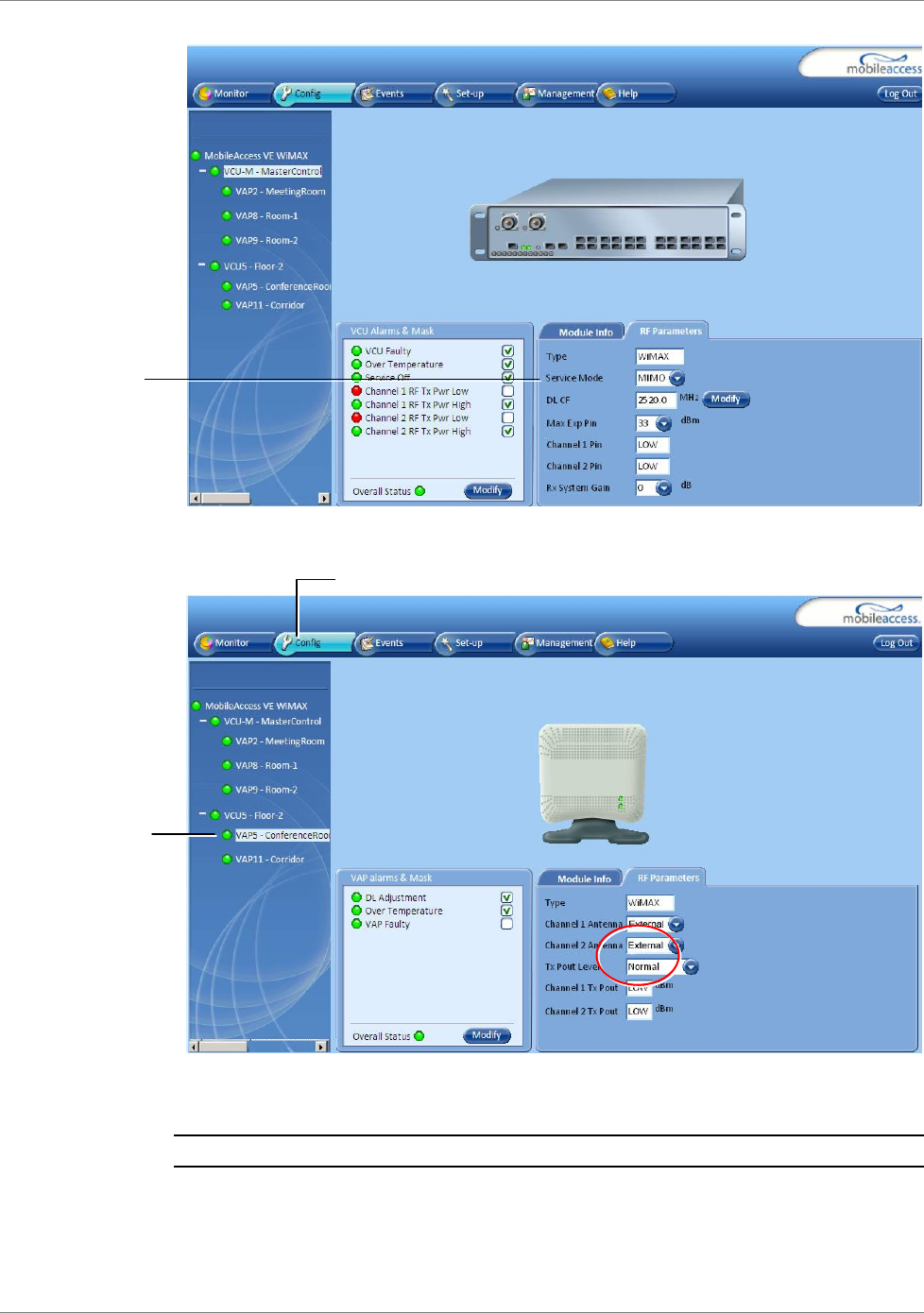
Troubleshooting
MobileAccessVE WiMAX Instant Coverage Solution User Manual 67
Select the VAP from the topology tree and click the RF Parameters sub-tab.
Confirm that the VCU port is functioning (VAP status LED - top LED in VAP icon
associated with this Pod is green).
Note: The
Activity
LED on the actual VAP is BLUE.
In case external antennas are connected – verify the VAP was configured to use the
external
antennas (see Channel 1/ Channel 2 Antenna parameter in RF Parameters
sub-tab, shown in previous figure).
Service Mode
(MIMO/SISO)
Config tab
Selected
VAP
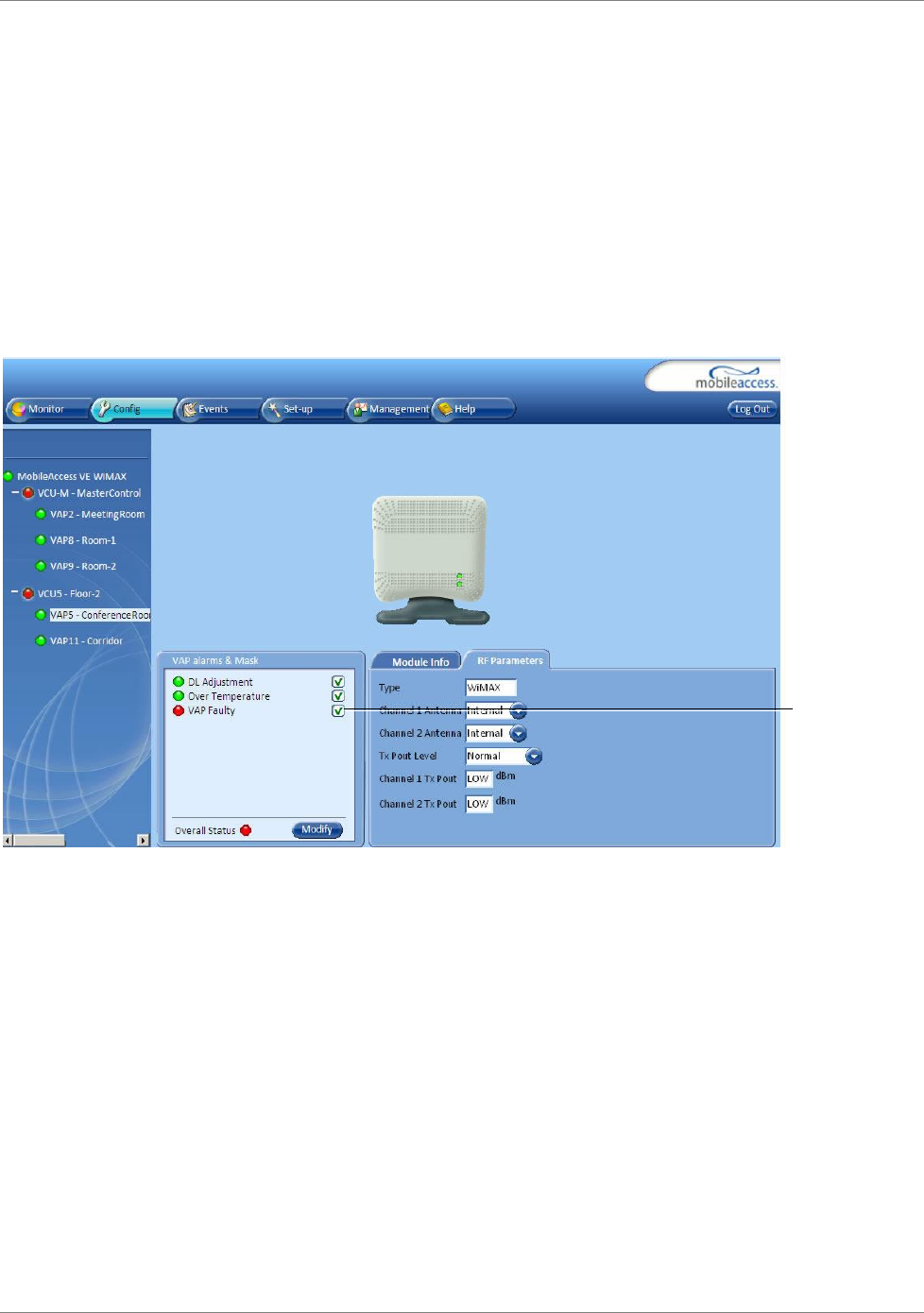
VCU Cannot be monitored via SNMP
68 MobileAccessVE WiMAX Instant Coverage Solution User Manual
9.5 VCU Cannot be monitored via SNMP
VE traps are not received by the external Fault Monitoring system.
1. Verify that the VCU is powered ON.
2. Verify that the SNMP traps destination address is configured correctly.
3. Verify the IP connectivity to the Fault Monitoring server using “ping.”
4. Verify that SNMP port is not blocked or fire-walled in the IP network.
5. Initiate an Alarm and confirm the trap is received by external Fault Monitoring server. For
example:
Access the VAP RF Parameters sub-tab (see section 7.3).
Verify that the alarm is unmasked (for example, VAP faulty alarm).
Disconnect the selected VAP.
Confirm the trap is received by external Fault Monitoring server.
Unmasked VAP
Faulty alarm

MobileAccessVE WiMAX Instant Coverage Solution User Manual 69
Appendices
Traps
This section lists the MobileAccessVE WiMAX Controller and Access Pod traps
MobileAccessVE Control Unit Traps
No
Trap Name
Trap Description
1
vcuChannel_1_DLPowerLow
Input RF power (from BS) is lower by 15dBm (or more) from the
Max Expected Pin, or is lower than -3dBm (or no signal).
2
vcuChannel_1_DLPowerHigh
Input power exceeds the maximum expected Pin by more than
3dBm.
3
vcuChannel_1_ServiceOff
Service is off
4
vcuChannel_2_DLPowerLow
Input RF power (from BS) is lower by 15dBm (or more) from the
Max Expected Pin, or is lower than -3dBm (or no signal).
5
vcuChannel_2_DLPowerHigh
Input power exceeds the maximum expected Pin by more than
3dBm.
6
vcuChannel_2_ServiceOff
Service is off
7
vcuFaulty
VCU HW is faulty
8
vcuOverTemperature
Temperature is above threshold
9
vcuAdjustment
When adjustment (for Slave VCU) has failed (cable too long)
10
vcuMismatchType
VCU service is different than VAP services
MobileAccessVE Access Pod Traps
No
Trap Name
Trap Description
1
vapAdjustment
When adjustment (for VAP) has failed (cable too long)
2
vapFaulty
when VAP HW is faulty
3
vapOverTemperature
when temperature is above threshold
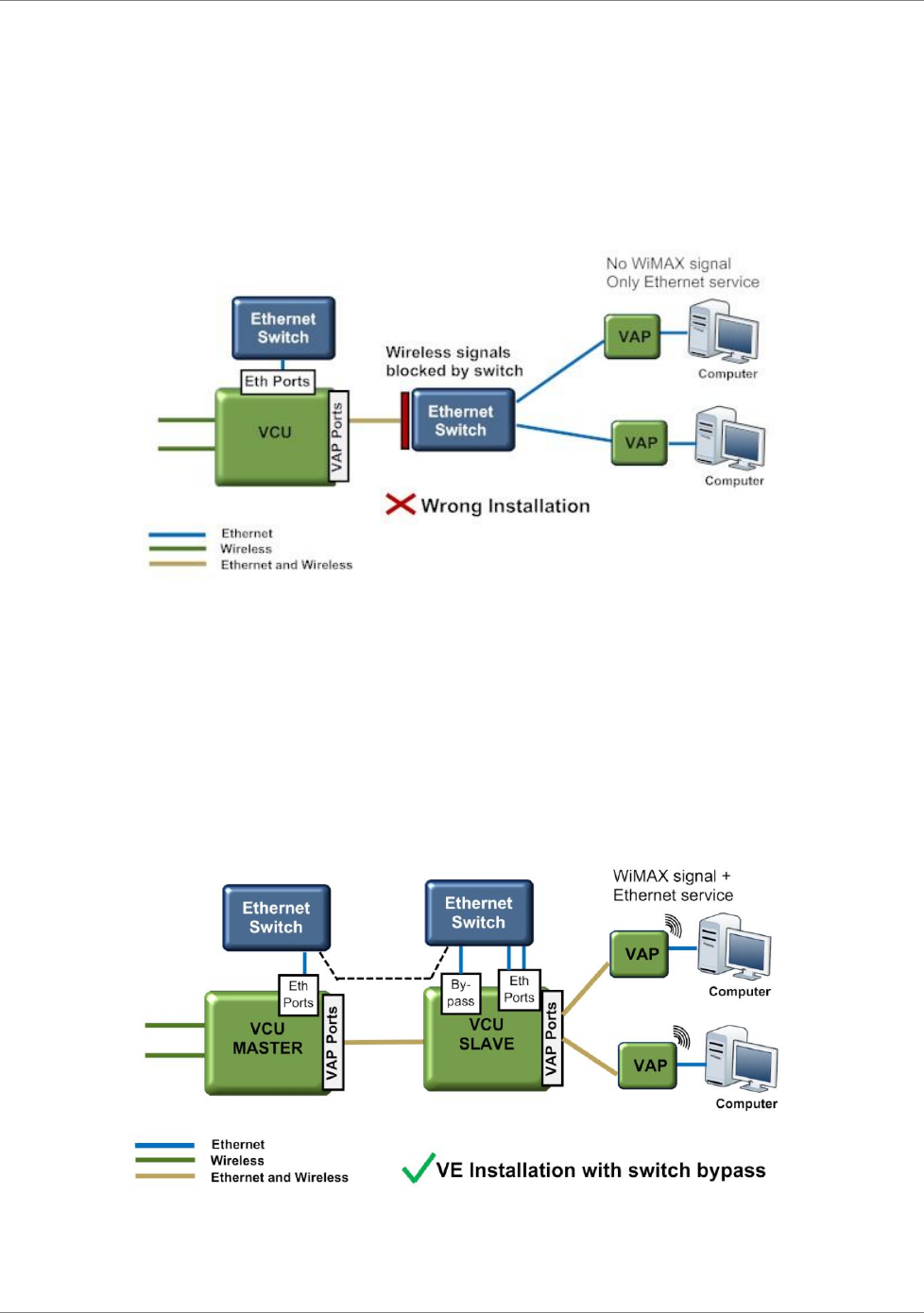
VE Connections in Central Ethernet Source Topologies
70 MobileAccessVE WiMAX Instant Coverage Solution User Manual
VE Connections in Central Ethernet Source Topologies
This section describes the VE site installation for sites whose Ethernet services are provided from
a single Ethernet source in the communication room and distributed throughout the site by
daisy-chaining Ethernet switches from the central source.
In VE installation, any switch located in the path between the VCU and the VAPs will block the
wireless signals:
The Bypass option allows bypassing the switch by enabling the transport of Ethernet signals over
the cable connecting the Master VCU to the slave VCU. (In a typical VE the cable between the
Master and Slave VCUs is a dedicated CAT-6/7 cable used only for VE).
The Ethernet signals are combined with the wireless signals at the master VCU, separated at the
slave VCU and connected via the Bypass port to the switch.
The wireless signals are then re-combined by the slave VCU with the Ethernet signals (from the
Ethernet Switch Ports) and transported to the VAPs and connected PCs.
